- Best Time to Visit
- Weather & Climate
- Airports in Chile
- Best Santiago Hotels
- One-Week Itinerary for Chile
- Best Places to Visit in Chile
- Beach Destinations
- Top National Parks
- Guide to Chilean Patagonia
- Guide to Valparaiso
- Guide to Vina del Mar
- Best Wineries in Chile
- Things to Do in Chile
- Things to Do in Santiago
- Must-Try Food
- Search Please fill out this field.
- Newsletters
- Destinations
- Central & South America

10 Foods You Have to Try in Chile
LarisaBlinova / Getty Images
Chile, a country with an insanely long coastline, unsurprisingly has a cuisine with an emphasis on fish and seafood plates. The nation also has a love affair with corn, using it in everything from soups to savory pies. Mapuche, Chono, Araucanian, and Spanish recipes and influences have all combined to create flavors both sweet and salty, sometimes at the same time, in Chile's iconic dishes. Consider pairing some of the food below with a glass of Chilean wine or eating an avocado as a side dish, a favorite Chilean snack.
Sopaipillas
A common street food throughout Chile, this fried circular flatbread made with squash can be prepared sweet or salty. Commonly served with pebre, a sauce made with coriander, onion, olive oil, garlic, and aji (pepper), this snack was brought to Chile by the Spanish, but named by the indigenous Araucanian people after a regional bird. Other popular topping options include chili, mustard, cheese, sugar, honey, or chancaca (a molasses sauce). Many Chileans have it during teatime, especially during rainy winter months.
Pastel de Jaiba
Known as a crab casserole, crab cake, or a savory crab pie, pastel de jaiba, is a traditional Chilean dish common in the restaurants of Santiago. Similar to Patagonian chupe de centolla, pastel de jaiba combines soft, white crab meat sourced from Chile’s coastline with onions, milk, chili pepper, fish stock, cream, and spices. Generally topped with cheese and baked in a clay pot, some chefs transfer it into crab shells before serving for extra pizazz.
An unaged brandy distilled in copper pots, pisco is the national spirit in Chile. The history of pisco dates back to the 1500s and involves conquistadors, Jesuit missionaries, industrious farmers, and rowdy sailors. Earthy and sweet, the most common way to try it is neat or in a pisco sour, a frothy cocktail with lime juice, egg whites, and sugar. The flavor combines perfectly with the citrus tones of the lime, making it easy to drink one or four, if you’re not careful. Pisco of both high and low quality is everywhere in Chile, but ask for pisco from the Elqui region, if you want to try the best in the land.
A cazuela is a kind of pot used for cooking stew, but the name applies to the stew itself, originally a staple of the Mapuche people. Cazuelas can be beef, chicken, turkey, or seafood-based, and the other ingredients will depend on what is seasonably available. In winter, potatoes, pumpkins, chard, spinach, and carrots warm the belly and stave off hunger for hours, while summer cazuelas have lighter ingredients like green beans, corn, and tomatoes. Herbs such as thyme, parsley, or oregano infuse the broth, making the dish as fragrant as it is soothing.
JuanPonce / Getty Images
Ceviche highlights one of Chile’s most popular kinds of fish: reineta (pomfret). Cut into smaller pieces than in the Peruvian version of this dish, the mild, white flesh gets marinated in lemon juice. After the lemon juice cures the fish, chefs mix it with yellow onion, cilantro, and bell peppers to create a light, but filling dish. Enjoy the tangy flavor as is or to add a spicy punch, sprinkle on some merken—smoked chili pepper with salt and toasted coriander, a classic Mapuche condiment.
Porotos Granados
Originally from the Mapuche people, porotos granados is a thick stew of seasonal ingredients, traditionally served in the summer. Mashed corn, cranberry beans, onions, basil, and garlic, combine for a rich flavor, while squash is added for thickness and a bit of sweetness. Usually served with Chilean salad (pickled, corn, pumpkin, and tomatoes), the dish is traditionally vegetarian, but can sometimes be prepared with chicken or beef broth. Not commonly found in restaurants, your best bet is to befriend a Chilean that likes cooking and try it in their home during the summer months.
CabecaDeMarmore / Getty Images
Ah, the chacarero. Is it a cheap lunch special or the answer to a late-night booze-induced hunger craving at the local fuente de soda? You decide. Seemingly incompatible to the untrained eye, this sandwich layers thin strips of grilled steak, sliced tomatoes, green beans, and green chilies between two slices of finca bread. The key ingredient, the green beans, are usually boiled, and the chopped chilies give it an overall mild spicy flavor. Common condiments for it include mayo, cheese, or avocado.
While still a savory pastry packet of meat, the Chilean version of an empanada differs greatly from its Argentine cousin. First off, Chilean empanadas are huge compared to Argentine ones, nearly double the size. Second, they have their own traditional filling: pino, which is a mixture of chopped beef, onion, black olives, hard-boiled egg, and raisins. Baked or fried, they make a great meal or snack to share. Find them in regional varieties throughout the country, including lamb ones in Patagonia and shrimp ones along the coast.
Pastel de Choclo
progat / Getty Images
Similar to shepherd’s pie in its look and consistency, pastel de choclo is a baked Chilean pie, chock full of choclo, a type of corn native to Chile and other South American countries. Pino is the main filler for this dish, which bakers combine with milk and lard, and sometimes chicken, before popping in the oven. The corn and egg make it creamy, while the olives compete with the raisins for a seesawing salty-sweet taste. Known as a comfort food throughout the country, you can find it in farmer’s markets as well as restaurants.
Patricia Hamilton / Getty Images
A traditional way of cooking by the Chonos, native people of the Chiloé archipelago in southern Chile, this dish is more than food. Curanto refers to the dish itself and the entire cooking process. Think of it as a Chilean clambake. Dating back to at least 6,000 years ago, the method involves digging a hole in the ground, filling it with hot stones, and cooking clams, meat, sausages, veggies, and milcao (potato bread) inside the pit . Leaves and seaweed are layered inside the pit and giant rhubarb leaves are placed on top to create a seal for the steam to create a stone oven-style of cooking.
Related Articles
More related articles.

9 Best Types of Chilean Food to Try as a Tourist + How to Grocery Shop in Chile
Posted on Published: June 20, 2022 - Last updated: February 8, 2023
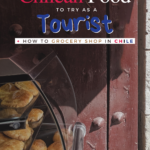
There’s no shortage of great Chilean foods to try for tourists. From the pikcy-eater-friendly hot dogs and french fries (which are widely available) to uniquely regional delicacies. Trying new foods in Chile is a great way to get a taste of the local culture and experience Chile with all your senses.
In this article, I share some of my favorite Chilean foods that I learned to love during my 3-month stay as a digital nomad. I’ll also share a brief guide to alcohol and cocktail options in Chile and finish with some advice for where tourists should shop for groceries in Chile .
Foods to Try in Chile as a Tourist
- Signature Alcoholic Drinks in Chile
Where to Buy Groceries in Chile as a Tourist
Chile has a rich culinary tradition that includes both native and European influences. Just like the vast span of this 2,500-mile-long country, Chilean cuisine offers almost endless possibilities for every palate and every budget. If you find Chilean foods to try, you’ll discover both familiar foods for American palates plus truly unique-to-Chile dishes. Don’t be afraid to try something new. You might be surprised by how much the unique south American flavors appeal to you!
Chilean Empanadas
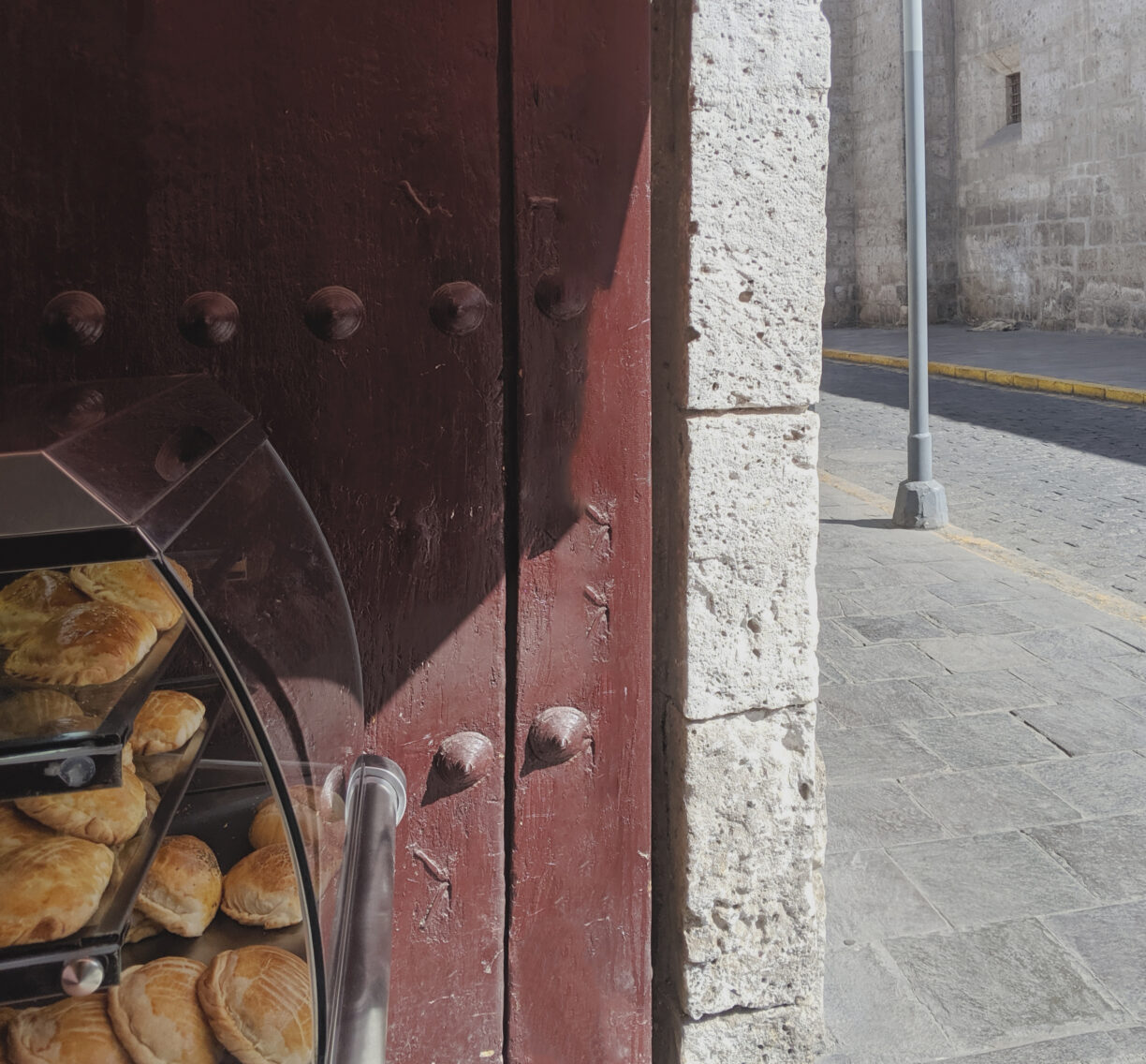
You’ve had Empanadas, but Chilean Empanadas are a unique experience. Empanadas are definitely the most popular Chilean food to try, and backpackers live on them.
Chilean empanadas differ from other empanadas in both their ingredients and their preparation. The dough is also usually made with wheat flour, which gives it a slightly different texture and flavor than other empanadas. Chilean empanadas are typically baked, rather than fried. This gives them a soft but still crispy exterior. They are often served with a dipping sauce, such as pebre (a sort of Chilean chimichurri).
Chilean empanadas are a great food to try for packing lunches in Chile. They are much larger than other types of empanadas, and are usually shaped like a half-moon. This allows them to be stuffed with more filling, making them a hearty and satisfying meal perfect for backpacking or hiking.
Dulce de Membrillo:
Dulce de Membrillo is a sweet treat that is popular in Chile. It is made from quince fruit and is often eaten with cheese. The candy is said to have a sour and sweet taste, and is also said to be good for your health. Dulce de Membrillo is a spread that is smeared over rolls and bread, like jelly. It has a somewhat sweet flavor and a texture that is more like jelly than it is like jam. You’ll most often find it served with breakfast.
Authentic Mate
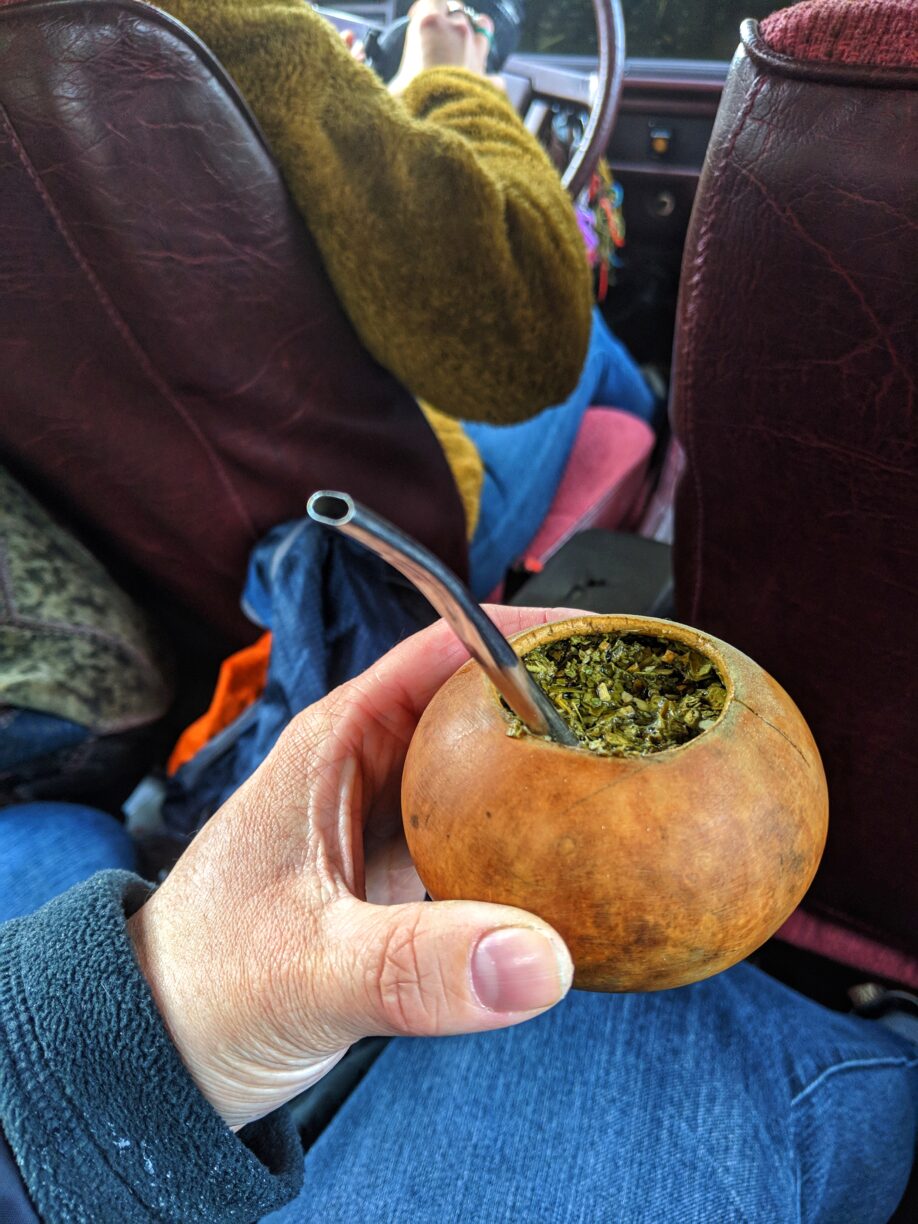
Chile is one of the best places in the world to try mate. This traditional South American beverage is made from the leaves of the yerba mate plant, and it has a unique flavor that is both earthy and slightly sweet. Mate is usually consumed through a straw, and it is often shared among friends as a way to bond and relax.
When I read this in travel guides before my trip, I thought this must be an exaggeration or an old-fashioned tradition. Much to my surprise, however, I got to participate in this activity my first week. After being invited mushroom hunting with my Airbnb hosts in Patagonia, our group returned to the car wet from rain and hands stained with juice from the Calafate berries we found on the trail. There, as we warmed up in the car, mate (pictured) was prepared and passed around.
Curanto is a food from the Chiloe region of Chile. It is a type of stew that is made with seafood, meat, and vegetables. The stew is cooked in a pot over an open fire. It is a popular dish in the Chiloe region and is often served at festivals and celebrations.
Chorrillana: Chile’s Hot Dog & French Fries
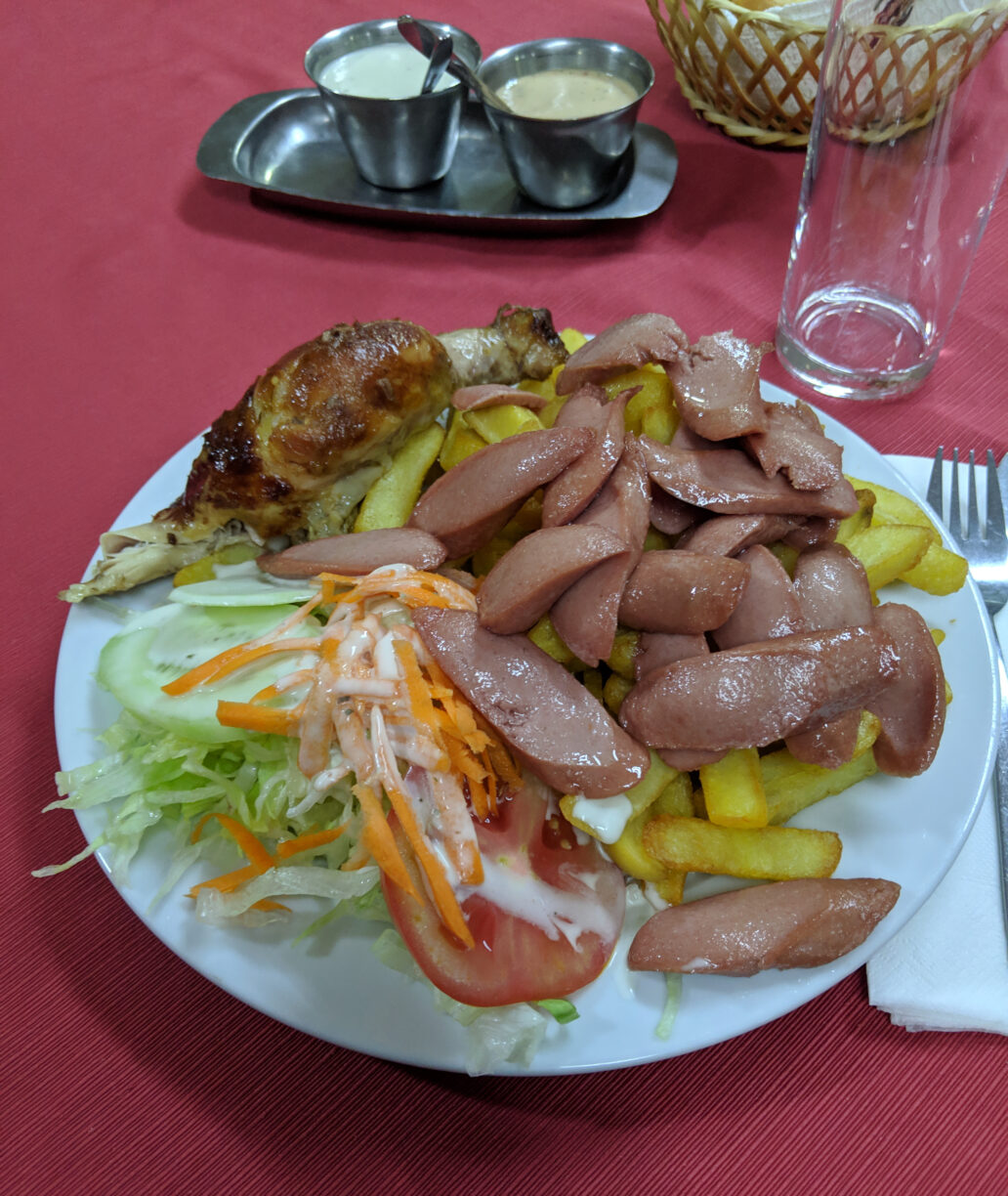
Picky eaters rejoice!
Chorrillana is a Chilean dish of hot dogs and french fries. It is a very popular dish in Chile, and is often served as a main course.
The dish is made by frying hot dogs and french fries in a pan, and then adding a variety of sauces and spices. It is a simple dish to make, and can be easily adapted to any taste- if you’re invited to make a Chilean dish for a cultural event and you don’t know what to make, try Chorrillana. It’s easy to cook, authentic, and everyone will eat hot gods and french fries!
Yellow Pomegranates
I was lucky enough to try yellow pomegranateson my first day in Chile and they were delicious! This particular variety of yellow pomegranates sold in fruit markets in Chile is called the “Baixa” pomegranate. It is grown in the central valley of Chile and is a perfect Chilean food to try during your trip. The Baixa pomegranate is a large, yellow fruit with a sweet, tart flavor. The seeds are small and edible, so there’s no need to remove them before eating. I really enjoyed the taste of the Baixa pomegranate and would definitely recommend trying it if you get the chance.
Chile is not typically known for its cake. However, there are some bakeries in Chile that make very good cake. One such bakery is La Casa del Dulce in Santiago . This bakery specializes in making Chilean-style cakes, which are often filled with fruit or jam and covered in a thick layer of frosting.
Pan Amasado
Pan Amasado is a traditional Chilean food you should definitely try on your trip. Well, you almost definitely will try this bread, since it’s served by almost every restaurant. The bread is made from flour, water, yeast, and salt, and is typically served with cheese and ham. It can also be pan-fried or baked. Pan Amasado is a delicious and versatile dish that is perfect for any occasion. You’ll find it in most chilean restaurants served with Chilean Pebre before the main course
Chilean Pebre Sauce
Chilean Pebre is a delicious and easy to make sauce in Chile. It is traditionally made with cilantro, onion, garlic, olive oil, and chili pepper, and can be used as a dip or a condiment. Chilean Pebre is typically eaten as an appetizer or snack, but it can also be used as a sauce for meats or vegetables.
Manjar (aka: Dulce de Leche):
Manjar, commonly known as dulce de leche, is a caramel-flavored condensed milk dessert. Chileans consume it in the same way that Americans consume peanut butter and you’ll find it featured in many deserts and breakfast settings. It’s definitely unique to Chile, so even if you’re familiar with Dulce de Leche, try Manjar.
Quesillo Cheese
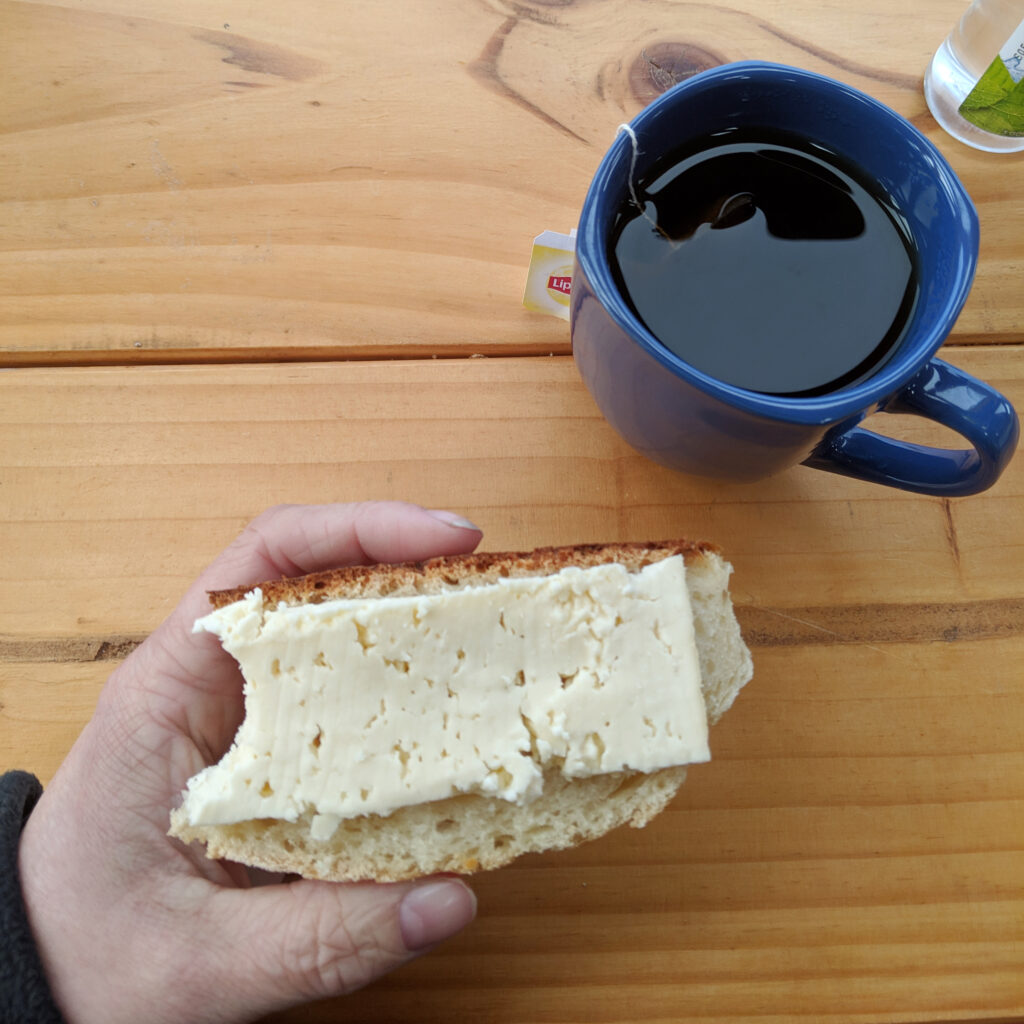
This is a spongy type of cheese that is a great food to try in Chile. It comes in little white chunks and has a very smooth, mild flavor. It is made from cows milk that is gathered from cows that graze in the Andes Mountains. The cheese is widely used in snacks and sandwiches.
Ceviche is a traditional dish from the coastal regions of Chile and Peru. It is typically made with fresh fish or seafood that is marinated in citrus juice and spiced with chili peppers. The dish is often garnished with onions, garlic, cilantro, and lime. Ceviche has become super popular in Chile in recent years due to its fresh and flavorful taste- you’ll find it served up and down the coast.
Lomo Saltido
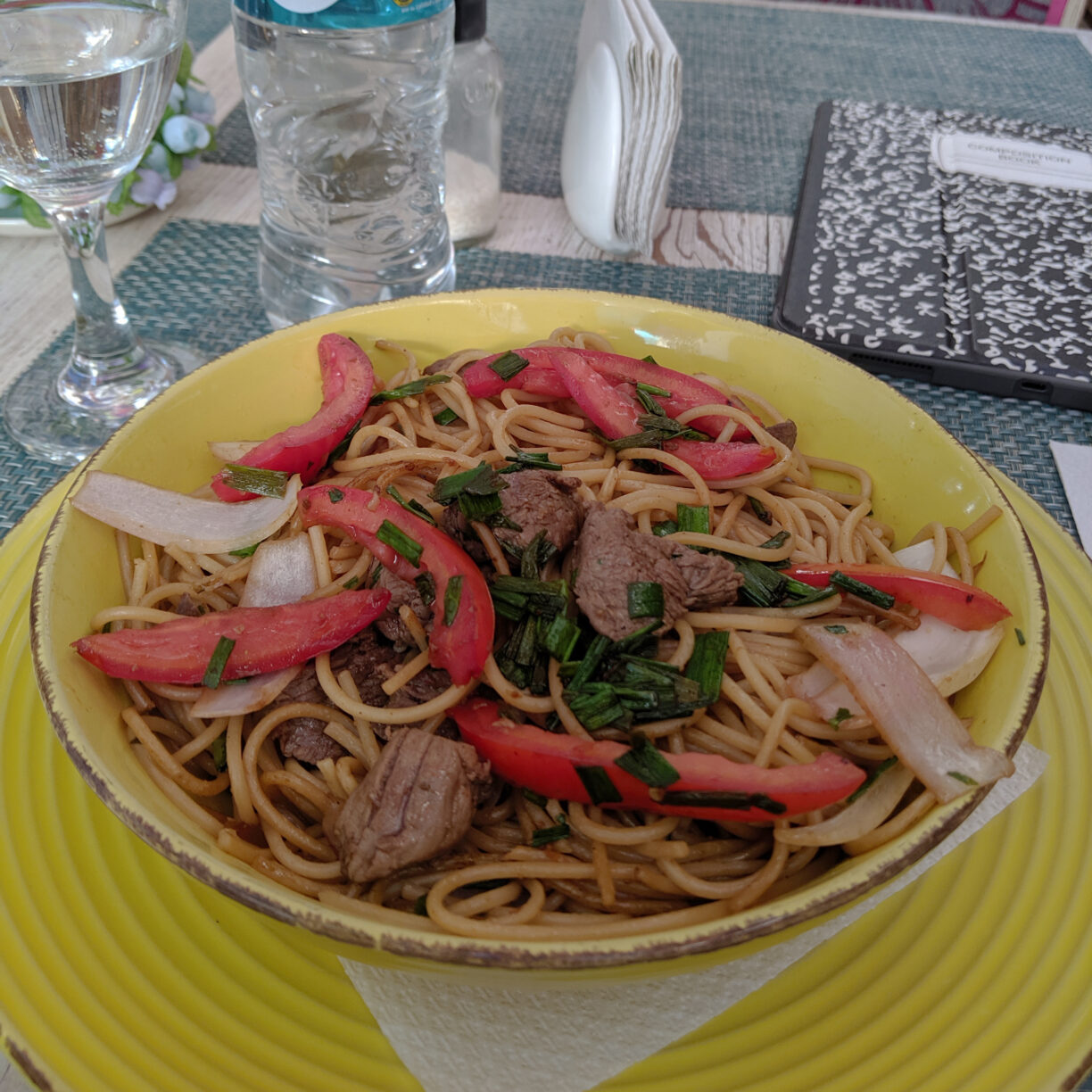
Lomo Saltado is a dish related to Peruvian Chifa cusine dish that typically includes beef, tomatoes, onions, and french fries. It is cooked in a wok and is often served with rice (or even french fries!) Cooked well, it’s a quitesential food to try in Chile.
pastel de choclo
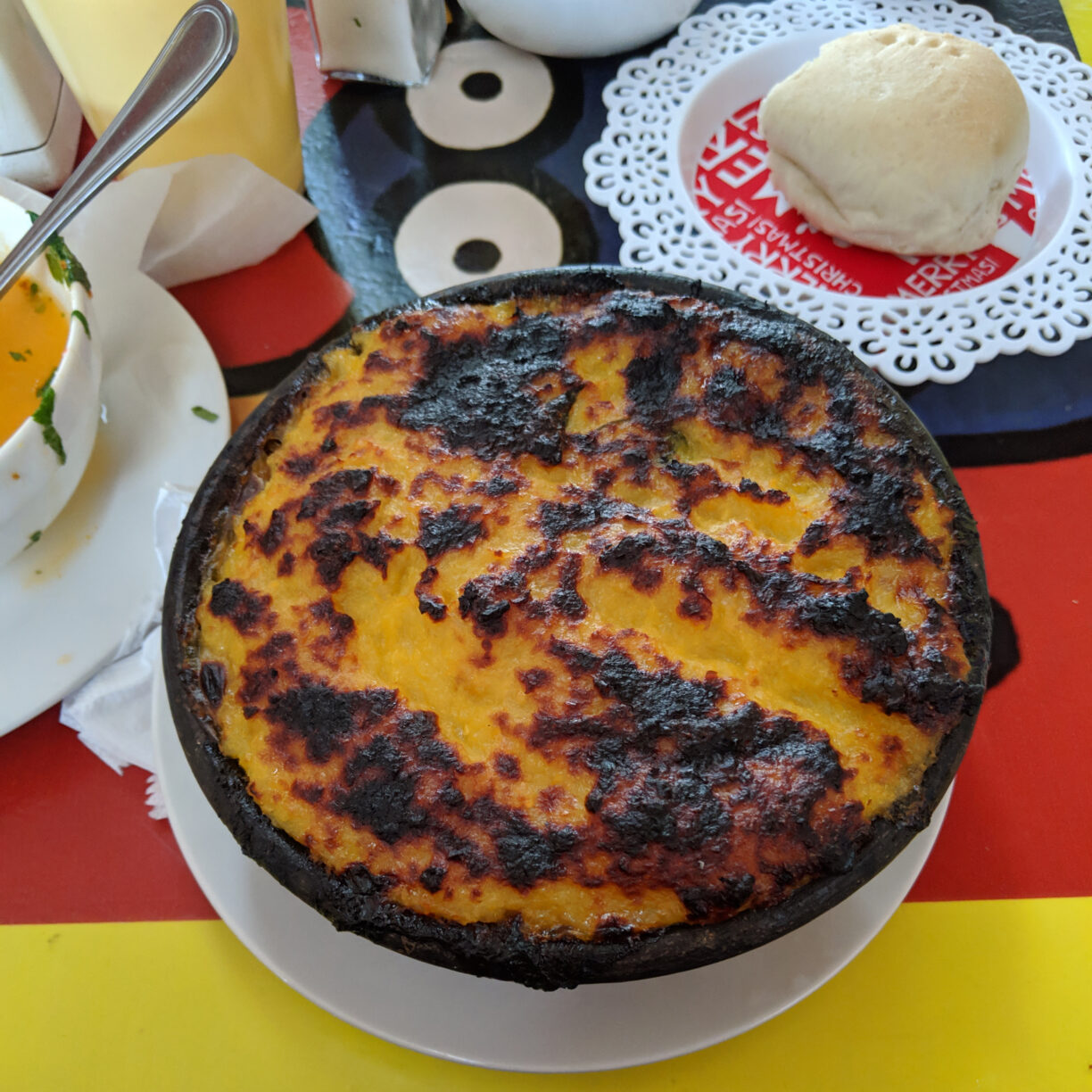
Pastel de choclo is a traditional Chilean dish made with ground beef, chicken, or seafood, corn, and spices. It is typically served with a side of rice or potatoes. While the dish may sound simple, it is full of flavor. Although, I’ll be honest- the addition of olives to this dish threw me a little.
This chilean food is hearty and filling, but also has a unique and exotic flavor that will tantalize the taste buds. Those who are adventurous eaters will find that Pastel de choclo is a great way to spice up their dinner order.
“Completo” the Official Hot Dog of Chile
Chileans love hot dogs. It’s an affection I didn’t entirely understand, but when you visit grocery stores in Chile you’ll find a hot-dog section larger than most lunch-meat departments in North American supermarkets!
A completo hot dog is a hot dog that is topped with avocado, tomato, mayonnaise, and cheese. This dish is popular in Chile, and its name comes from the fact that it is a complete meal in one. The hot dog is the main protein, the avocado and tomato provide healthy fats, and the mayonnaise and cheese add creaminess and flavor.
This dish is cheap, easy, and makes a great option for a quick lunch or dinner. I recommend it on transfer days. You’ll find Completos available in most Chilean bus stations and it’s a good meal before an overnight bus trip because the risk of food poisoning is lower with processed meats.
Signature Alcoholic Drinks in Chile
There are many popular alcoholic beverages available in Chile, making it a great destination for those who enjoy a good drink. Chilean wines are among the most popular in the world, and the country is also home to a variety of other alcoholic beverages, including pisco, a distilled spirit made from grapes.
Chilean Wines:
In Chile, Chilean wine is inexpensive and plentiful!
Not sure which Chilean Wine to Try ?
The most popular Chilean wines include Cabernet Sauvignon, Merlot, Sauvignon Blanc, and Chardonnay. Cabernet Sauvignon is the most widely planted red grape in Chile, and it is used to produce a wide range of wines, from entry-level to premium.
Chilean Cabernets are typically medium-bodied with good acidity and firm tannins. They often have aromas and flavors of blackberry, cassis, and plum, with a hint of eucalyptus. Merlot is another popular red grape in Chile, and it is often blended with Cabernet Sauvignon. Merlot-based wines are typically soft and round, with flavors and aromas of black cherry and chocolate. Sauvignon Blanc is the most widely planted white grape in Chile, and it is used to produce a wide range of wines, from dry to sweet.
Pisco is Chile’s national liquor. It’s both delicious and dangerous at the same time. There are two main ways that Pisco is enjoyed:
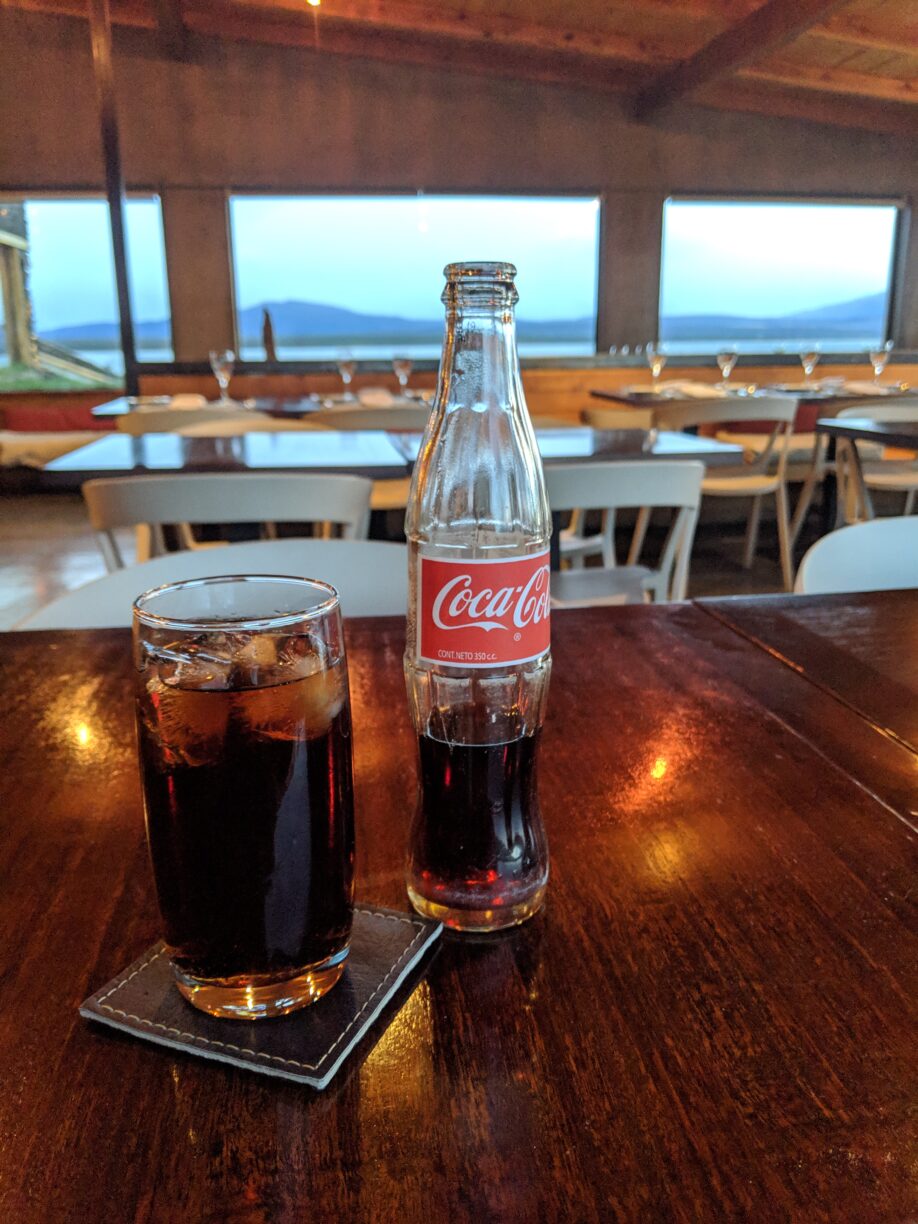
Mix it with Coke to make a “piscola,” the cocktail that is always on the menu at every bar. But be warned: it’s a powerful liquor, and in Chile, cocktails may be up to six times stronger than what we’re used to.
A piscola compares to a Rum and Coke at your favorite bar in the United States, but Chile’s version contains much more alcohol! Often, you will be offered a glass with just ice and spirits, with less than an inch of room at the top! A bottle of Coke is provided separately.
A Pisco Sour is a refreshing cocktail made with pisco, lime juice, simple syrup, egg white, and Angostura bitters. The lime juice in a Pisco Sour adds tartness and cuts through the sweetness of the simple syrup. The egg white in a Pisco Sour gives the drink a foamy texture and a beautiful presentation. If you are not a fan of egg white, you can request the bartender leave it out. Angostura bitters add depth of flavor and a little bit of spice.
Popular Pisco brands in Chile include the always-cheap Capel, Alto del Carmen, and my personal favorite, Mistral (it’s pricier, but so much smoother!)
One of the challenges to settling in as a digital nomad or getting your footing as an ex-pat in the first month is figuring out where to buy groceries. Here are some tips for navigating this challenge in Chile.
Open Market
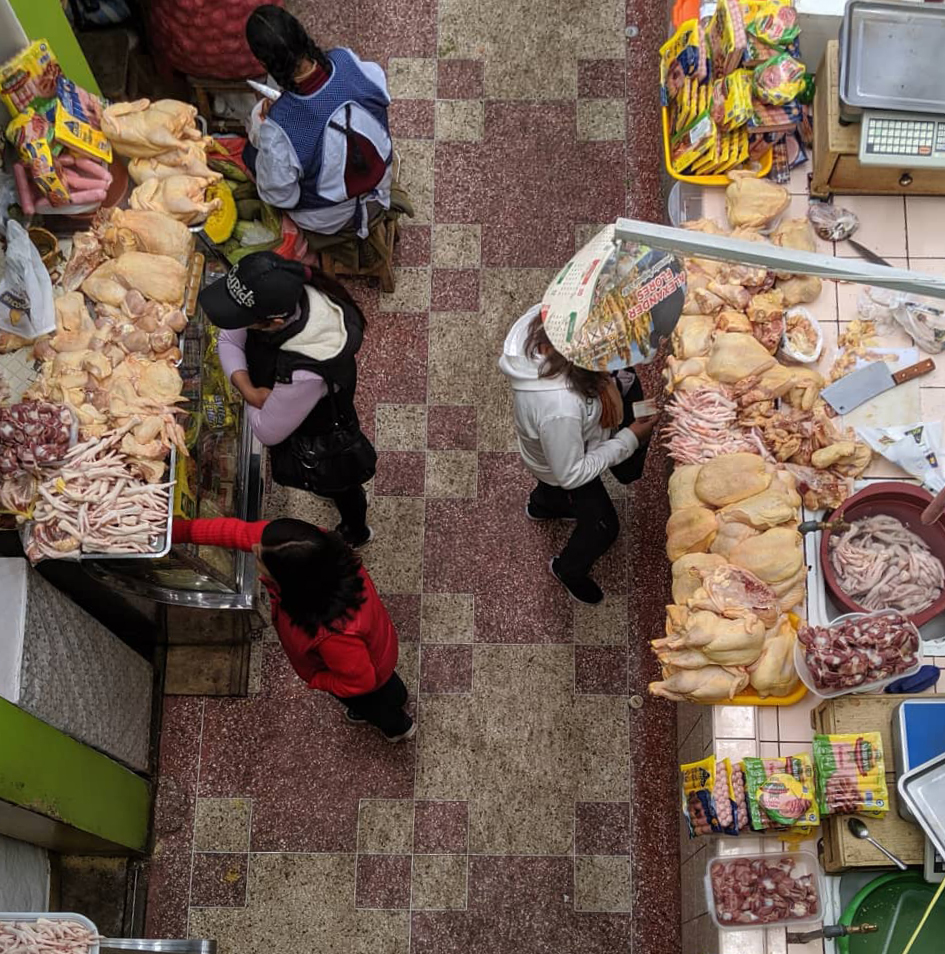
There is nothing quite like the taste of fresh produce that you can purchase at the open markets in Chile. The produce is always so fresh and juicy, and the prices are unbeatable. I love to go to the open markets and stock up on all kinds of fresh fruits and vegetables. Personally, however, I buy meats only at a regular grocery store.
In Chile, there are many fascinating delicacies to sample at the store. Choose a large grocery shop, such as Jumbo or Lider, and investigate. Check out the produce area for additional unusual fruits and vegetables; I didn’t include many on the list since they’re seasonal, and I’m not sure what will be in season during your trip.
Lider is one of the most common grocery chains in Chile. As it is owned by Walmart, it’s a less expensive option than ther supermarkets. If you can locate a Jumbo, check it out! It’s weirdly comforting, and you’ll find a deal on anything you forgot to pack. It’s Chile’s equivalent of Super Target and Walmart!

Jumbo is a Chilean supermarket chain that was founded in Santiago in 1980. The chain is owned by Cencosud, one of Chile’s largest conglomerates. Jumbo currently has over 100 stores in Chile and is the country’s second-largest supermarket chain. Jumbo’s stores are typically large and offer a wide variety of food and household products.
El Super is a Chilean supermarket chain that was founded in the early 1990s. The company has grown rapidly in recent years and now operates over 100 stores across Chile. El Super is known for its low prices and its wide range of products, which include everything from groceries to electronics. This grocery chain also stocks rotisserie chickens, which are key ingredients for making meals in an airbnb kitchen or cooking easy food in a hostel .
There are also a number of smaller chains. Tottus, Santa Isabel, Montserrat, Unimarc, and Economax come to mind right away.

Lynli Roman’s unique approach to travel is informed by decades of experience on the road with a traveling family and, later, years spent as a solo international traveler. When she’s not writing about Seattle from her Pike Place Market apartment, Lynli writes on-location while conducting hands-on research in each destination she covers. Lynli’s writing has been featured by MSN, ABC Money, Buzzfeed, and Huffington Post. She is passionate about sharing information that makes travel more accessible for all bodies.

- Virginia Beach
- History & facts
- Famous people
- Famous landmarks
- AI interviews
- Science & Nature
- Tech & Business
Discover something new everyday
- Famous places
Food & Drinks
- Tech & Business
30 Best Traditional Chilean Food Everyone Should Try

Photo by Paul Hermann on Unsplash
Read Next →
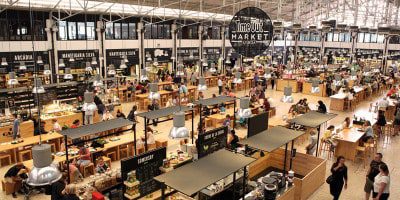
Top 14 Food Markets in Lisbon
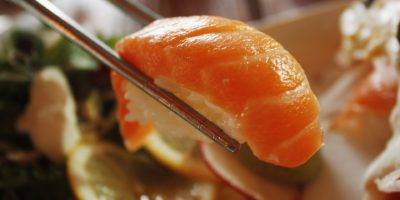
15 Best Sushi Trains Of London
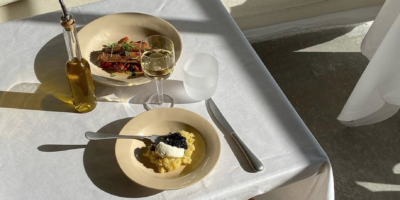
20 Best Restaurants in Paris in 2023
1. empanadas.

Photo by mk. s on Unsplash
2. Pastel de Choclo

Photo by Alexandra Tran on Unsplash
5. Chorrillana
6. completo.

Photo by Yuheng Chen on Unsplash

Photo by Jarritos Mexican Soda on Unsplash
9. Sopaipillas
10. humitas, 11. machas a la parmesana, 12. porotos granados, 13. charquicán, 14. calzones rotos.

Photo by Freddy G on Unsplash
15. Chapalele
16. arrollado de huaso, 17. lomo a lo pobre, 18. caldillo de congrio.

Photo by Cala on Unsplash
19. Ensalada a la Chilena

Photo by Nadine Primeau on Unsplash
20. Bistec a lo Pobre
22. cazuela de ave.

Photo by Ashkan Forouzani on Unsplash
24. Cochayuyo
25. paila marina.

Photo by CHUTTERSNAP on Unsplash
26. Pan Amasado

Photo by Mike Kenneally on Unsplash
27. Cola de Mono
28. mote con huesillo, 29. tres leches cake, 30. quinoa salad.

Photo by Yoav Aziz on Unsplash
Planning a trip to Paris ? Get ready !
These are Amazon’s best-selling travel products that you may need for coming to Paris.
- The best travel book : Rick Steves – Paris 2023 – Learn more here
- Fodor’s Paris 2024 – Learn more here
Travel Gear
- Venture Pal Lightweight Backpack – Learn more here
- Samsonite Winfield 2 28″ Luggage – Learn more here
- Swig Savvy’s Stainless Steel Insulated Water Bottle – Learn more here
Check Amazon’s best-seller list for the most popular travel accessories. We sometimes read this list just to find out what new travel products people are buying.
Brian is a passionate nursing student at Kenyatta University. His heart beats for discovering Kenya's riches and beyond. Brian enjoys reading literature about the human anatomy and recounting his exploits. The Great Dixter House serves as the backdrop for his first article, a masterwork that brings to life locations he can only dream of seeing. Brian's writing is a trip through the delights of people, food, culture, history, and architecture.
Hello & Welcome

Popular Articles

Top 20 Streets to See in Paris

Paris in two days

Top 15 Things to do Around the Eiffel Tower

The Best Way to Visit Paris Museums

Top 15 Fashion Stores in Le Marais
Visit europe with discover walks.
- Paris walking tours
- Montmartre walking tour
- Lisbon walking tours
- Prague walking tours
- Barcelona walking tours
- Private tours in Europe
- Privacy policy
© 2024 Charing Cross Corporation
20 Chilean Dishes You Need To Try At Least Once
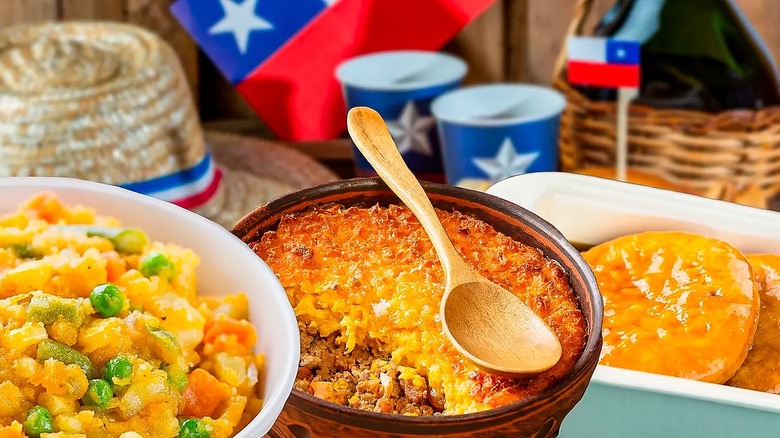
Chile's position in South America offers a wide range of landscapes and influences. With about 2,600 miles of the South Pacific coastline, the Andes separating it from Argentina, the Atacama desert to the north, and Chilean Patagonia to the south, the distinctions are anything but subtle. Aside from the vast variations in geography, the bordering countries also exert an influence.
While these cultural forces are notable across a range of areas, the country's cuisine highlights many of them, too. Seafood specialties, foods cooked over centuries of tradition, and others created in times of necessity all come together under the umbrella of Chilean food. Even if you travel to Chile, it will take you multiple stops across its length to get a broader idea of the wide array. We're outlining the top Chilean dishes you have to try at least once, to pique your interest — and appetite — in this incredibly diverse country.
Pan amasado con pebre
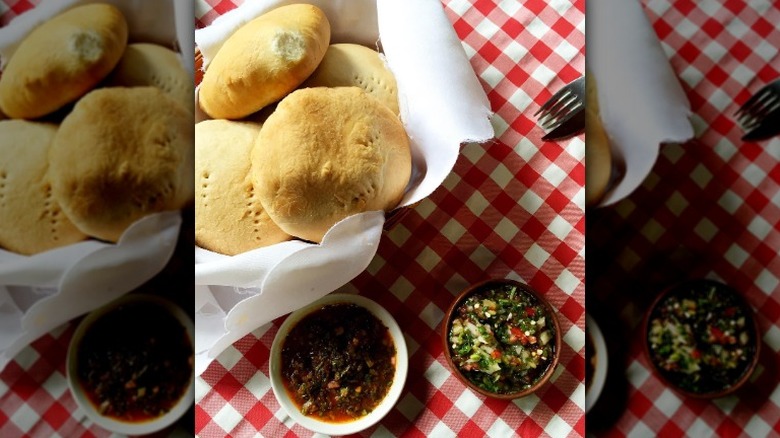
Chances are you're not eating as much bread as the average Chilean — unless you live in Germany. According to a 2019 report by the USDA Foreign Agricultural Service , Chile comes second worldwide for its volume of yearly bread consumption, averaging around 200 pounds per person. If you're on the street before meal times, you'll see people carting bags of bread home to their families.
You'll likely be served the classic duo of pan amasado and pebre upon sitting down at most local restaurants. The bread dough is kneaded and shaped into discs, then commonly baked in a clay oven. The result is a crispy shell with a softer doughy interior. While you could eat it with anything (or even alone), it is often paired with pebre, a salsa-like condiment. The ingredients vary, but you'll usually find a diced blend of tomatoes, cilantro, onions, chili peppers, garlic, olive oil, and vinegar.
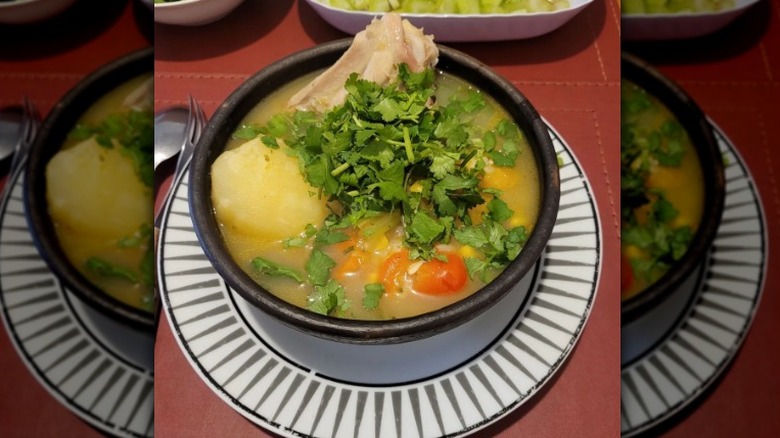
Cazuela is the type of dish that inspires people to visit home to savor their mother's cooking. The stew comes in various styles depending on the season, consisting of a lightly seasoned broth, vegetables (corn, potatoes or squash, green beans), and meat (beef, lamb, chicken, or pork are all common). It's the kind of meal that sticks to your bones, warming you up with each spoonful.
Named after the clay casserole it's served in, you will find locals tend to have strong feelings about this traditional dish. Everyone has their favorite versions of it (usually depending on how they grew up eating it at home), and it is absolutely a must-try if you're in Chile, as this dish is deeply engrained in the culture.
Sopaipillas
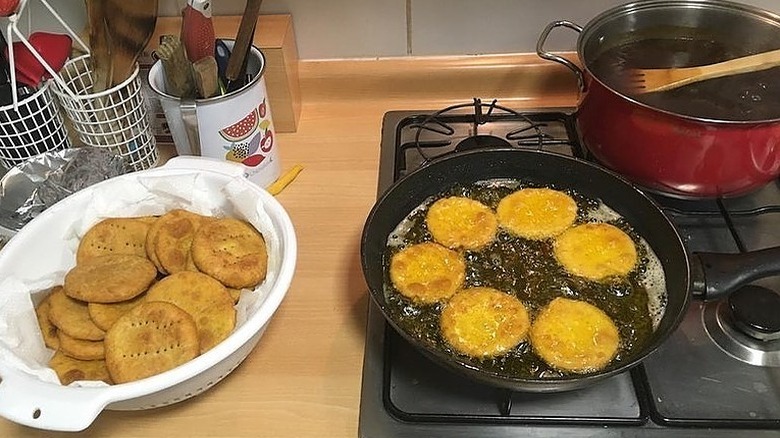
Although bread is the carb of choice for most Chileans, other starchy foods are savored. Sopaipillas come in various forms in Latin America, but in Chile, they are often made with cooked pumpkin. The squash is mixed with flour, water, a leavening agent, and salt, then shaped into discs and fried. The result is simultaneously crispy and airy, and it's the perfect consistency to scoop up some pebre. Or, you can go the sweet route by sprinkling sugar on top to bring out the pumpkin's natural sweetness.
The tasty recipe is an excellent snack food and a great option to serve as an appetizer. Grab a few at a street-side stand or fry up a batch at home for the ultimate comforting treat. It's no surprise this hearty snack is commonly enjoyed on a rainy day — the hot crispy dough will warm you from the inside out.
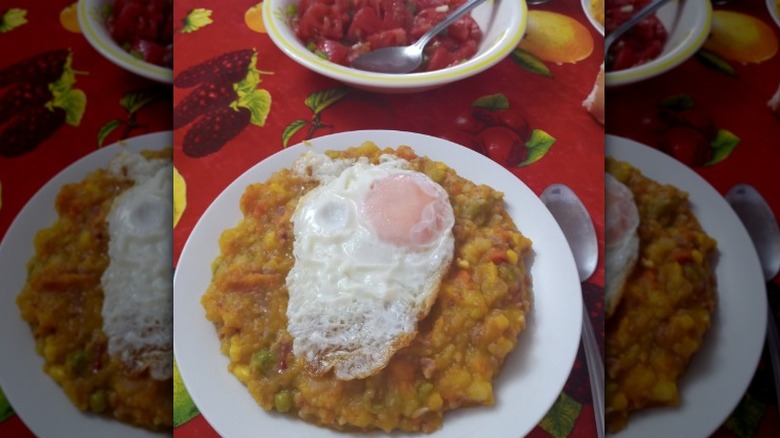
Plenty of Chilean favorites consist of variations of meat and potatoes, and, to be fair, the iconic duo is so popular for a reason. It's tasty, nourishing, and satisfies many appetites. Charquicán is a fine example of the duo. Originally made with dried llama or horse meat, ground or shredded beef is more common nowadays. The meat is cooked much like a hash, with potatoes, beans, peas, and corn to fill it out.
Aside from being a savory and filling meal, the reliance on dried meat historically made charquicán popular with nomadic folks, no matter the time of year. Depending on the season, the components vary based on what's available. A fried egg layered on top is always appreciated, enhancing the dish with more protein and flavor.
Caldillo de congrio
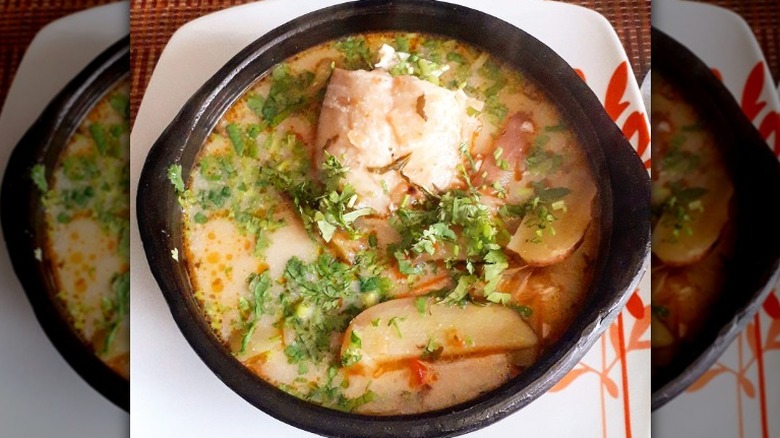
When a dish is the star of an ode by the country's greatest poet, Pablo Neruda, you know it's something special. Neruda was onto something, and caldillo de congrio is pretty much the best seafood concoction you'll get in a bowl. The warming dish consists of a broth with conger, a local eel species. If conger isn't available, another white fish is used for the preparation.
The broth is typically red, with stewed tomato, bell pepper, onion, garlic, carrot, and chili pepper. A splash of cream thickens the broth and a fresh sprinkling of parsley and coriander brighten up each spoonful. Commonly eaten with yet more bread, caldillo de congrio is the perfect remedy for a rainy winter day. Or, enjoy it at any time of the year at Santiago's bustling Mercado Central.
Porotos granados
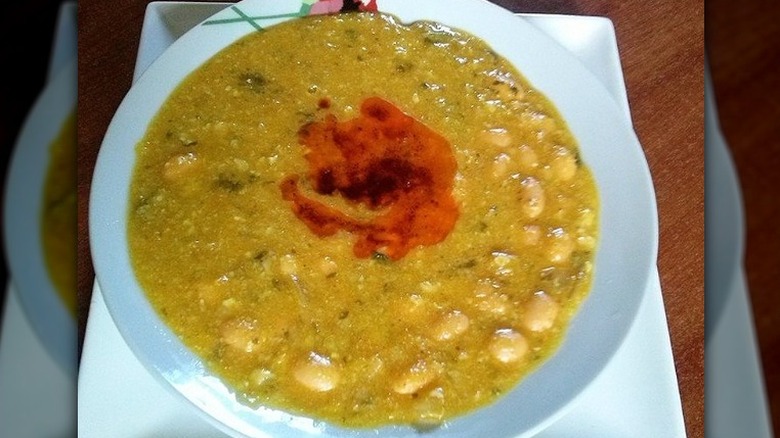
While many classic Chilean dishes rely heavily on animal protein, porotos granados are a welcome vegetarian option. Borlotti (cranberry) beans are the main ingredient, stewed with squash, corn, green beans, tomatoes, and aromatic seasonings. The dish is commonly prepared in the summer when borlotti beans are harvested, however, it can be made in any season with dried beans or other varieties like navy, cannellini, or pinto.
The indigenous Mapuche people were the first to harvest the bean in the south, and this savory stew is one of their most delicious contributions to Chilean cuisine. The various other ingredients were also commonly grown prior to the arrival of the Spanish, making porotos granados a true South American recipe. Serve the creamy stew alone or with a crusty piece of bread.
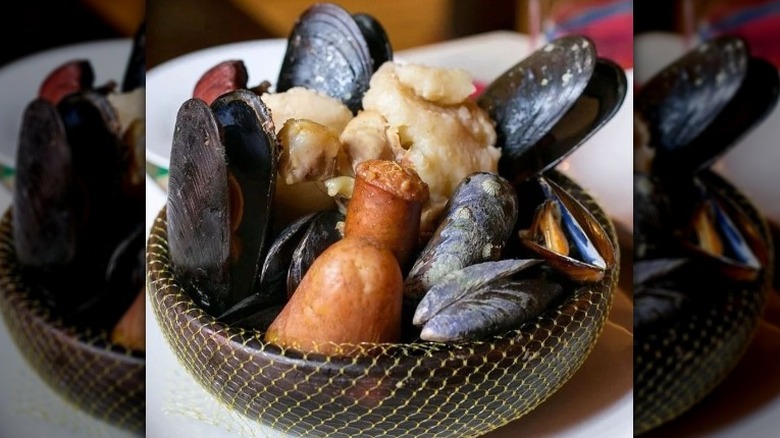
Many cultures have a dish cooked underground, and in Chile, it's curanto. You'll have to travel a bit further than Santiago to get the real deal, though. The Chiloé archipelago sits close to the mainland in the south, yet it can feel like a world apart. Harsh winds and high rainfall are the norms, and the food reflects this rough environment. The dish is easily classified as surf and turf, with a combination of shellfish (mussels, clams), sausage, chicken, potatoes, and potato dumplings.
More important is the preparation; a fire is lit in a pit to heat up stones to cook the various components, though modern recipes cooked in a pot are increasingly prevalent. The ingredients are added and then covered with giant leaves in layers to trap the heat, steaming and infusing them with smoky flavors. The cooked result is loaded into heaping piles on plates, usually in volumes far greater than a single person could consume.
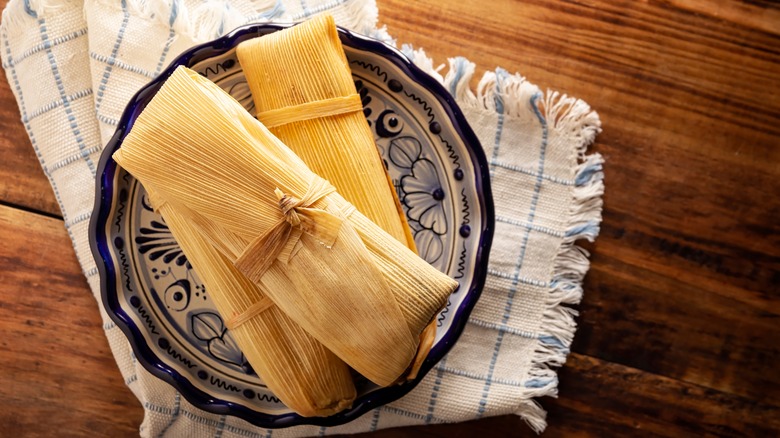
Pretty much the Chilean equivalent of a tamale, humitas pre-date Spanish colonization in Chile. Now a snack time and holiday favorite, the indigenous dish is one of few still consumed from this period. Corn is the star ingredient, though a large starchy variety is used for the preparation, providing an earthier flavor than sweet corn.
The corn mixture is commonly enhanced with onion, basil, and merkén — a smoked chili spice common across the country, and one of remarkably few sources of heat in a country whose name would suggest otherwise. Sugar, salt, and milk add flavor and creaminess to the filling. Everything is sealed in corn husks, tied shut, and steamed or boiled. You'll find people who prefer to serve humitas as a sweet dish with cinnamon and sugar, whereas others praise the savory pairing with Chilean salad (tomatoes, onions, and coriander) or pebre.
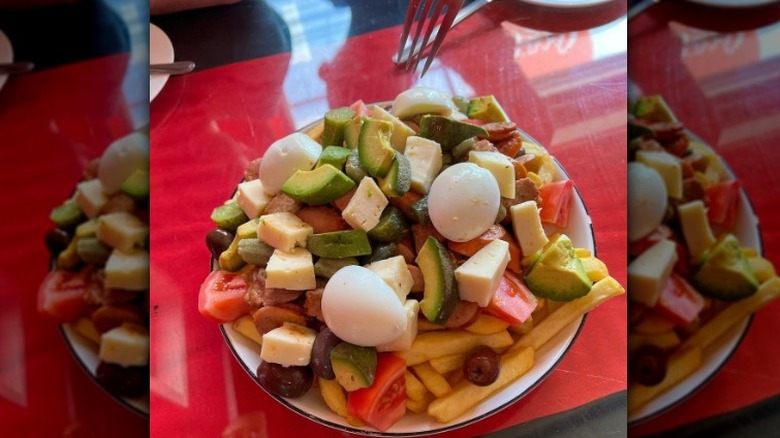
Plenty of traditional Chilean dishes are warm comfort foods that quickly satiate your hunger. Pichanga, on the other hand, is meant to whet your appetite. The appetizer is a favorite to share with a group, whether you're waiting for your main course at the restaurant, having a few beers at the bar, or hosting friends at home.
Similar to the concept of a charcuterie board, a pichanga is served with all the ingredients jumbled together. Pickled vegetables, olives, avocado, cheese cubes, sausage chunks, and assorted meats are piled onto a plate. Toothpicks make it easy to get what you want, while the salty flavors prepare you for more to come. You can make your own mix or pick up a ready-made selection at supermarkets in Chile.

Many people consider hot dogs to be the ultimate American food , but Chile's version has its own mass following. The completo has been a sandwich staple for around 100 years and even has its own holiday on May 24. While the inspiration came from the U.S., the South American version took on its own spin. In Chile, street vendors selling hearty dogs are common, and you can buy the meaty bite in sandwich shops or casual restaurants.
The toppings that make it complete (or completo, per its name) include tomato, avocado, sauerkraut, onion, and parsley. The loaded hot dog has numerous variations, notably the Italiano — with tomato, mayonnaise, and avocado — named for the colors of the Italian flag. Other creative garnishes like green beans, fries, scrambled eggs, and melted cheese are among the countless choices, making the completo an incredibly versatile option for a quick meal.
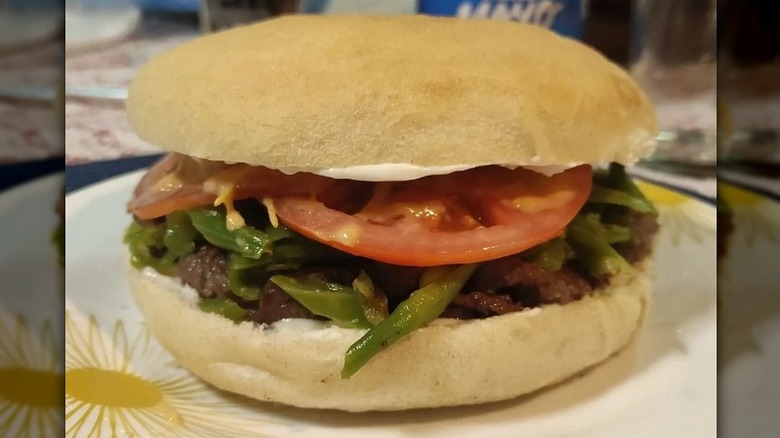
If you're familiar with Brazilian cuisine, you might misleadingly think that Chilean churrasco is also a barbecue event — not quite. In Chile, the term refers to a sandwich, albeit one made with grilled meat. A post on the Chilean tourism website refers to the country as a "sandwich paradise," and a churrasco will likely meet your now-high expectations. Considering Chileans love bread, it's no surprise that a meal that makes use of it is popular.
A churrasco is a steak sandwich, and adding ingredients can quickly modify the name. Top your grilled meat with cheese, and you have a barros luco. Add tomatoes and string green beans (a favorite Chilean topping) and you have a chacarero. Keep it classic with chili pepper sauce or pebre, or load it up with avocado, tomatoes, and mayonnaise, Italiano style.
Empanadas de pino
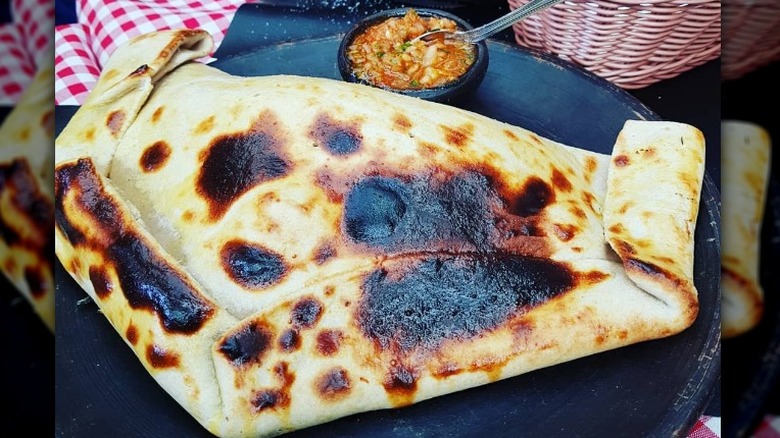
Most people have tried a version of an empanada (which has quite the history), a wheat flour pocket stuffed with ingredients and then either baked or fried. You can get all sorts of flavors in Chile, including seafood, chicken, beef, and plenty of cheesy variations. Although the origins of the hearty snack come from the Arabic reign in Spain, it made its way to Latin America through colonization.
Each country loads up the dough pouches with its favorite fixings, and, above all, empanadas de pino are the most quintessentially Chilean. The Mapuche people are likely responsible for its components, which include ground beef, onions, raisins, hard-boiled egg, chilis, and a couple of black olives.
Empanadas are so common that you can pick them up at street stands, empanaderias, bakeries, or from locals making extra cash by selling a few dozen a week. While small fried ones are often served as an appetizer in restaurants, heartier appetites will be satisfied by the typical hand-sized versions. Or, hit up the town of Pomaire near Santiago, where empanadas weighing in at over 2 pounds are the main attraction.
Pastel de choclo
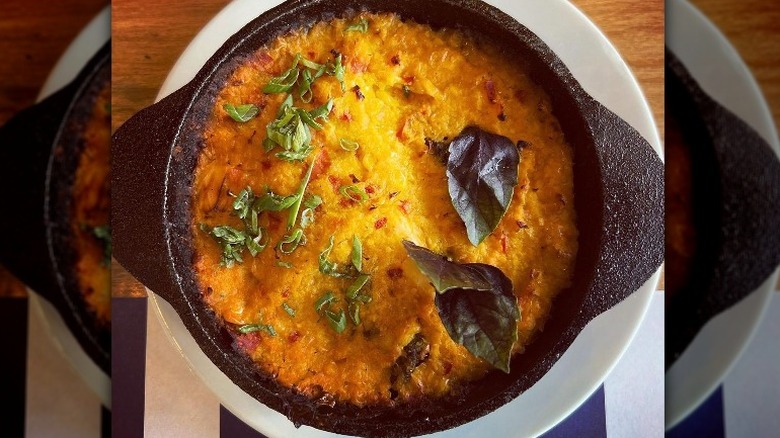
A number of Chilean dishes include corn, and pastel de choclo is surely among the most comforting. The corn and meat pie is comparable to a shepherd's pie recipe , and it's a household and restaurant favorite. Its origins date back to Spanish colonization and it's likely related to similar dishes from neighboring countries.
Similarly to the corn used for humitas, pastel de choclo is made with a starchy creamy variety. Sugar is commonly used to sweeten the puréed topping. The meaty base consists of ground beef with onions, along with the ingredients used in an empanada de pino: raisins, sliced hard-boiled eggs, and black olives. The dish is often baked in the oven in traditional clay cookware, infusing it with an earthy flavor.
Pastel de jaiba
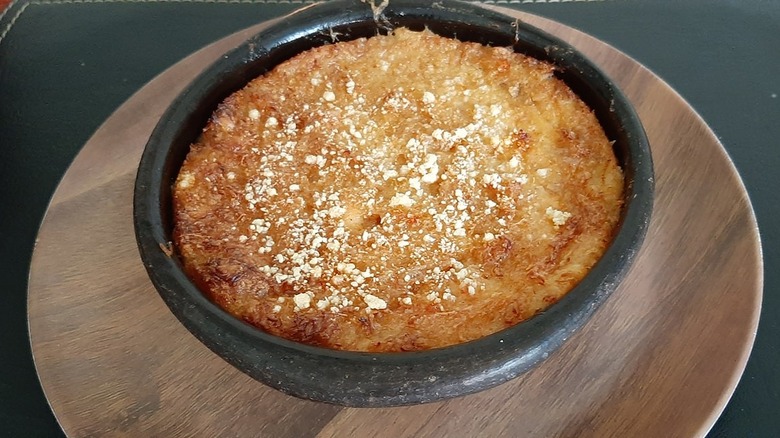
Seafood soups and stews are the norms, but Chileans really love when pastel de jaiba is on the menu. The crab casserole is similar to pastel de choclo, with a rich and creamy consistency that begs to be devoured. Blue crab is commonly used for this recipe, and the shredded meat is combined with ingredients like butter, cream or milk, bread, wine, and seasonings.
Similar to other regional oven-baked casseroles, the creamy mixture is cooked in a clay vessel. Bread crumbs and cheese are typically sprinkled on top before a final broil, resulting in a crispy topping that makes every bite even more decadent. Although "pastel" is sometimes translated as "cake," this is a whole new level of crab cake. Enjoy it with local white wine and a simple salad to round off your meal.
Mote con huesillo
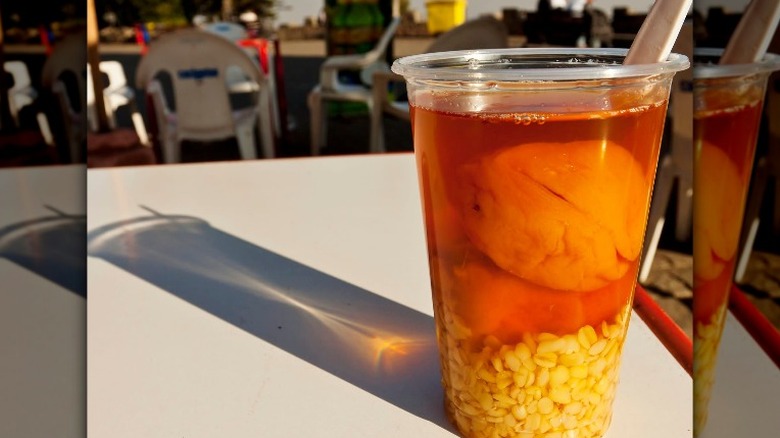
It might not be the first combination that comes to mind when you're in the mood for a refreshing drink, but mote con huesillo is a Chilean favorite. The sweet beverage consists of dried peaches cooked in a sugary syrup flavored with cinnamon. The chilled liquid is served with the now-soaked peach (watch out for the pit) and a scoop of cooked and husked wheat kernels.
While both elements have been present in Chilean diets for a few centuries, it is unclear when they came together as mote con huesillo. Nevertheless, the traditional concoction is so typical nowadays that it is even highlighted in a Chilean expression about being so Chilean. Especially in Santiago, the drink is easy to purchase from street vendors across the city. Enjoy it as an afternoon refresher or sip on the syrupy liquid for dessert.
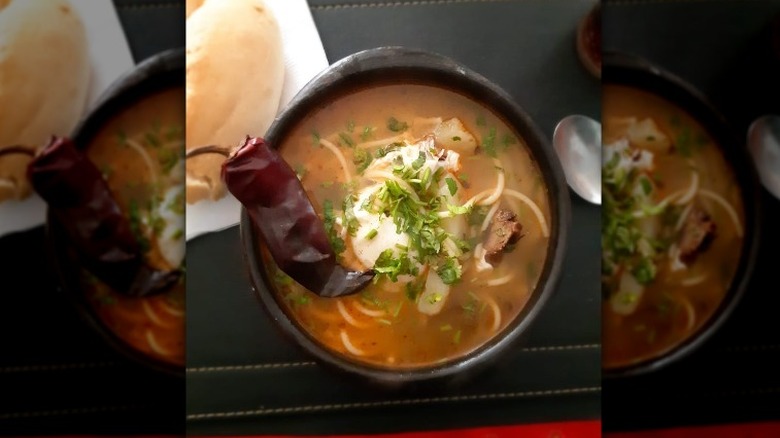
Named after the coastal city of Valdivia, this dish has a long history backing up its popularity. The story goes that at the end of the 1500s, the Spanish conquistadores were stuck in Valdivia with charqui (dried meat) as their main sustenance. After some time of eating the same salty dried meat every day, they decided to transform it into a new dish.
The dried meat is cooked in a broth with vegetables, onions, boiled eggs, and seasonings (cumin, oregano, and parsley are common). Nowadays, you'll find charqui made from leftover barbecue scraps or with ground meat, but its origin as a dish made with dried meat is unambiguous. Aside from its convenience in difficult times, the hearty soup is also perfect to warm up on a rainy day — all too necessary in Valdivia.
Paila marina
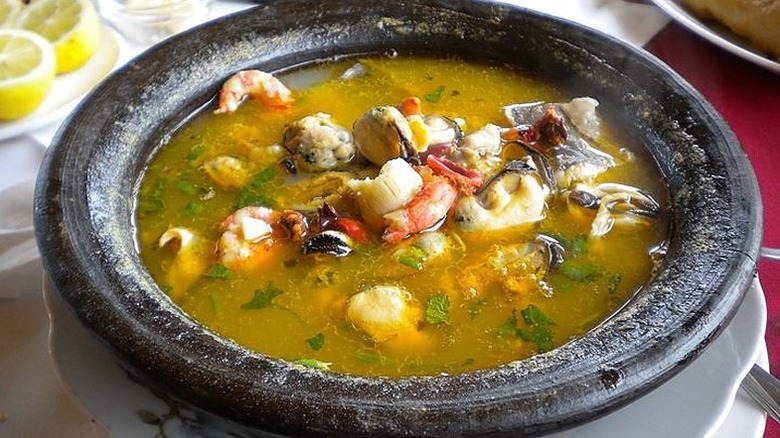
It's no secret that seafood reigns in Chile, in no small part due to its massive coastline. Paila marina brings together all sorts of goodies into a stew — not to be confused with Spanish paella . Typically served in a classic clay bowl, the warm preparation includes various types of shellfish (clams, mussels, shrimp), fish, and a simple seafood stock with carrots, onions, garlic, and seasonings. Tomatoes and bell peppers sometimes end up in the stew, and fresh herb garnishes and a squeeze of lemon juice infuse it with their zesty qualities.
This is another dish that merits a visit to Santiago's Mercado Central, where multiple vendors ladle it out every day. Some people tout its hangover healing properties and visit the market in swarms on January 1, but we'd simply chalk it up to its nourishing and warming nature.
Cordero al palo

Among the dishes from Chilean Patagonia, none receives more attention than cordero al palo. Southern Chile has been home to numerous sheep for over a century, which explains its presence in the local cuisine. Translated as a lamb on a stake, the entire animal is butterflied and mounted on a metal cross or rack.
The meat is roasted vertically on an open wood fire over the course of several hours, producing a richly flavored and smoky result. While the meat cooks, the person tending to the fire continuously bastes it with fat, as well as a mixture of water, salt, clove, and garlic called salmuera. As expected, the meat is typically served with pebre, often with a regional twist. Bread, potatoes, and vegetables fill out the meal, though the true star is undeniably the roast lamb.
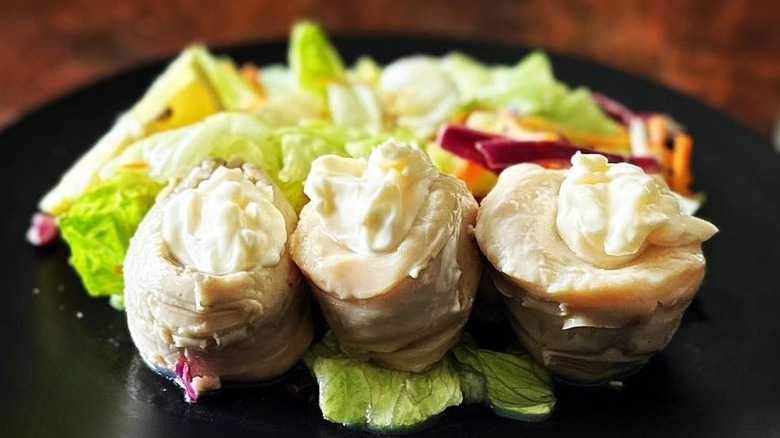
It's pretty easy to find shrimp, mussels, and other types of seafood around the world. Locos, on the other hand, are clearly from the South American nation, as per their alternate name, Chilean abalone. A study by the Universidad de Chile found discarded shells dating back around 10,000 years, which shows that the mollusk was an important part of the local diet at the time. Part of its importance in the cuisine is owed to its abundance of meat, especially compared with other types of seafood.
Nowadays, the meaty mollusk is a rare delicacy, typically served with mayonnaise or a lemon, coriander, and green onion sauce. Additionally, the seafood is baked in a bread, cream, and cheese mixture much like a casserole. Be on the lookout for specialty empanadas showcasing locos, too. If you're planning to cook it yourself, take note that the flesh has to be tenderized first, which traditionally involves pounding it with force.
Chorrillana
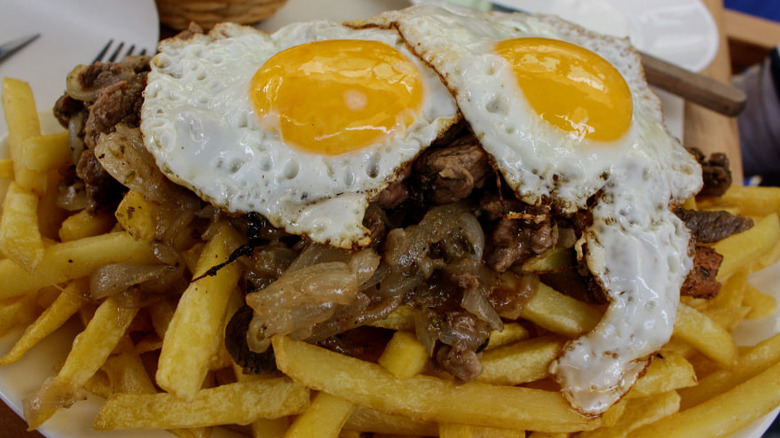
Your appetite has to be at a near maximum to even consider ordering chorrillana. The layered bounty of flavors starts with a plate of fries topped with meat (typically chopped beef or sausage), further loaded with grilled onions and either fried or scrambled eggs. Of course, variations with a range of ingredients are common, including cheese, mushrooms, tomatoes, and assorted meats.
Its origins are thought to trace to the port city of Valparaiso, where the gargantuan dish was invented to provide bar-goers with a cheap and hearty meal to soak up all that beer. An order of chorrillana is particularly excessive since it's meant to serve a few people. Gather some friends and a few pints and you'll be cleaning off your plate in no time.

Famous Food in Chile: The 29 Dishes & Culinary Treats You Must Try
By Author Graham Minser
Posted on Last updated: 14th November 2023
Chile is a country marked by extremes. This is reflected by its great length, which stretches from the Atacama in the north to Tierra del Fuego in the south, as well as in its climates, featuring bone-dry deserts, temperate rain forests, the Andes mountains at their highest point and one of the world’s longest coastlines.
These extremes also apply to its cuisine, which is as varied as its natural environment and people.
Unlike Peru, whose cuisine is more renowned , traditional Chilean food is unpretentious, filling comfort fare meant to help stave off the elements.
Many of its more traditional specialties are being rediscovered in modern kitchens eager to prepare meals with local ingredients unique to Chile’s various ecosystems.
This owes to its cultural heritage as much as its natural environment. While traditional Spanish cuisine undeniably influences the range of dishes found in Chile, its pre-Columbian civilizations left a footprint with native ingredients and cooking techniques.
This is an exciting time for Chilean cuisine, with many chefs going straight to source for ingredients to concoct long-forgotten recipes as well as newer creations.
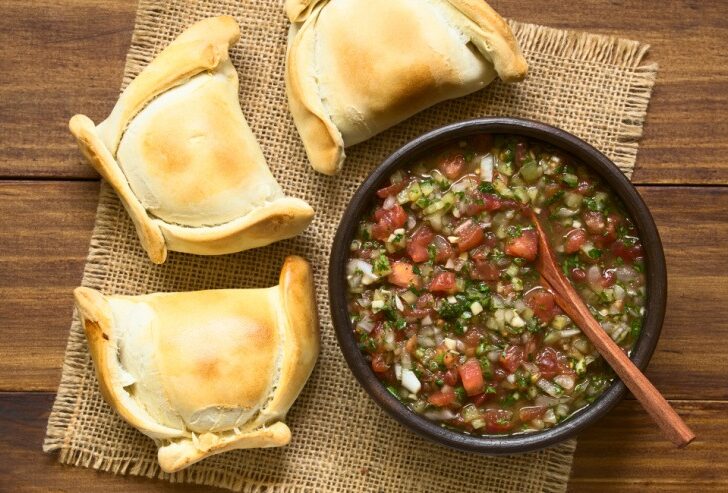
Santiago has the greatest range and most refined restaurants in the country, but great food is not limited to the capital. Here are the dishes and foods you have to try in Chile.
Click to navigate this article:
Meat dishes
Pastel de choclo.
A good place to start is with a local favorite that ticks the boxes of local taste. Pastel de choclo is basically a mashed corn pie filled with pino, a common Chilean mixture of ground beef, onions, basil, and paprika. Chicken is often added, along with black olives and hard-boiled eggs. Merkén, a smoky mild to medium chili, is increasingly popular too.
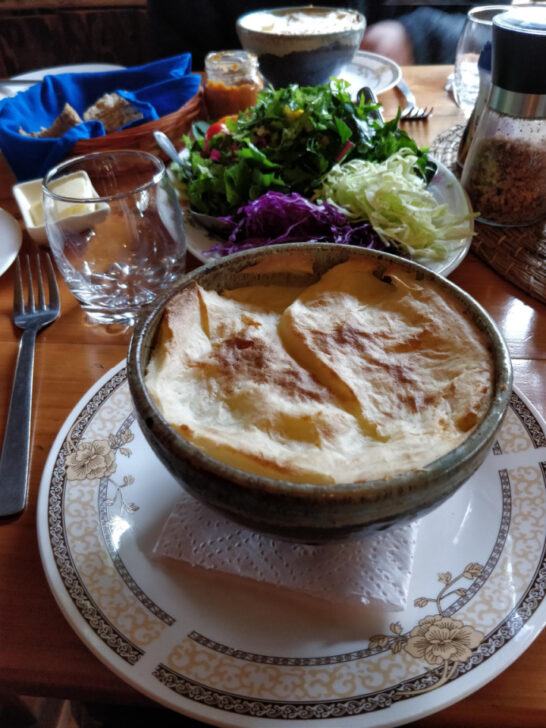
This dish is a great example of Chilean comfort food: savory and filling to counter the cool evenings. An ideal place to sample pastel de choclo in Santiago is La Casa Vieja , with locations in Providencia and Las Condes districts.
Planning Your Trip to Chile?
Save time, stress & money with a customized travel itinerary planned for you by a Chile expert
What previous clients have said:
Steph’s help laying out an itinerary for Chile was huge toward us having a great trip. She listened to our interests and compiled a framework that we could follow to make our plans. She included many practical tips as well as numerous options. She truly saved us many, many hours of research.
Empanada de pino
Whereas pastel de choclo features pino in pie or casserole form, the ever-popular empanada de pino neatly wraps the filling in savory pastry dough.
Minced beef, onions, black olives, and hard-boiled egg feature prominently, and many choose to top it with pebre, a spicy sauce of green chili peppers, onions, garlic, coriander, and often tomato (making it similar to Argentina’s chimichurri).
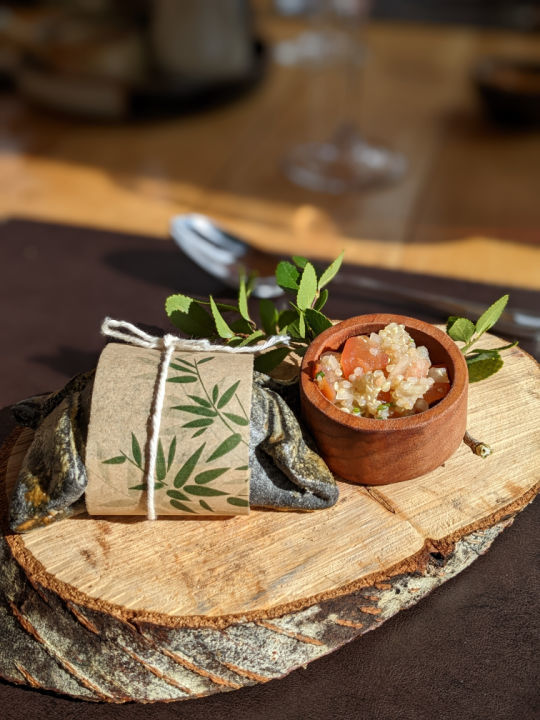
Empanada de pino can be found across the country, but this Central Chilean pastie is best enjoyed in Santiago at a place that specializes in them. Empanadería San Luis in the Ñuñoa district makes outstanding empanadas, including this variety, either baked or fried.
The favorite choice for many to share with friends is the ubiquitous chorillana. This mountain of french fries, chorizo sausage, sliced steak, and diced onions topped with a fried egg or two is best enjoyed over beers and ranks near the top of the most popular Chilean foods.
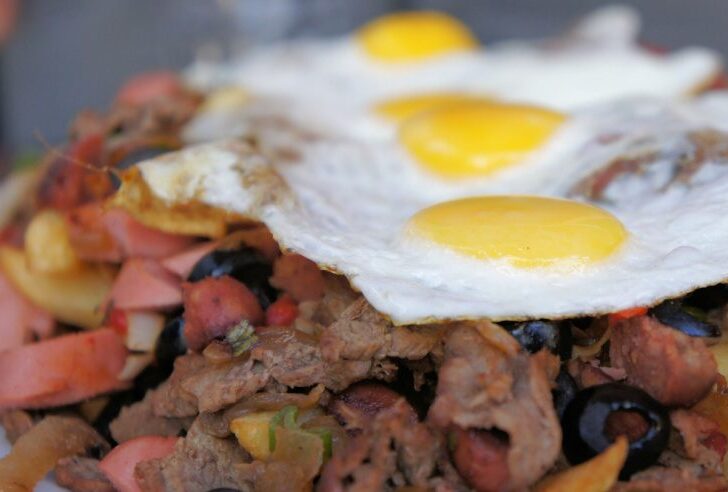
Nearly every place serving beer has chorillana, and Chile’s booming brewpub scene offers plenty of options. In San Pedro de Atacama try Barros Restaurante , and The Singing Lamb in Puerto Natales. In Santiago, El Mesón has an unparalleled selection of draught beer alongside their chorillana.
One look at this decked-out version of the hot dog and you’ll understand why it’s called “the complete”. A completo has been a staple of the fuente de soda (soda fountain restaurant) or schopería (same, but with draught beer) for the past century.
The original is a pork sausage on a bun with smashed avocado, sauerkraut, diced tomatoes, mayonnaise, and “salsa americana”, a relish of pickled vegetables.
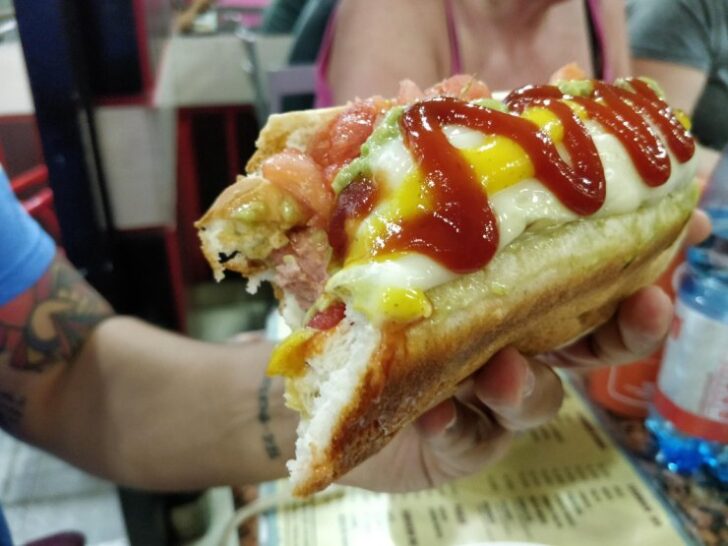
Restaurants often serve popular variations of this Chilean hot dog, including the italiano (minus the sauerkraut and pickled veggies), and a lo pobre (with fried onions, chips, and a fried egg). A classic, no-frills place to eat one is Dominó , with locations all around Santiago.
Barros luco/chacarero
Another favorite at the fuente de soda is the massive sandwich known as a barros luco. But to call this a sandwich is like calling the Andes a series of hills. This jaw-busting lunch special features a more-than-generous portion of tender sliced steak, topped with melted cheese on a freshly-baked bread roll.

The chacarero is the same, but with tomato, green beans, and pebre. One of these plus a draught beer is about as local as a lunch gets. An excellent spot to try one is Fuente Mardoqueo in Providencia, Santiago.
While the completo in a relatively modern invention, pataska is anything but. Made long before the arrival of the Spanish, this Andean stew is a traditional dish originating in the mountains and high desert of Northern Chile. This was prepared as a harvest festival meal in honor of the Incan Pachamama.
It is made with a base of potatoes and boiled maize, usually with charqui (dried horse or llama meat), with various herbs and spices. The place to try pataska is Las Delicias de Carmen in San Pedro de Atacama.
Another bone-warming choice for a brisk evening, carbonada is a stew prepared in the winter all over Chile. Similar to minestrone, it’s made with potatoes, carrots, pumpkin, green beans, and several herbs with diced pork or beef.
Carbonada is a traditional Chilean soup that’s popular in many restaurants, and goes well with oven-fresh bread. An ideal place for this, and several other soups is La Sopería in Barrio Italia, Santiago.
One of the most popular soups in Latin America, especially in Colombia, ajiaco in Chile is distinct in its use of leftover steak from the previous day’s barbecue, and green chilies to add a little bite. It’s hearty and filling, with lots of potatoes and onions with a dash of cumin.
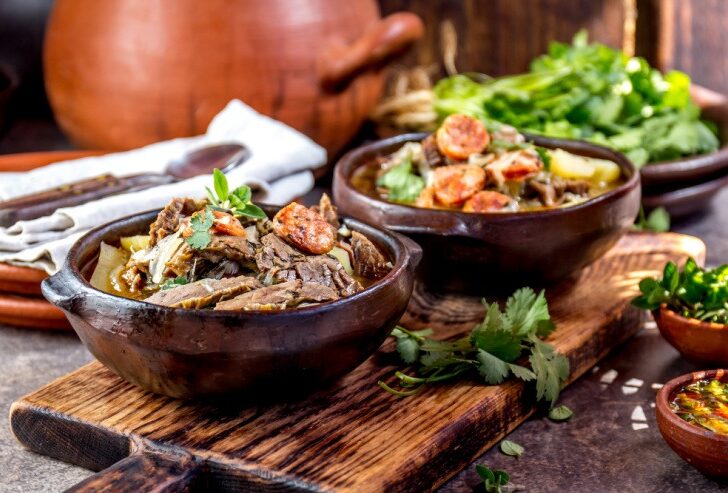
This is commonly eaten as a hangover cure. The perfect place to try it out is at the aptly named El Ajiaco , in Ñuñoa District.
A true Chilean classic, plateada is a slow-cooked delicacy served for special family occasions. Beef brisket is simmered in a deep saucepan in a reduction of red wine, garlic, salt, pepper and vinegar. It is then transferred to the oven and cooked at low heat for a few more hours until the brisket is tender and filled with flavour.
Although this is traditionally a home-cooked meal, plateada, along with other hard-to-find traditional recipes, is served at Don Peyo Restaurant in Ñuñoa. Peluquería Francesa makes a wonderful version with a Roquefort cheese sauce, best paired with a bold cabernet sauvignon.
Arrollado huaso
This autumn dish has been a countryside classic for centuries and is among the most traditional Chilean dishes. This huaso (cowboy) preparation is pork wrapped in pork skin, brushed in a mild chilli sauce, then cooked in a hearty broth. It is a Southern Chile specialty but can be found in traditional restaurants further north as well.
Preparation of this dish is done on family ranches, but an authentic rendition can be found at El Pipeño near Barrio Franklin in Santiago.
Cordero al palo
Another South Chile meal not to miss is the traditional lamb roast, which is an entire lamb vertically roasted for several hours over an open flame. During preparation, it is constantly brushed with salmuera, a garlic, and salt solution in water to keep the meat juicy and tender.
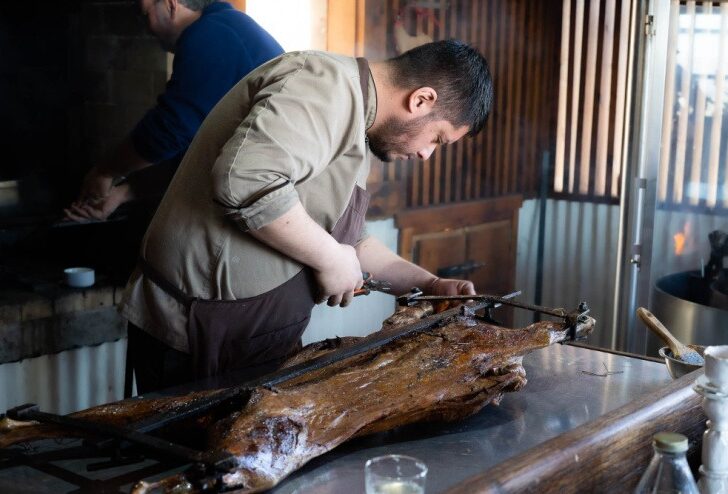
In Patagonia, cordero al palo can be enjoyed at El Asador Patagónico in Puerto Natales. In the capital, head to El Mesón de la Patagonia in Lo Barnechea, the northeast corner of Santiago.
Seafood dishes
Pastel de jaiba.
This bready casserole is a favorite both on the coast and in Santiago, and contains blue crab in a cream and white wine-based mixture, topped with grated cheese. Traditionally prepared in a clay pot, chili peppers can be included for an added zing.

Pastel de jaiba is best sampled seaside in the surf town of Pichilemu at Costa Maria or in Valparaiso at Porto Viejo . In Santiago, an excellent version is served at El Ancla Providencia .
Empanada de jaiba/camarón
For those who love a good pastie, you’re in luck! Chile has a great variety of them. This version has either jaiba (crab) or camarón (prawn) covered in melted cheese. An empanada de mariscos (seafood) is a mixture of the two.
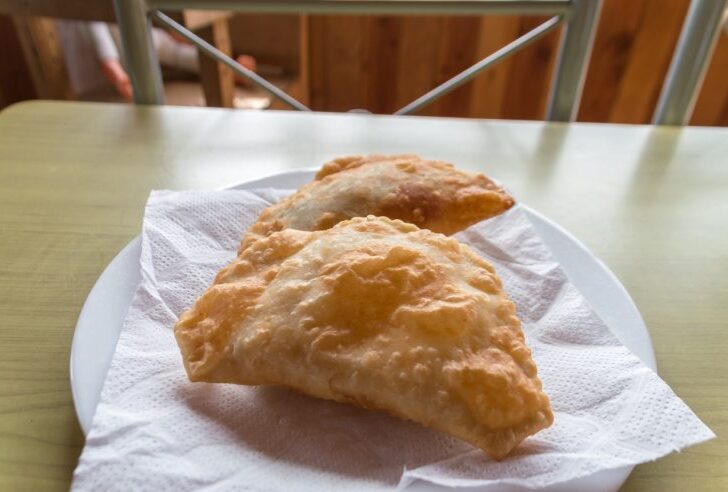
For an added kick, spoon some pebre over the top. Empanadería San Luis in Santiago and Delicias Express in Valparaíso make excellent ones worth seeking out.
Machas a la parmesana
Chileans love shellfish. The large quantity and variety of bivalves have made them a popular food for snacks or meals. Machas (razor clams) are common in many seafood restaurants, and in this dish they are cooked in butter and white wine, then topped with either melted parmesan or mantecoso cheese.
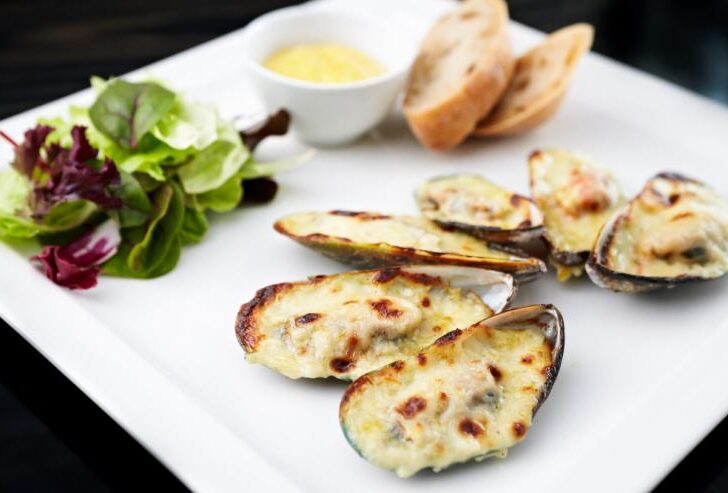
The aforementioned restaurants in Pichilemu, Valparaíso, and Santiago are a good bet for ordering a large platter of machas a la parmesana, which are perfect in the summer months paired with a sauvignon blanc or dry rosé.
Gambas al pil pil
This Spanish-inspired dish has become increasingly popular in recent years. Prawns are fried in garlic butter and prawn tail sauce and served sizzling. Some restaurants add smoky merkén chili powder for an added dimension.
Marisqueria Tahiti in Barrio Yungay is a great place to try gambas al pil pil and just about any other seafood dish popular in Chile.
Caldillo de congrio
Chilean poet and noble laureate Pablo Neruda so enjoyed this dish that he wrote an ode to it. Conger eel is cooked in a garlicky fish head broth with clams and mussels. Round off the meal with a glass of sauvignon blanc and you may begin to understand Neruda’s obsession.
The ideal place to find this emblematic delicacy is Bocanáriz in Bellas Artes, Santiago, where the food is matched by its impressive selection of Chilean wines.
Curanto en hoyo
Chiloé Island, between Central Chile and Patagonia, has a unique atmosphere and its own traditional gastronomy. Perhaps the most famous of its dishes is curanto en hoyo, an ancient preparation comprising several types of seafood, meat, and vegetables, covered in leaves and cooked in a hole in the ground.
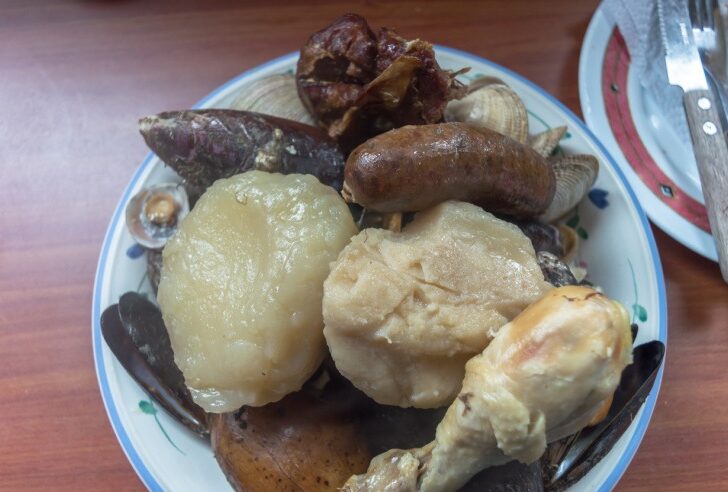
Ingredients can vary, but it’s common to use loganizas (a chorizo-like sausage), chicken, shellfish, and potatoes. Because of the difficulty of its preparation, this is generally a meal made for special occasions. For the real deal, make the schlep to Fogon Chilote “El Chucao” an hour northeast of Castro on Chiloé. A more easily accessible place to try good curanto is Chiloentumesa in Barrio Italia, Santiago.
Ceviche con palta
Visitors quickly find that Chileans love avocados. Many, many dishes are complemented with palta, and ceviche, a dish loved in many South American countries including Peru , is one of them.
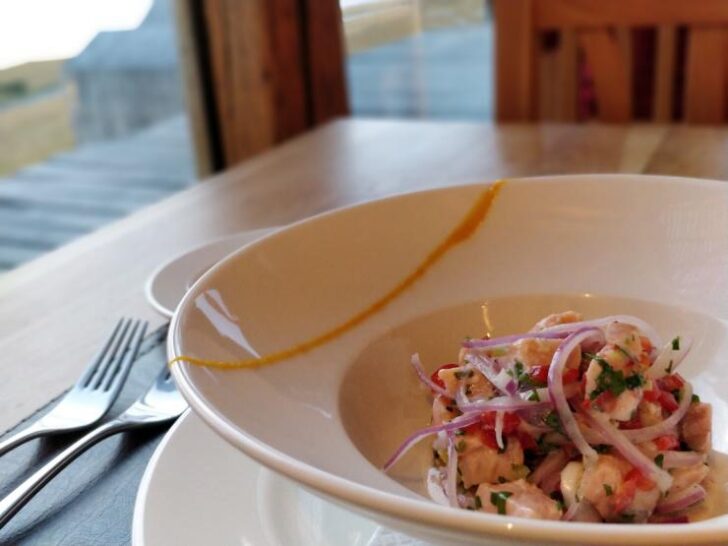
A popular version is similar to a poke bowl with salmon ceviche and various veggies including tomato and onion, while on Easter Island , you’ll find it made with ocean-fresh tuna. The citrusy ceviche marinade, made from lemon juice ties it all together, and after you’ve tried it you may wish to try making it yourself!
For a taste of this ceviche variant, along with other Peruvian-Chilean fusion dishes, head to Mistura del Perú in Barrio Italia.
Vegetarian dishes
Porotos granados.
Although Chileans often eat a lot of meat, there is plenty on offer to suit vegetarians as well. This stew is a popular choice in the summer and combines kidney beans, pumpkin, corn, garlic, and basil. A heartier version, porotos con riendas, adds noodles, and a thinner version with a whole corn cob is called pilco.
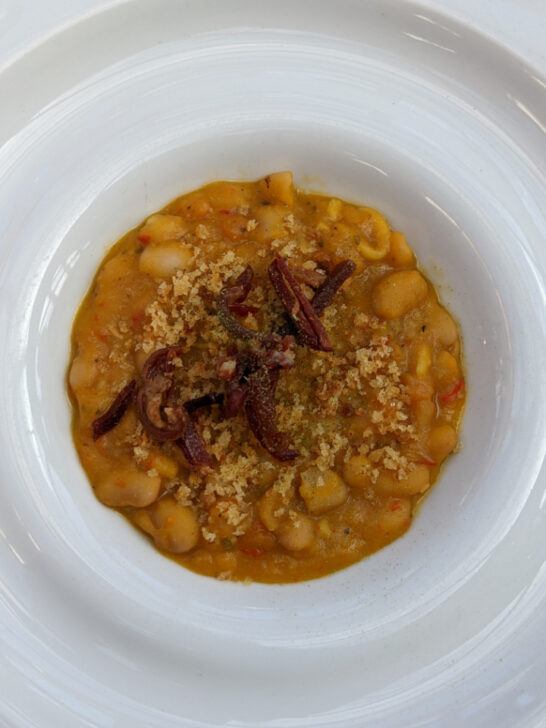
There are countless restaurants serving porotos granados, but where better to try it than Palacio del Poroto in Estación Central, Santiago.
Chancho en piedra
This unusually named dish actually means “pig on stone”, when in fact no meat is used at all in its preparation. Originally named chanco de piedra, the action of mashing ingredients against a stone, people started calling it chancho as a joke.
This tomato-based sauce is made with onion, garlic and olive oil and is great as a spread on bread with cheese. Try it at the upscale Quitral in Bellas Artes, Santiago.
A popular lunch or onces (elevenses) food, humitas are a mixture of mashed corn, onion, garlic, and basil wrapped in corn husks and steamed. They are often enjoyed with pebre or chancho en piedra.
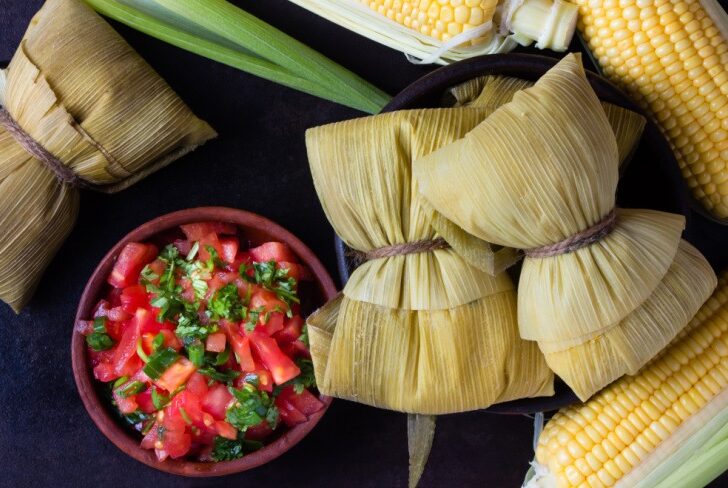
Humitas are generally Chilean street food and can be found all over central Santiago rather than in restaurants. You’ll find them in and around Mercado Central in the city center.
This potato bread originated in Chiloé, and is good with chancho en piedra. It is made with potato flour and is quite filling; ideal for cold winter nights in the south. Chapalele is similar to milcao, but with eggs added to the potato flour.
Both these types of Chilean bread are freshly made at Chiloentumesa in Barrio Italia.
Ensalada de digüeñes
This seasonal dish is quite unique in Chilean cuisine. In the southern temperate rain forests, digüeñe mushrooms grow on beech trees during the winter months. They have a unique texture and are prepared with onion, garlic, oil and coriander.
Although difficult to find because of its limited availability, Peumayén Ancestral Food has digüeñe salad in August and September.
Chilean beverages
Chilean wine.
In the last half-century, Chilean viticulture has gained rightful renown for its high-quality vinos. While they offer many of the varieties found elsewhere in Europe, make sure to try carmenere and carignan reds, which all but disappeared from Europe hundreds of years ago.
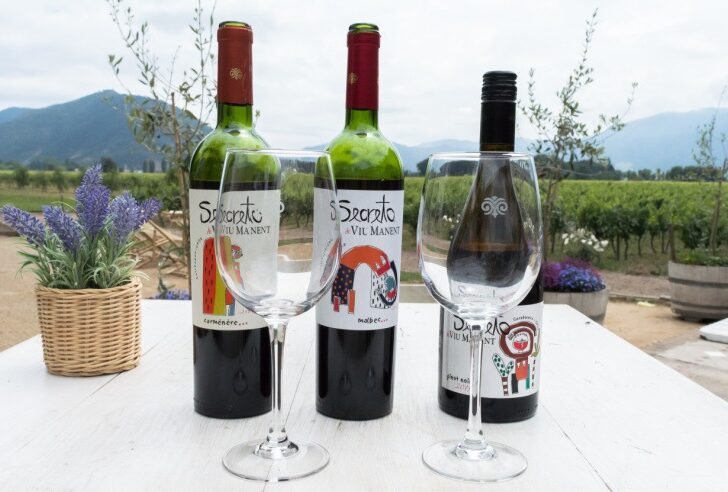
Good places in Santiago to sample excellent wine from around the country are Bocanáriz in Bellas Artes and La Vinocracía in Ñuñoa.
Peru and Chile have a centuries-old feud over who began distilling this popular grape brandy. More importantly, each country is now making outstanding pisco both for sipping on its own or in the ubiquitous pisco sour cocktail.
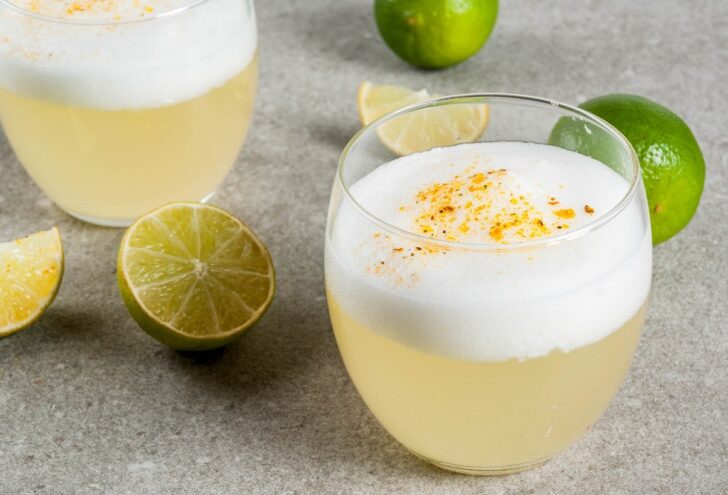
While probably every bar in the country serves pisco, a perfect place to learn about and enjoy the spirit is Chipe Libre República Independiente del Pisco in Bellas Artes, Santiago. In Patagonia, you can be sure to find a local take on this ubiquitous drink: the calafate sour.
Cola de mono
A favourite Christmas liqueur, “monkey tail” is a sort of Chilean white russian, made with aguardiente (similar to grappa), milk, coffee, sugar and cloves.
While many people buy the premixed store-bought variety, premium versions are made at bars around Chile during Christmas festivities.
Sopaipillas
A favorite throughout Chile, sopaipillas are sweet fried dough with pumpkin and are among the most popular street foods. You’ll find them at seemingly every street corner so you’ll have lots of opportunities to try different varieties including pasá, with orange peel, clove, and potato flour.
Pan de Pascua
For whatever reason, Chileans generally refer to Christmas as Pascua, even though Pascua is in fact Easter. So while this “Easter bread” ought to be prepared in March or April, you’ll typically find it in bakeries in December.
Also confusingly, this isn’t actually bread, as it’s a sponge cake made with batter, honey, ginger, walnuts, almonds, and raisins. Regardless of the name, it’s quite the holiday sweet treat. A fabulous pan de pascua can be had at La Ermita in Vitacura District, Santiago.
Mote con huesillo
This could be classified as food, beverage, or dessert, and really hits the spot on a hot summer day. Mote con huesillo is wheat-based with brown sugar and dried peaches. The popular treat is found on many dessert menus in restaurants and is sold by street vendors in cities around the country.
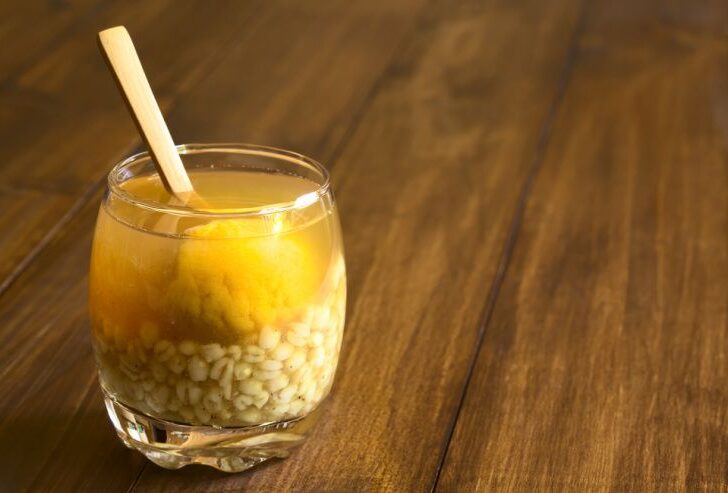
They’re found everywhere, but Mote con huesillo Patagual near Parque O’Higgins in Santiago specializes in them.
Ready to sample some of Chile’s most delectable dishes?
In conclusion, Chilean gastronomy reflects the unique natural setting. A trip from north to south shows how the cuisine is influenced by the bounty of the land and sea.
While Santiago is at the cutting edge of Chile’s restaurant scene, other cities around the country offer a surprising range and quality of dishes. A generation ago, Chile was considered a culinary backwater compared to its neighbors, but this is no longer the case.
Importantly, Chile’s top restaurants are no longer Peruvian or French. By forging its own path, Chile is creating something all its own for everyone to enjoy. Find more inspiration for where to go to enjoy the best Chilean dining in this guide to the most unmissable things to do in Chile .

32 Chilean Foods: Guide to Food in Chile (Dishes, Drinks, Desserts)
Chile is famous for its seafood and its wine. What other Chilean food can you expect on your travels there? Please keep reading, and prepare to get hungry.
25 Chilean Food Dishes
Chile is a long and narrow country nestled between the Andes Mountains and the Pacific Ocean. While it averages only 110 miles (177 kilometers from East to West), it is 2,653 miles (4,270 kilometers) from North to South. Containing deserts, tropics, and even icecaps, Chile sure does have a lot of different landscapes.
But you may ask, ‘what does any of that have to do with food?’ Well, the unique geography of Chile means that a wide variety of crops can be grown there. Not to mention the abundance of seafood available along the long stretch of coastline.
1. Porotos con Riendas
This Chilean dish is literally translated beans with reins (like the kind of reins you use when riding a horse). The beans are boiled, and the “reins” are spaghetti noodles.
Chorizo sausage, diced pumpkin, chili peppers, and onions are added to complete the dish.
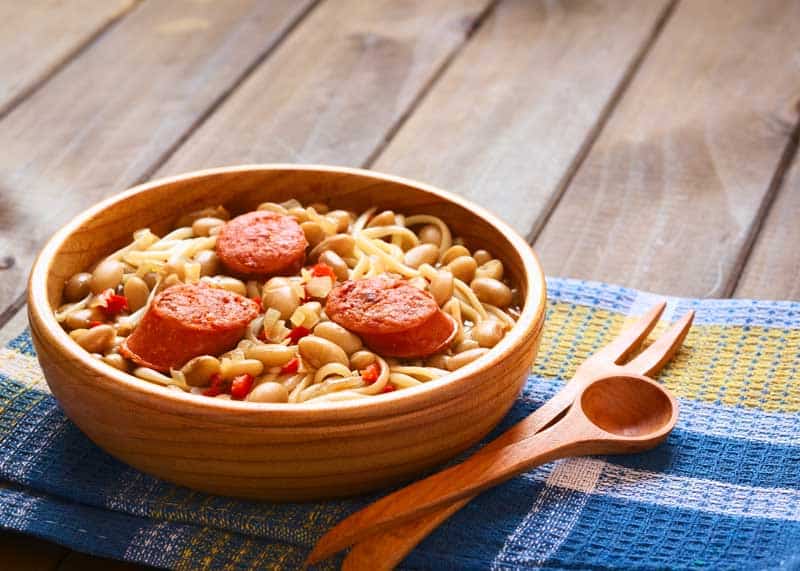
2. Empanadas de Pino
An empanada is a baked pastry filled with yumminess. In Chile, empanadas are typically filled with beef. But there are also a few surprise ingredients like raisins, olives, and hard-boiled eggs. Paprika, cumin, pepper, and salt round out the flavor.
Try dipping them in salsa, or just grab one in your hand for a great snack on the go.
3. Curanto al Hoyo
Curanto al Hoya is a fun dish because it is cooked on top of heated stones in a hole (hoyo) in the ground. Its origins date back to before the Spanish colonization of South America. It can also be cooked in a pot above ground ( Curanto en Olla ).
The ingredients include meat, potatoes, and an assortment of vegetables. Each layer is kept separated by leaves (either Naica, Fig, or Cabbage leaves).
And seafood is also essential. Shellfish used include almejas (clams), cholgas (ribbed mussels), and picorocos (giant barnacles).
Pebre isn’t a meal on its own, it’s a condiment. This salsa varies from region to region and even from home to home. But the main ingredients are cilantro, garlic, onions, olive oil, red wine vinegar, and aji chili peppers. Try it on bread, meat, or on many other foods.
5. Churrasco
Bread is plentiful in Chile, as are sandwiches, or “Sanguches.” Churrasco is a grilled steak sandwich. Typical add-ons may include tomatoes, onions, cilantro, and chili peppers.
The Churrasco is a building block to creating many different sandwiches. For example, adding mayonnaise, tomato, and Palta (mashed avocado with salt and olive oil) to the steak makes an Italiano Sandwich. The white, red, and green of the toppings match the colors of the Italian flag.
6. Carne Mechada
Carne Mechada is a Chilean-style pot-roast. One of the meanings of Mechada is “stuffed.” To make this pot roast, you make holes through the meat using a metal skewer.
Stuff one hole with carrots, and another with peppers, another with garlic, and another with onions. The roast is slowly cooked, simmering in water and wine. The slices of this roast make for a truly interesting cross-section.
7. Pastel de Choclo
This main dish is a corn and beef casserole. The bottom layer is made by cooking ground beef flavored with onions, paprika, cumin, salt, and pepper. The creamy top layer is made from corn and milk, with a hint of basil.
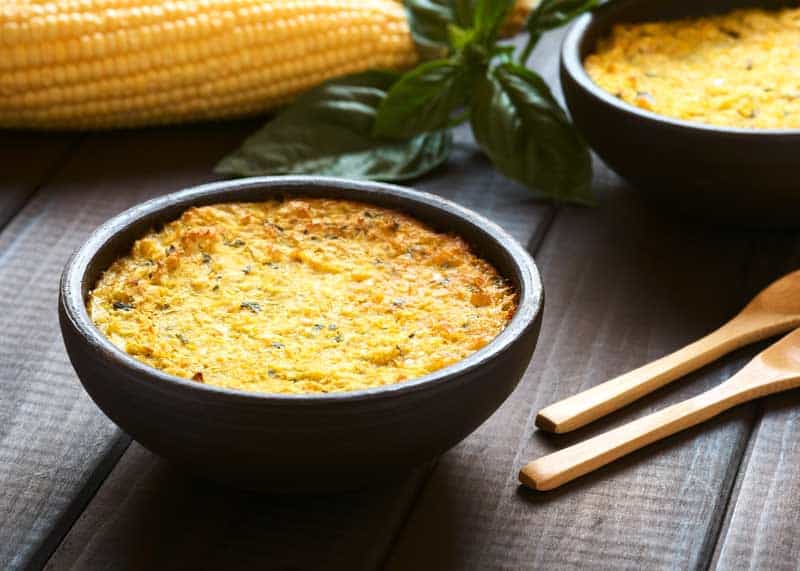
8. Pastel de Centolla
Centolla is the name of the King Crab which inhabits the cold waters of the southern tip of Chile. Pastel de Centolla is a thick and rich stew. Bread, milk, cream, white wine, grated carrots, and finely chopped red peppers are all part of this stew. To finish the dish, grated parmesan cheese is added.
This stew may be served in a clay bowl, but sometimes it is ladled back into the crab shell. If you’re a lover of seafood, this is one dish you must try.
9. Pastel de Jaiba
You may also see this dish on the menu as Chupe de Jaiba. Similar to the dish described above, this is also a creamy crab stew/casserole. The difference is in the type of crab used. While Centolla is found in the South, Jaiba is a rock crab that is found in the Northern parts of the Chilean coastline.
Asado is barbequed meat, and the Chileans know what they are doing! It’s flavorful, crispy, and juicy. Beef is common, along with chicken, pork, or even goat.
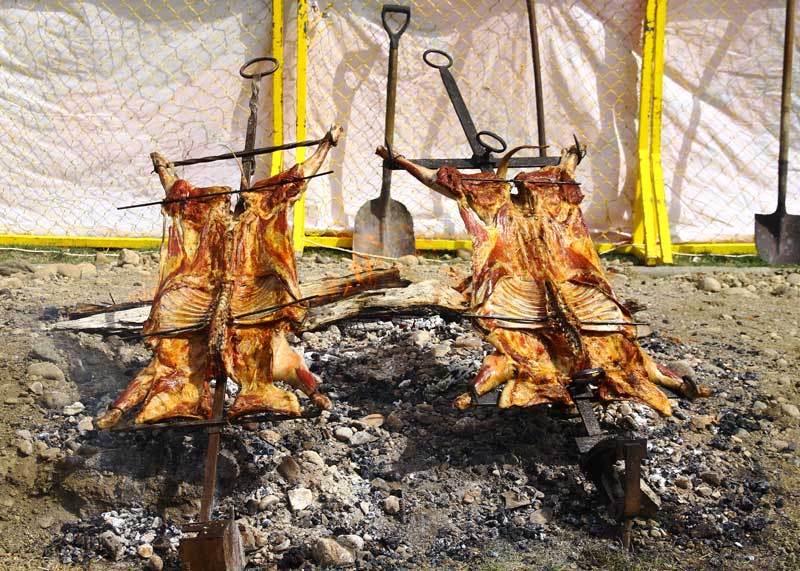
11. Cazuela
Cazuela is a traditional chunky soup, with a lot of flexibility in the recipe. Beef is often used but can be replaced with lamb, chicken, or pork. The vegetables used vary by the season and the region. Each serving should include the broth, a piece of meat, a whole peeled potato, and a section of corn on the cob.
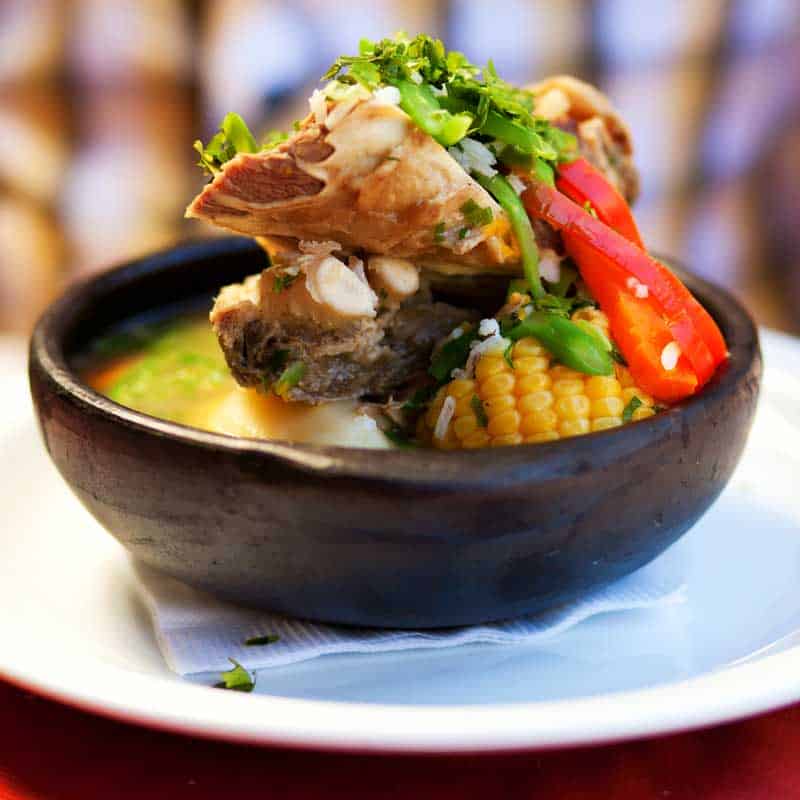
12. Humitas
These steamed corn tamales are typically made with freshly ground corn, onions, basil, and butter. After the dough has been prepared, it is wrapped in corn husks and placed in a pot of boiling water.
They can be served sweetened with sugar, or savory with chili peppers and salsa.
13. Sanguche de Potito
This popular sandwich is sold by many street vendors and can readily be found outside of the Estadio Nacional on game day. The Potito meat comes from the rectum or intestines of a cow. The Potito is fried with onions and served on a bun with condiments such as ketchup, mustard, mayonnaise, and pebre.
While it may not sound appealing, those who try it often come back for seconds.
14. Sopaipilla
Another popular street food, Sopaipillas are small flatbreads fried in oil. Traditionally the dough includes flour, and squash which gives it an orange color.
They can be served in a variety of ways. Savory options include mayonnaise, ketchup, avocado, and pebre salsa. If you prefer a sweet treat, try them sprinkled in icing sugar, or dipped in jam or manjar (dulce de leche), or soaked in syrup.
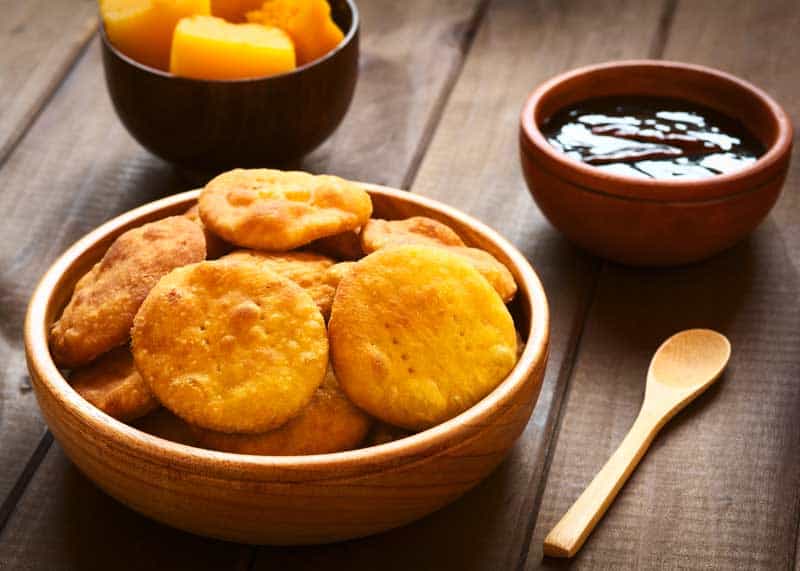
15. Chapalele
Chapaleles are a traditional bread made from wheat flour and potatoes. This recipe comes from the Chiloé Archipelago to the South of Chile where potatoes grow in abundance.
They can be steamed underground as part of a Curanto meal (see number 3). Other variations include frying in oil, pan-frying, or baking.
While in the Chiloé Archipelago, another food to try is Milcao. Like Chapaleles, these pancakes also make use of the potato, but without the flour. Instead, they are made with a combination of mashed potato and grated potato. Lard and seasonings are added to make a dough.
They can be eaten savory by adding chicharron (crispy pork) to the dough before cooking. They can also be kept neutral in flavor, or made sweet.
17. Bife a lo Pobre
If you like eating breakfast for dinner, this is the dish for you. It is comprised of a beef tenderloin steak and French fries, topped with a fried egg.
This dish is also known as Lomo a lo Pobre or Bistec a lo Pobre.
18. Choripán
Mashing together the words Chorizo (a type of sausage) and pan (the Spanish word for bread), this dish is as it sounds- a sausage on a bun. Popular throughout South America, in Chile the sausage is topped with Pebre salsa.
Hot sauce can also be added if you’re looking for an extra kick of flavor.
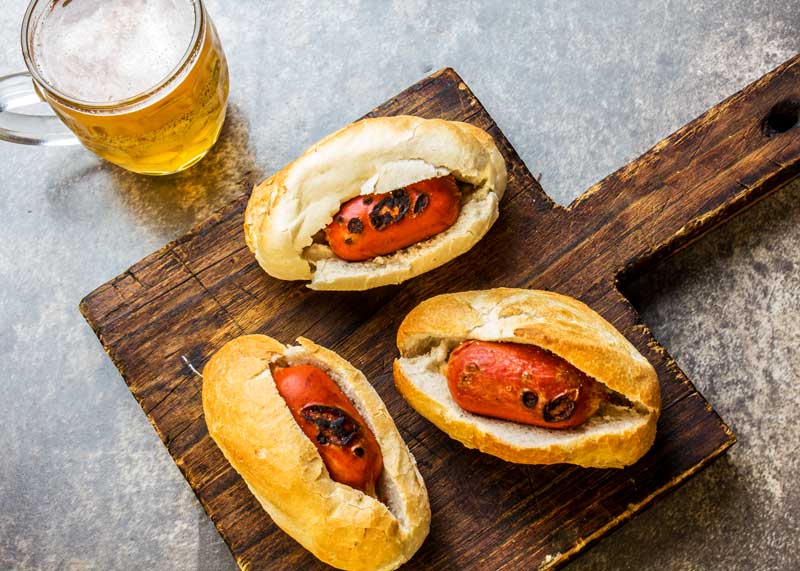
Scientifically called Concholepas Concholepas (yes it’s the same word twice), Locos (Spanish for Crazy) is a species of large edible sea snails.
Popular recipes include Locos with Mayonnaise, Locos Chowder, and Locos empanadas.
20. Chupe de Mariscos
This thick seafood chowder is made with broth, milk, and wine, and thickened with flour. Some of the seafood used may include shrimp, clams, Locos (see above), and crab.
After being cooked in a pot, the stew is ladled into dishes and topped with a layer of cheese and breadcrumbs. Then into the oven it goes to brown to perfection.
21. Caldillo de Congrio
This is a fish soup made using Chilean Conger Eels. Included in the recipe are onions, tomatoes, cream, cilantro, white wine, cilantro, paprika, and garlic.
22. Mariscal Caliente
This soup is a celebration of the seafood available in Chile, especially in the Central and Northern parts of the country. Unlike some of the other seafood dishes that are served creamy, Mariscal is made with a lighter broth.
There is also a cold version made with the addition of cilantro and lemon juice. It’s similar to ceviche, a very popular dish in it’s neighbor to the north, Peru.
23. Arrollado de Malaya
The creation of this classic Chilean dish starts with marinating and flattening a piece of beef. It’s then stuffed with carrots and hard-boiled eggs, and rolled into the shape of a log. Then it is fried in a pan.
Arrollado de Malaya (or Malaya Rellena) is sliced and served cold. It can be served inside a sandwich. Or with a potato or tomato salad. Great for when you want something good to eat on a hot day.
24. Charquican
Charquican is one of the oldest Chilean dishes on record. It’s a mash of meat (often ground beef), onions, squash, potatoes, and other seasonal vegetables. It’s flavored with cumin, paprika, and oregano. In many places, it is served with a fried egg on top.
25. Longanizas con Puré Picante
Sausages are very common in Chile. In this dish, the sausage is served with a creamy and spicy (from the addition of chili paste) mashed potato.
Chilean Street Food
Take a tour of Chilean street food in the streets of Santiago, with Delightful Travelers.
4 Chilean Drinks
Now that you have a good idea of what to eat in Chile, what will you drink?
When the Spanish Conquistadors came in the 16th Century, they brought grapevines with them.
Later, in the mid-19th Century, French wine varieties were introduced. And Chile has proved to have very productive vineyards. Why not tour one while you’re there?
- Carmenère, Cabernet Sauvignon, and Merlot . Originally grown in France, the grapes for producing these wines all grow very well in Chile.
- Chinca . Chinca is a sweet wine made using fermented apples or grapes. It is most commonly consumed on Chilean Independence Day (September 18th).
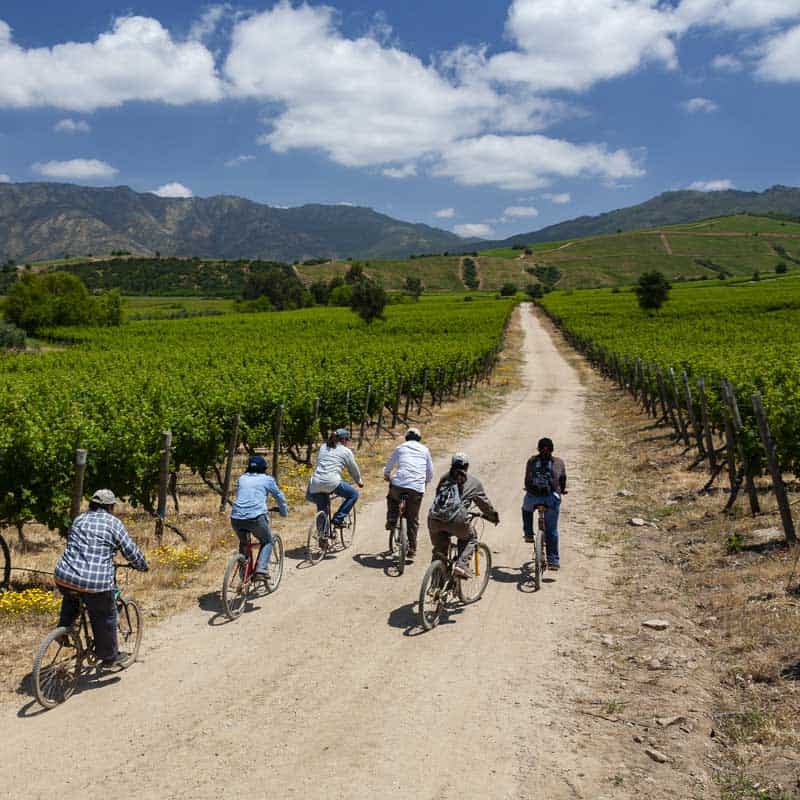
If you’re trying the wine, don’t forget to try Borgoña. This popular punch is made by combining red wine with strawberries. Sugar can also be added depending on your taste.
3. Pisco Sour
Know as Chile’s National Spirit, this alcoholic drink is quite refreshing. Peru also considers the Pisco Sour to be it’s national drink, but there are some key differences.
Chile’s version is made using Chilean Pisco Brandy, lemon juice, sugar, and ice. Peru’s version includes the addition of egg whites and bitter drops.
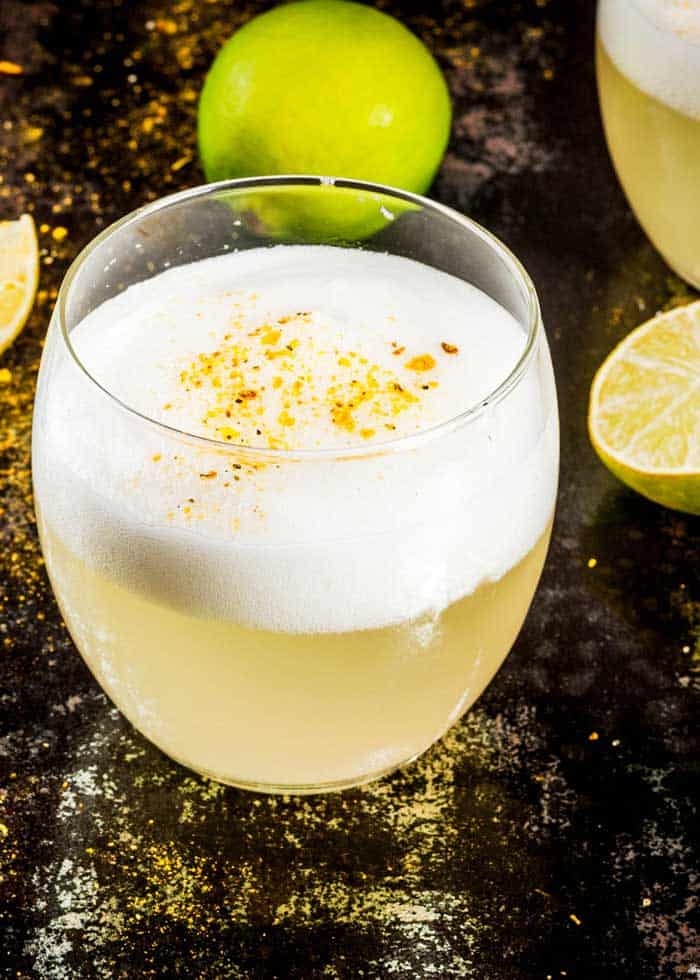
4. Mote con Huesillo
If you’re looking for something non-alcoholic and refreshing, look no further. This is one of the most popular drinks that you will find during your travels through Chile.
The name Mote con Huesillo roughly translates into Wheat (Mote) with Peaches (Huesillo). It’s made by taking husked wheat and dried peaches and soaking them in sugar water with cinnamon.
You’ll find this drink everywhere, from restaurants to street vendors. It’s definitely a part of the complete Chilean experience.
More reading: Try these 25 Bolivian Foods
3 Desserts to Try in Chile
Earlier we touched on breads like Sopaipillas and Milcaos that can be served either sweet or savory. What are some other sweet treats that you should try in Chile?
1. Leche Asada
This sweet and rich dessert contains milk, eggs, vanilla, and sugar. It’s similar to flan, but rather than be smooth on the top, Leche Asada has a crispy custard layer on top (because it is baked in the oven). That’s how it got its name, “Roasted Milk.”
2. Torta de Mil Hojas
This cake of “1000” layers is made from layers of thin puff pastry. In between the layers you will find ingredients like Manjar (caramelized milk also called dulce de leche), and jam. It is usually topped with crushed walnuts.
3. Turrón de Vino (Dessert)
In a country known for its wine, it’s inevitable that some of its best desserts would also contain wine. This dessert is a silky meringue.
To make it, start by combining wine, cloves, cinnamon, lemon peel, and sugar in a pot. This mixture is then reduced to a syrup over medium heat. After sifting, the syrup is folded into fluffy egg whites. Serve with whipped cream and walnuts on top.
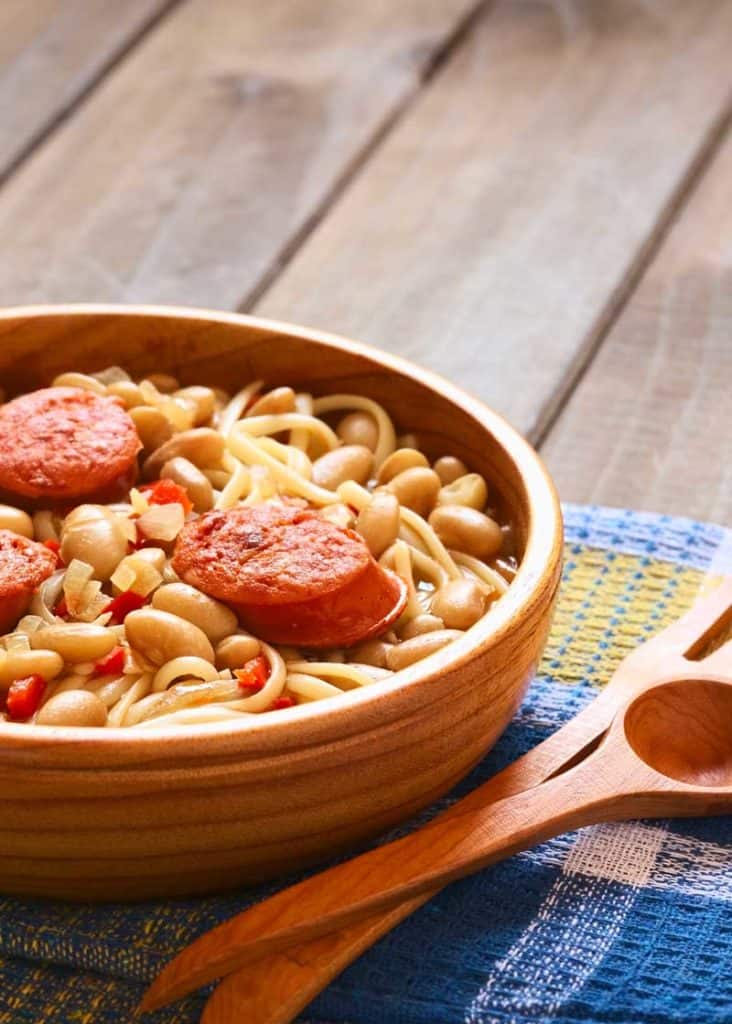
Learn more about these dishes from neighboring Peru .
And there you have 32 delicious Chilean foods to try. Have you been to Chile? What is your favorite dish, drink, or dessert from this wonderful country? Let me know in the comments below.
Hello, I'm Diane Diegor . I'm a travel and nature enthusiast. I love learning about other cultures and tasting their food.
I'm a regular contributor to Storyteller Travel .
Similar Posts

10 Tips for Shopping at an Open Market in Ecuador (11 Spanish Phrases)
The attraction for many gringos, of traveling and living in a foreign country, is the thrill of traditional open markets. When we first arrived here, we heard everything from: “everything is so cheap” and “its such nice / fresh / beautiful / unique products here” to “don’t go there – you’ll get robbed or mugged”…

Guide to Mall del Rio in Cuenca Ecuador (Maps and Photos)
Today, we’re going to visit Mall del Rio in Cuenca, Ecuador. The largest mall in the city, Mall del Rio, will have you wondering if you even left your hometown. This probably isn’t what you thought would be in Ecuador’s Andes Mountains. A large multi-screen theater, bowling alley, huge food court, and over 220 other…
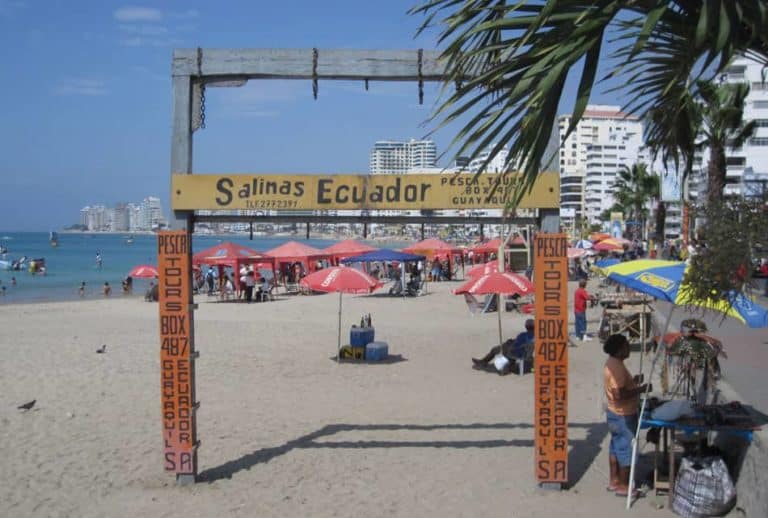
Guide to Visiting Salinas Ecuador: How’s the Beach?
Ecuador is for hiking and jungle exploring – right? Who goes to Ecuador for the beach? That’s what Mexico and Aruba and the D.R. is for, isn’t it? Check out this new video – and let us know what you think. This guide is a work in progress. We’ll be updating this in the coming…
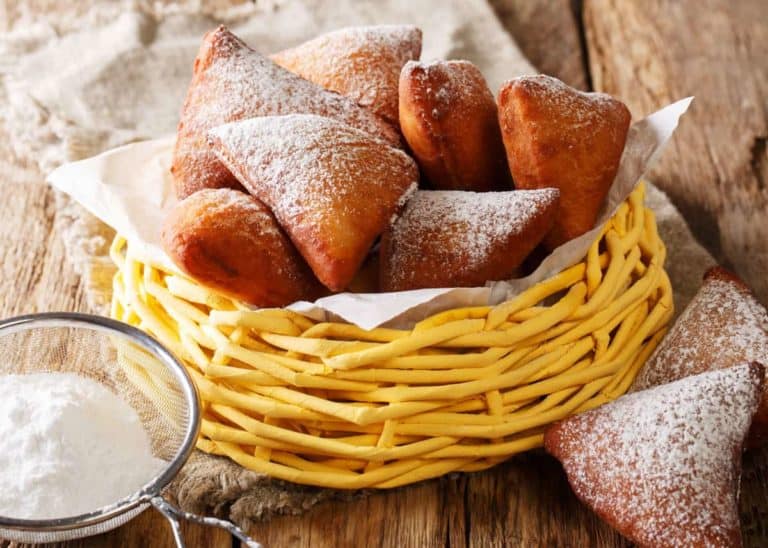
Uganda Food Guide: 17 Must-Try Dishes for Your Visit
Curious about what Ugandan food is like? In this Uganda Food Guide, you’ll learn about breakfast, lunch, and dinner – and sauces, desserts, and beverages from around the country – with 10 videos that include recipes and tips for preparing your own. You’ll also learn about the three places to try local food. Uganda Food…

7 Best Portable Water Filters & Travel Purifiers: 7 Factors Compared
If you’re traveling to rural areas abroad, you need to decide how you’ll filter your water supply. In this huge guide, you’ll learn how to choose the best portable water filter and purifier for your travels. We include factors to consider, plus common water risks, and answer commonly asked questions about water. How to Choose…

How to Send and Receive Mail and Shipments in Ecuador
We receive lots of review materials. Mostly books, but some software too. Some publishers are hesitant to ship to Ecuador, telling me that their shipping department is “unable” to ship out of the US. Other publishers (especially Wiley) must have broken the difficult shipping secret because I regularly receive review copies from them. I have…
Leave a Reply Cancel reply
Your email address will not be published. Required fields are marked *
Where to find the best eating and drinking experiences in Chile

Oct 13, 2022 • 5 min read

Sample Chile's most incredible dishes and drinks at restaurants and distilleries across the country © cokada / Getty Images
Ancient Andean recipes and the seafood bounty of the Pacific Ocean are essential elements of the cuisine in Chile . Traditional restaurants fire up iconic dishes that transform corn, potatoes and other staple ingredients into works of art, while vibrant markets dole out time-tested favorites and some of South America 's best street food.
Given the wide-ranging climate and geography, food and drink in Chile vary considerably from region to region. You’ll find desert recipes, unique island cooking techniques and a growing number of restaurants catering to plant-based diners.
Here are the best things to eat and drink in Chile.
Tuck into pastel de choclo
One of Chile’s most popular dishes is pastel de choclo , a hearty casserole that’s something of a South American shepherd’s pie. This comfort-fare classic features hard-boiled eggs, olives, and ground beef or chicken, along with all-important creamed corn dough ( choclo ) that binds it all together and gives the dish a warm sunny glow.
Where to try it: Nearly any respectable Chilean restaurant will serve up a memorable pastel de choclo , but it’s worth heading to elegant Donde El Guatón in La Serena for one of the country’s best.


Indulge in a curanto feast on the Chiloé Archipelago
Head to the mist-shrouded islands of Chiloé to experience Chile's unique culinary traditions, including curanto . This extraordinary dish, which likely predates the arrival of the Spanish, is traditionally prepared in earth ovens. Stones, heated in a bonfire until red hot, are set in a hole in the ground.
The ingredients are then directly piled on. Shellfish, pork and chicken are added first, followed by chapaleles (a kind of potato dumpling), various vegetables, and the leaves of the nalca (a rhubarb-like plant). The whole mixture is covered and left to simmer for a couple of hours. Then the feasting begins!
Where to try it: Many places around the archipelago serve curanto , though one of the best is fired up at Restaurant Quetalmahue , located in a small fishing village (also called Quetalmahue) around 15km (9 miles) west of Ancud.
Bite into desert fruits in the Atacama
Famous for its shimmering salt lakes, sputtering geyser fields and otherworldly rock formations, the parched landscapes of the Atacama desert also contain some hidden culinary specialties. The indigenous Atacama people enjoy dishes like patasca , a stew made of pork or beef, potatoes, onions and a white corn unique to the region. You can also find desert produce like pepino dulce , a striated oval-shaped fruit that tastes like a cross between a melon, pear and cucumber.
Where to try it: In the adobe-walled town of San Pedro de Atacama , you can taste desert herbs, plants and cooking traditions at the restaurant Baltinache. When the heat soars in the afternoon, head to Heladeria Babalú , an ice cream shop featuring desert fruit flavors as well as Chilean hits like pisco sour.

Snack on Chile’s best street food
Although you’ll find empanadas in other parts of Latin America, chilenos whip up some of the most heavenly versions you could bite into. The simple but widely loved street food is a breaded turnover (pasty) that’s stuffed with meat, cheese, seafood or veggies and then baked or fried.
The most traditional empanada is stuffed with pino , a combination of ground beef, onions, black olives, hard-boiled eggs and raisins. You’ll also find empanadas made with seafood, Italian-style combinations (with cheese and tomato) and many other varieties.
Where to try it: Specialty empanada shops are widespread in Chile, but you can also find them in markets and even sold by vendors on some city streets and plazas. If it’s variety you're after, head to Delicias Express in Valparaíso , where you’ll find some 80 different types of empanadas. On the other side of town, Empanadas Las Famosas also has a loyal following, particularly for its weekend-only seafood empanadas.
Sip a pisco sour after visiting a historic distillery
The rolling hills of the sun-baked Elqui Valley are crisscrossed with vineyards, which make up the heart of Chile’s most important pisco-producing region. Chile’s national drink is pisco, a high-proof brandy made from muscat grapes. Unlike in Peru (which also claims the spirit as their own), Chilean winemakers sometimes age their piscos in wood — often French or American oak — which gives a more golden color and can impart flavors of vanilla, maple syrup or more floral notes.
Where to try it: In the charming town of Pisco Elqui, you can learn all about the production of Chile’s iconic drink at Destileria Pisco Mistral . Afterward, sip a refreshing pisco sour in the garden. Another great place to sample high-quality piscos straight from the source is Fundo los Nichos , an artisanal producer that's been around since 1868.

Savor seafood delicacies all along the coast
No matter where you roam in Chile, you won’t be far from the ocean in this pencil-thin country with a coastline stretching more than 4200km (2610 miles). The bountiful Pacific in its backyard gives Chile some of its best-loved staples, which include loco (abalone), erizos (sea urchins), machas (razor clams), jaibas (crabs), ostiones (scallops) and congrio (conger eel), plus yellowfin tuna, corvina, merluza (hake) and numerous other fish.
Look out for seafood stews like paila marina , made of shellfish, tomatoes, herbs and spices.
Where to try it: Seafood lovers can hit vibrant mercados de mariscos (seafood markets) on or near the coast all the way from Arica in the north to Valdivia in the south. A great place to start is Santiago ’s Mercado Central , which is famous for its seafood restaurants — Donde Blanca is one of the best.
Vegetarians and vegans
Chile leans pretty heavily on meat and seafood when it comes to restaurant menus. With a bit of ingenuity, however, you can eat well while still following a plant-based diet. Chileans love their breads, which you can then top with pebre , a salsa made of olive oil, onions, coriander, garlic and aji peppers.
Humitas are steamed or boiled corn cakes that are served wrapped in corn husks (they’re usually made with vegetable oil, but some cooks use lard). Porotos granados is a traditional stew made of cranberry beans, corn, squash and sometimes pumpkin. You can also make a meal of empanadas, with many places offering vegan options.
In bigger cities like Santiago, Valparaíso and major tourist destinations (like San Pedro de Atacama and Puerto Varas ), you'll find a good selection of places serving vegetarian and vegan-friendly dishes.
Explore related stories

Tips & Advice
Oct 9, 2022 • 6 min read
Brazil has a startling variety of regional specialties, and food-focused travel here is a rewarding experience. Here's what to eat and drink in Brazil.

Aug 23, 2024 • 7 min read

Aug 11, 2024 • 6 min read

Jul 31, 2024 • 4 min read

Jul 30, 2024 • 7 min read

Jul 30, 2024 • 8 min read

Jun 30, 2024 • 11 min read

Jun 28, 2024 • 7 min read

Jun 10, 2024 • 6 min read

Jun 4, 2024 • 7 min read

- Huasco Valley
- San Pedro de Atacama
- Elqui Valley
- Antofagasta
- Limarí – Fray Jorge National Park
- Bahía Inglesa
- Alto El Loa
- La Serena and Coquimbo
- Copiapó Valley
- Tagua Tagua – Almahue Valley
- Alto Colchagua Universidad Glacier
- Cachapoal Valley
- Portillo Ski Resort
- Pirque and Maipo Valley
- Aconcagua Valley
- Valle Nevado Ski Resort
- El Colorado Ski Resort
- Curicó Valley
- Maule Valley
- San Antonio/Leyda Valley
- Colchagua Valley and Santa Cruz
- Casablanca Valley
- Viña del Mar
- Cajón del Maipo
- Robinson Crusoe Island
- Rancagua and Sewell
- La Parva Ski Resort
- Rano Raraku
- Llanquihue Lake
- Chillan Ski Resort
- Puerto Montt
- Osorno and Puyehue
- Valdivia and Corral
- Pucón and Villarrica
- Panguipulli
- Temuco and Lago Budi
- Arauco Territory
- Puerto Varas
- Chilean Antarctic Destination
- General Carrera Lake
- Tierra del Fuego
- Coyhaique and Puerto Aysén
- Carretera Austral
- Torres del Paine
- Puerto Natales
- Punta Arenas
- Family recreation
- Coastal beaches
- Lakeside Beaches
- Hot Springs
- Spa and relaxation
- Patagonian cruises
- Lake sailing
- International cruises
- Visits to observatories
- Astronomical facilities
- Indigenous Peoples and Ethnotourism
- World Heritage Sites
- Archaeology
- Paleontology
- Poetry and Literature
- Typical gastronomy
- Gastronomy of the world
- Hiking y trekking
- Skiing and snowboarding
- Mountainbike
- Horseback Riding
- Mountain and rock climbing
- Sport fishing
- Kitesurfing and water sports
- Ice walking
- Overland 4×4
- Paragliding and aerial sports
- Wildlife watching
- Landscape photography
- National Parks
- Bird Watching

Chilean Food: 5 dishes of our nation’s gastronomy you must try
By: Hernan Claro - 11 July, 2024
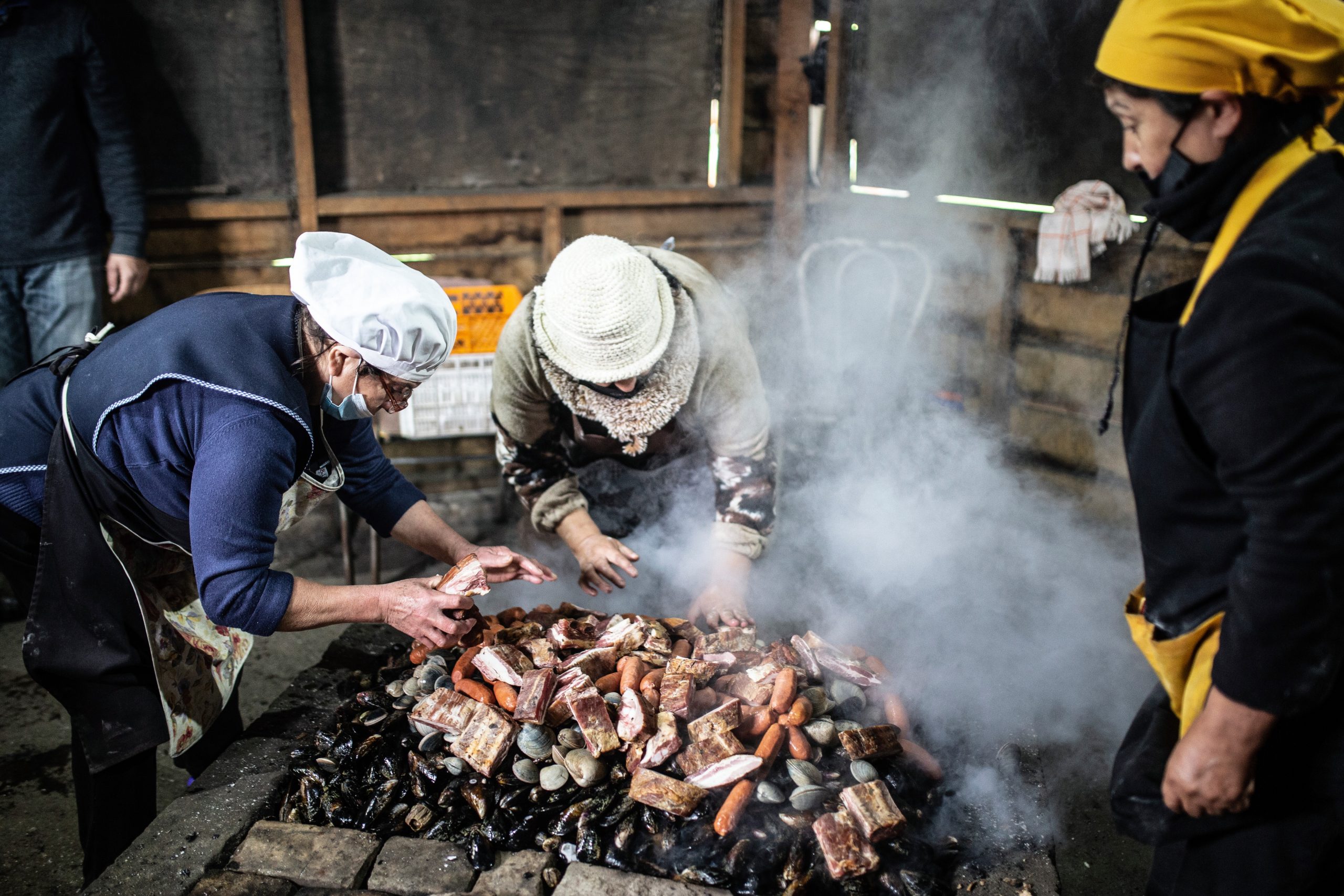
Thanks to Chile’s impressive biodiversity, numerous climates and landscapes, and extremely long coastline from its northern tip to the Antarctic in the south, the country produces an enormous variety of culinary ingredients, giving birth to exquisite dishes. Here, Chile Travel proudly presents some of our national gastronomic emblems. That way, when you come, you’ll know what to order!
Learn about Chile’s Aboriginal Cuisine
If you are a lover of good food and want to explore new culinary experiences, you can not miss the cuisine of the Mapuche people; a sample of the history and culture of this southern Chilean culture, surrounded by volcanoes, forests, and lakes, which will fill your visit with unforgettable experiences, colors, flavors, and aromas .
1. The Mapuche Curanto: a delicious culinary experience that you must not miss.
The Mapuche Curanto is a centuries-old preparation that has been passed down from generation to generation among the Mapuche communities of the Araucanía area. Its preparation is an authentic ritual, in which a hole dug in the ground is used to steam the ingredients.
In this hole, where stones have been previously heated, layers of food, such as potatoes, seafood, meat, and vegetables, are placed on top of rhubarb leaves. Everything is covered with more leaves and soil and left to cook for several hours.
The Curanto is worth the wait, as the result is a delicious dish that is very characteristic of Mapuche gastronomy. The ingredients are steamed, preserving all their flavors and nutrients, and the combination of meat, seafood, and vegetables makes every bite an explosion of flavor .
It can be served with Muday, a typical Mapuche drink. Muday is produced by fermenting grains such as wheat or pine nut seeds. It has a low alcohol content and is always part of the Mapuche ceremonies and celebrations.

Contemporary Cuisine
Contemporary cuisine in Chile has evolved in recent years thanks to a combination of cultural influences, innovations, creativity, and a greater appreciation for native and local ingredients. This gastronomic movement has led to the creation of groundbreaking dishes and the renewal of Chilean gastronomic traditions.
One of the most prominent trends in Chile’s contemporary cuisine is the inclusion of indigenous components into new dishes. Chefs are searching across the country’s regions for ingredients such as quinoa, merkén (hot chili spice), cochayuyo (seaweed), maqui (a native berry), hazelnuts, and many others, to prepare them using modern techniques. In addition, our culinary diversity is gaining much more importance as dishes strive to represent different regions and cultures.
2. 2023’s Award-Wining Locos (Chilean Abalones)
One of the most delicious ingredients that comes from the Chilean seas is the Concholepas concholepas, a mollusk better known as “Loco”. The Chilean loco fills us with pride, taking the title of 2023’s Mollusc of the Year awarded by the German scientific society, Senckenberg Society for Nature Research.
If you travel to Chile, you will surely find at least one Loco preparation, for example, a baked “Chupe” au gratin with avocado , or the cooked loco served over native potatoes and mayonnaise or chopped loco with quinoa and salsa verde.

Traditional Cooking
Chile’s traditional cuisine connects us with the land, the countryside, and the sea. Our national cuisine was born to nourish and replenish the souls of the working people who prepared their meals with ingredients coming directly from the fields. It is highly nutritional, made with love, and evokes certain emotions. You should absolutely try these meals if you are passing through Chile.
We cannot discuss traditional Chilean cuisine without mentioning the Cazuela, our national comfort food prepared to warm our bodies and souls. It is such a fundamental part of Chilean culture that when someone looks too skinny, we say: “You could use some cazuelas.” It is Chile’s version of a stew, prepared with beef, chicken, or sometimes lamb, big portions of pumpkin, potato, and corn. This meal fills you with energy, warmth, and nutrition, especially in winter.

Seafood of the Pacific
With over 6,400 kilometers (8,000 mi) of coastline, Chile is a destination blessed with abundant goodies that the Pacific Ocean offers. Families, fishing communities, and innovative restaurants of any class all take advantage of having the coast nearby. We are blessed with cold water currents that favor a great diversity of fish, mollusks, and shellfish , used to elaborate tasty creations and contribute to developing a Pacific gastronomic tradition that delights visitors from around the world.
4. Caldillo de congrio (Conger eel stew)
Caldillo de congrio is an iconic dish of Chilean gastronomy. This fish stew is prepared with conger (a variety of eel), onions, garlic, tomato, paprika, potatoes, carrots, and spices. The conger eel gives the broth an intense, savory flavor, while the vegetables add texture and flavor. It is served hot and is perfect for cold winter days. A dish so exquisite that our Nobel Prize winning poet, Pablo Neruda, described it as “a delight that must be tasted, a delicacy worthy of the gods”.

Market food
Chile’s markets are a must-visit destination for any foodie. Markets offer an authentic and unique experience to explore our local cuisine, learn about Chile’s food culture and enjoy flavors and textures you can’t find anywhere else.
In addition to providing fresh ingredients, Chile’s markets are full of typical foods, such as chorrillanas (french fries topped with sauteed beef strips, onions, and fried eggs.), pastel de jaiba (a type of crab pie), sopaipillas (like a pumpkin fritter), machas a la parmesana (clams with cheese), milcao (a potato pancake), or pastel de choclo (a type of corn pie). But one popular food in any market throughout the country, and one of Chilean actor Pablo Pascal’s favorites, is the empanada.
5. Empanadas
The Chilean empanada is one of the most emblematic and famous delicacies of the nation’s gastronomy. This delicious, thin, crunchy dough, filled with assorted ingredients, can be baked or fried. The most traditional Chilean empanada is the empanada de pino, which has beef, onions, pieces of hard-boiled egg, raisins, and olives, seasoned with cumin, pepper, and other spices. It is perfect for any occasion, from a quick lunch to a party appetizer.
Many kinds of empanadas have different fillings, such as cheese, seafood, and vegetarian varieties . But if you are visiting Chile, you must remember to try one of the delicious empanadas, which will surely conquer you with its unique flavor and crunchy, delightful texture.

If you liked this article, please share it:
Articles that may interest you

Discover The Flavors Of Chile: A Foodie's Guide To The Best Cuisine

Your changes have been saved
Email is sent
Email has already been sent
Please verify your email address.
You’ve reached your account maximum for followed topics.
10 Charming Small Towns Near Tucson, Arizona
10 underrated small beach towns in florida to kick the winter blues, scenic, but underrated: this small town is the perfect alternative to honolulu, quick links, what makes chilean cuisine so unique, chilean dishes you must try during your visit, know before you go: dining tips for first timers in chile.
Tourists can literally spend 10 days in Chile exploring its cities and hiking opportunities, thanks for being a popular destination for fun adventures. But its fantastic culinary scene also makes it a must-visit spot for foodies. Chilean food is not only unique but also incredibly diverse because of its unique position near the ocean, a melting pot of population, and a range of climates and ecosystems. Exploring traditional Chilean food is a perfect reason to visit Chile in 2023 , and tourists will definitely enjoy every bit of their journey, from tasting the unique culinary delights to trying famous wines. Want to discover the flavors of Chile? Here is a foodie’s guide to the best cuisine.
Related: Adventure-Filled Destination: 10 Best Chile All-Inclusive Resorts You Should Book
Chilean unique cuisine is the result of a fusion of three different culinary traditions. The first culinary tradition is their own, which includes ingredients such as corn, squash, chili peppers, beans, and potatoes. This incredible cuisine traces some of its origins to colonial times when the Spanish conquered the area. They introduced different ingredients and cooking techniques that gave rise to mestizo cuisine. French cuisine was added to the mix later in the 19th century.
This wonderful blending of different flavors, products, and colors contributes largely to its uniqueness and popularity. Divided into three regions, that is, the North, Central, and South, whose customs and traditions were influenced by different people. These influences are what contribute to the country's diverse food culture. However, despite these influences, there are a few Chileans who remain faithful to their original cultural roots and are dedicated to promoting and teaching their ancestors’ traditional cuisine.
Northern Chilean Cuisine
The Northern cuisine is mostly seafood, and cazuela marina (seafood soup) is very popular among the locals. When dining in one of the eateries, the staff offers salads as appetizers to begin with, and one of the best options is the ensalada de papas as salmon (a salad prepared with potatoes and salmon). When it comes to the main dishes, the menu will have plenty of seafood.
Central Chilean Cuisine
The majority of Chile's population stays on the Central Coast, and its cuisine traces its origin to Europe. So, tourists may find many dishes that they are already familiar with in this region. Of course, there are plenty of opportunities to try something different.
Holidays are the perfect time to taste some of this region’s unique flavors, including the pan de Pascua , a delicious sponge cake brought about by German immigrants.
The Southern Chilean Cuisine
The southern side of Chile is known for its popular stews and soups – and there is a variety to try during a visit to the region. Clam stew, or as they call it, caldillo de almejos , cazuela de vacuno (beef/vegetable soup), and sopa de ostras (oyster soup) are some of the most delicious soups not to miss in the South.
Pastel de choclo
This is one of the most popular dishes in Chile. It is a delicious hearty casserole prepared with olives, ground chicken or beef, boiled eggs, and choclo (a corn dough made with cream). Vacationers can find this dish in any of the top restaurants in Chile.
Porotos Granados
Prepared with white cranberry beans, ground corn, butternut squash, and other ingredients, such as garlic, tomatoes, and basil leaves. It is a popular seasonal dish, prepared in summer because this is when the locals harvest new corn and beans. It is also available at any other time of the year, but travelers who'd love to have a taste should visit in summer.
One of the oldest foods in Chile, curanto is the Chilian version of a clambake, popular in the southern part of the country and definitely worth trying. Traditionally, curanto is made by digging a hole (usually one and a half yards deep) . Red hot stones (previously heated in a bonfire) are placed in the pit. A mixture of shellfish, potatoes, meat, chapaleles, and vegetables is then added.
Travelers who love street food would fall in love with the Chilean empanadas, and while they will find this dish in other parts of Latin America, Chile's version is incredibly delicious. It is simply a breaded pastry stuffed with cheese, meat, and veggies. One can then choose to fry or bake. Some people replace veggies with seafood, and the result is still something to die for.
This is the Chilean version of hot dogs, and any hot dog fan would definitely enjoy it. Stuffed with sausage, tomato, sauerkraut, and plenty of mayonnaise, this is the kind of Chilean food that tourists wouldn't want to miss. Vacationers will find this food along the streets in major cities.
Ceviche is one of the most popular foods in Chile and is prepared with raw fish, which is marinated in citric juice. Other products include olive oil, onions, cumin, cilantro, and sauteed garlic.
Atacama Food
The beautiful landscapes of the Atacama Desert boast hidden culinary delights of their own. The locals enjoy eats like patasca (a delicious stew comprising beef or pork, white corn, onions, and potatoes) and Pepino duce (an oval-shaped desert fruit). Trying these foods is one of the amazing things to do in the Atacama Desert, Chile . And there are unique Chile hotels that offer the most magnificent views of Atacama’s dreamy landscapes while enjoying its unique cuisine.
Related: If You're Visiting Chile For Its Landscape, This Is The Best Time To Go (And Why)
This is where all barbecues came from. Roasted for about 2 hours on a charcoal grill, Asado can be pork, beef, chicken, or mutton. People always gather around and have a chat as this delicious Chilean barbeque is slowly roasted to taste.
- Chileans keep both hands above the table almost throughout meal times.
- Leaving immediately after having a meal is impolite.
- It is common to engage in conversations before, during, and after meals.
- Leaving some food on the plate is considered impolite and could be an indication that the food was not that good.
- Lunch is usually the largest meal, taken between noon and 3:00 pm.
- Dinners are served very late. Chileans start eating dinners at 8:00 pm, and mostly friendly and casual.
- Chileans don't eat with their hands, not even French fries! The locals consider it inappropriate and ill-mannered.
While many tourists visit Chile to experience its incredible adventures , its food is definitely worth exploring.
- Destinations

- Amazon River
- Galápagos Islands
- Indonesian Archipelago
- Mekong River
- Irrawaddy River
- India Cruises
- Pacific Coast
- Patagonia Cruises
- Machu Picchu
- Iguazu Falls
- Chile Travel Guide
Chile Food: 17 Traditional Chilean Dishes You Must Try
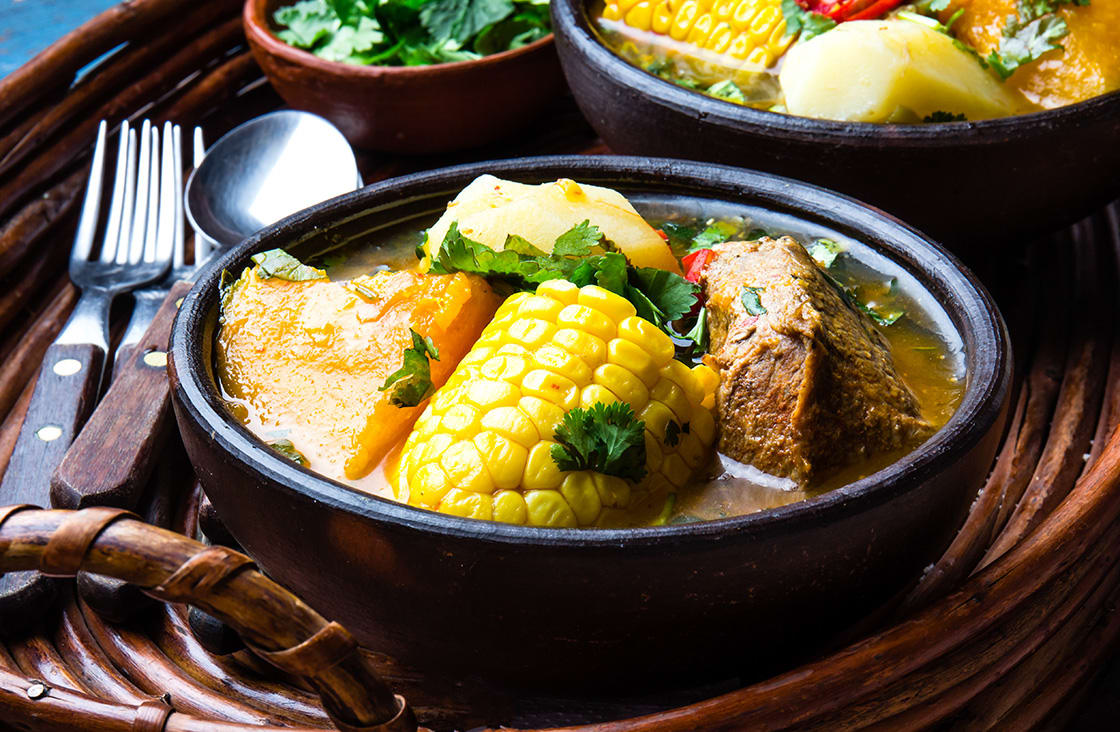
Traditional Chilean food is a mix of ingredients and dishes from the indigenous Mapuche and the Spanish. The cuisine is not only delicious, but it’s also about as diverse cuisine as everything else in this, the second-longest country in the world, with its enormous range of microclimates, soil, and ecosystems. It’s also heavily influenced by the country’s 2,600 miles of coastline, which offers up succulent seafood. Head further south to Patagonia where the Chilean cowboys, the ‘baqueanos’, ride their horses on the open range, and meat is also on the menu in a big way.
You’ll find lots of quinoa dishes in the Atacama Desert in the northern altiplano region of Chile. It’s a light and tasty seed that’s soft when cooked and served in salads, risotto, soups, and stews. You’ll also see puffed quinoa pops for breakfast and foods made from quinoa flour including some delicious pastries.
This native stew of northern Chile derives its name from the kernels of white corn that “pop” open when stewed for long enough. Besides corn, this tasty dish usually includes potatoes, onions, pork, and beef.
This Chilean-style steak sandwich contains a thin layer of churrasco (sirloin steak) and is cooked on a griddle. The sandwich is completed with two slices of freshly baked Chilean bread called pan amasado.
Chorrillana
Chorrillana is a huge pile of french fries with delicious toppings. Most often, it’s topped in sauteed onions, shredded beef, sausage, and fried or scrambled eggs. Restaurants typically serve it with a side of hot sauce (or pebre), ketchup, and mayo. It is served as a large platter and is meant to be shared.
A completo is a Chilean hot dog and a popular street food, which is even larger than American-style hot dogs. A completo comes with a variety of fixings, including mayo, tomatoes, onions, pickles, and sauerkraut. The roll is lightly toasted for a delicious crunch. The completo Italiano is loaded with mayo, tomatoes, and avocado.
Los Pasteles De Choclo
Choclo does not mean chocolate. Instead, it translates to “tender corn” or freshly picked corn. Pastel de choclo is a traditional corn casserole that’s usually filled with pino (pieces of cooked meat) and other ingredients. You’ll see it everywhere in Chile and in many variations and shapes from individual portions to large family-style casseroles. Pastele is typically made with garlic, onion, hard-boiled eggs, potatoes, olives, and vegetables as well as meat. It’s the national dish and comfort food of Chile .
Another famous Chile food is Cazuela, which is a popular stew made with peppers, quinoa, chili, corn, potatoes, and chicken or other meats such as pork, turkey, or beef. Some hearty cazuela recipes include rice or noodles. The stew gets its name from the cazuela pot, which is what it’s cooked in. When eating the dish, Chileans traditionally consume all of the liquid first before moving onto the large pieces of meat and veggies left in their cazuela bowls.
Machas a la Parmesana
If you like clams, razor clams are some of the sweetest you’ll ever have, and one of Chile’s native delicacies. Pink razor clams, called machas, are indigenous to Chilean shores and one of the country’s most popular shellfish. Machas a la Parmesana also includes parmesan and gouda cheese, as well as white wine, cream, and butter. This dish was introduced in the 1950s by Italian immigrants.
Humitas are 100 percent vegetarian and packed with flavor. These simple snacks are eaten during the summer months but can be frozen to enjoy year-round. They are prepared with fresh ground corn with onions, eggs, and spices that vary from region to region, and also by each family’s tradition. The dough is wrapped in a corn husk but is steamed rather than baked or boiled.
Chupe De Centolla
Chupe refers to the seafood-style stew you’ll see on menus throughout Chile. It usually includes shrimp, fish, veggies, and potatoes. It should be served with warm bread for dipping. Traditional chupe recipes call for crayfish, but shrimp has become a more popular ingredient. It’s often baked and served in a traditional clay bowl, with a thick and hearty cheese sauce.
Chilean Empanadas
Traditionally, in just about every Latin American culture, empanadas take on the flavor of their country with the dough that’s used to make them, the ingredients stuffed inside, their preparation, and their shape, which in Chile is square. These delicious pastry pockets can be found almost anywhere in Chile; they are cooked in a wood-burning oven (al horno) or deep-fried. The most traditional Chilean empanada is the Pino, which is a mixture of meat, onions, hard-boiled eggs, black olives, and raisins.
Porotos Granados
A summertime favorite, this vegetarian dish is a classic for locals, made with cranberry beans, corn, and squash mixed together into a wonderful stew that will make anyone feel at home. Meat lovers can throw chorizo on top. Ensalada Chilena (sliced tomatoes, onions, and cilantro) is regularly served on the side.
Sopaipillas
Sopapillas are deep-fried pastries. They’re made using pumpkin and wheat dough with shortening. Most sopapillas come in triangular, square, or circular shapes. They should be flaky, light, and crisp, the fresher the better, and are usually served with pebre on the side, a fresh and spicy condiment made from ahi peppers. The dessert version is often topped with warm honey or a sprinkle of sugar.
Cuchuflí can be found almost anywhere in Chile – from bakeries, grocery stores, and supermarkets to street vendors and beach food stand. These much-loved Chilean sweet snacks look like thin, crispy tubes with a texture similar to that of a wafer. They consist of sugar, flour, butter, egg whites, and vanilla flavoring. These sweet treats are often filled with dulce de leche, but they can also be covered in chocolate.
Tres Leches Cake
Tres leches translates to “three milks”, evaporated and poured over a light and airy sponge cake. The milk is also light and moistens the cake without making it soggy. Traditionally, the cake is vanilla, although chocolate and strawberry flavors have become more popular in recent years. The cake absorbs the liquid mixture to create an exceptionally moist pastry, usually topped with whipped cream.
Mote De Huesillo
This dessert in a cup is an interesting mixture of sugary syrup made from boiled dried peaches (huesillos) and herbs, with cooked wheat (mote) and a rehydrated peach floating in the middle. Eat it with a spoon in between sips.
Pisco Sour is a Peruvian and Chilean version of a whiskey sour, which uses Pisco − a 37% to 48% proof brandy − as the base liquor. The cocktail contains a mix of tangy citrus juices that give the drink a signature sour flavor. Most Chilean recipes incorporate pica lime and simple syrup.
While Rainforest Cruises aim to provide accurate and up-to-date information, we make no representations as to the accuracy or completeness of any information herein or found by following any link on this site. Rainforest Cruises cannot and will not accept responsibility for any omissions or inaccuracies, or for any consequences arising therefrom, including any losses, injuries, or damages resulting from the display or use of this information.
You may also like

Easter Island Honeymoon: A Romantic Guide To Rapa Nui
Want to step off the beaten path for your honeymoon? Easter Island is one of the most remote inhabited single islands in the world, and perhaps the most mystical of them all. […]

How To Visit Easter Island With Kids
The remote and mysterious Easter Island is a tiny dot in the middle of the South Pacific, halfway between Chile and Tahiti. A dot with a lot of super cool statues. Easter […]
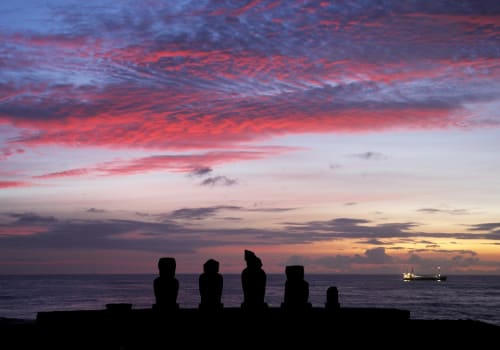
What To See On Easter Islands: 9 Main Tourist Attractions
A place that has baffled historians and archaeologists for decades, Easter Island is famous for its 887 extant monumental statues, called moai, created by the early Rapa Nui people. In 1995, it […]
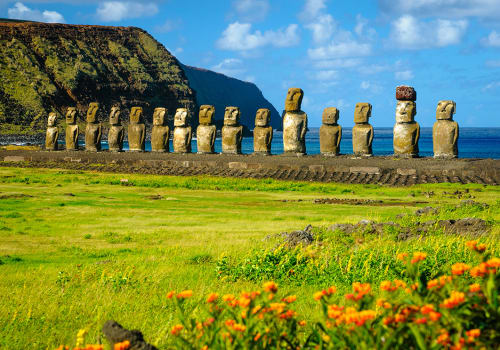
8 Best Easter Island Hotels For An Unforgettable Stay
For a relatively small island, Rapa Nui has a lot of accommodation options. In fact, it can be quite daunting trying to figure out where to stay on Easter Island. There are […]
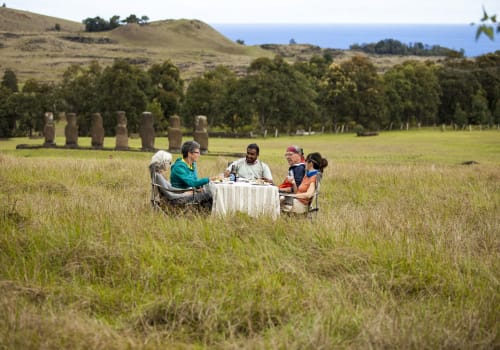
16 Best Things To Do In Easter Island
Located at the far eastern point of Polynesia in the middle of the Pacific Ocean, Rapa Nui is a place that has long been shrouded in mystery. For decades the allure of […]

11 Best Places To Visit On Easter Island
Easter Island, a small volcanic island in the middle of the Pacific Ocean, is world-famous for its giant ‘moai’ statues, which were built during the 13th – 16th centuries by the island’s […]
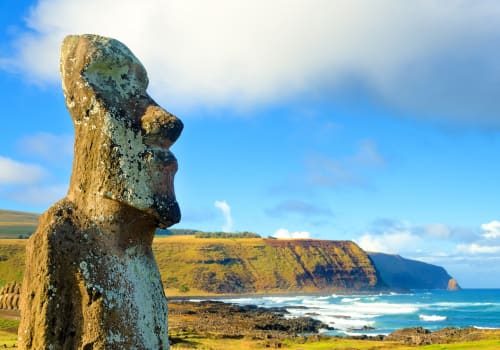
When Is The Best Time To Visit Easter Island?
One of the world’s most enigmatic and intriguing places, Easter Island or Rapa Nui covers approximately 64 square miles in the South Pacific Ocean and is located some 2,300 miles from Chile’s […]
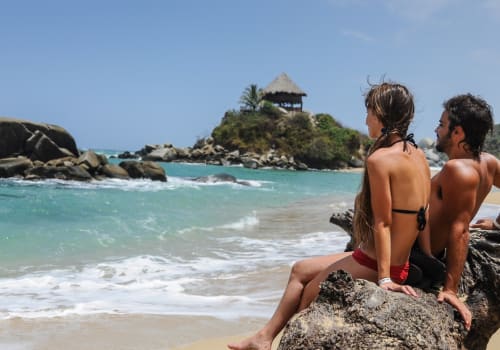
South America Honeymoon: Dream Destinations & Inspiration
South America presents an unrivaled combination of adventure and indulgence. With everything from romantic candlelit dinners under the stars to remote jungle trails; exciting cities to enchanting colonial towns; far-flung islands to […]

7 Best Family Destinations In South America
Soaring mountains, incredible wildlife and beaches, historical remains, the greatest natural and manmade wonders in the world, and spectacular cultural highlights from food to art, South America is a perfect destination for […]
On the Lookout for Expert Advice & Offers?
Join over 20,000 discerning travelers and be the first to receive our monthly exclusive discounts, inspiring travel content and expert tips, straight to your inbox.

- Charter (Private)

DEAL FLASH: 2 For 1 On Luxury 4-Day Amazon River Cruise Thanksgiving Departure
- South America
- 10 Traditional Chilean Dishes You...
10 Traditional Chilean Dishes You Need to Try

From hearty meat dishes to bright, tangy ceviche, this list of traditional Chilean foods is a tour guide for your taste buds. Wash down these distinctive dishes – many originating in the heart of Chile’s countryside – with a glass of local wine or a pisco sour.
These fried or baked dough pastries are usually filled with either cheese, seafood or a mixture called pino that consists of ground beef, olive, egg and onion. While Chileans enjoy empanadas year-round, homemade empanadas de pino are one of the key traditional foods served during Chile’s Fiestas Patrias – national holiday celebrations that take place in September. During the festivities, terremoto , a type of sugarydrink, is also quite popular. The beverage includes sweet fermented wine with pineapple ice cream and your choice of bitter fernet or grenadine.

Different versions of ceviche can be found all over Latin America, especially in Chile and Peru . Locally it is made with raw fish (often reineta or corvina), marinated and cooked with lemon juice before being served up with onions, garlic, merkén , cilantro, cumin, salt, olive oil and red peppers. Ceviche goes great with the tangy local drink, pisco sour, made with Chilean pisco, pica lime or lemon juice, syrup and ice.
Great for a nippy day or for warding away the sniffles, this tasty broth is made with large pieces of tender beef or chicken along with potatoes, pumpkin, corn noodles and cilantro. Try this traditional dish, which has both Spanish and indigenous Mapuche origins, at one of the marketplace eateries in La Vega Central . To do as the Chileans do, go ahead and eat the broth first, finishing up with the meat, potato and veggies.

Typically prepared at Chilean barbecues ( asados ), choripanes are grilled sausages served with fresh bread, available at any corner store. Toppings like mayonnaise, mashed avocado, and pebre are traditionally offered with Chilean choripanes. Pebre is a spicy Chilean condiment made with pureed peppers, chopped onions, garlic, olive oil and cilantro.
This native South American dish originates from pre-Hispanic Andean cultures and can also be found in Peru, Ecuador, Bolivia and Argentina. Though humitas are prepared similarly to a Mexican tamale , they are known for their sweetness, not spice. Humitas are made with boiled flour and corn dough, cooked with butter, onion and basil and wrapped in corn husks. You’ll find that humitas are often sold at corner stores, though sometimes street vendors will sell them from their coolers.
Mote con huesillos
This syrupy traditional drink is made with a mote (a kind of peach nectar), dried peaches and huesillos – husked wheat. Eating mote with sugar or milk became a popular custom in Chile during the 19th century, thanks to local wheat production. Eventually the peach and syrup were added and the drink became a staple of Chilean cuisine, especially in central regions of the country. Treat yourself to a cold mote con huesillos as you take in the view atop either the San Cristóbal Hill or Santa Lucía Hill, spots where this drink is regularly sold.

Become a Culture Tripper!
Sign up to our newsletter to save up to $1,200 on our unique trips..
See privacy policy .

As Chile’s take on the hot dog, completos are surprisingly one of the most beloved Chilean foods, sold in sandwich shops and stands throughout the country. A typical completo is served with sausage, chopped tomato, mayonnaise and sauerkraut. The completo Italiano is also quite popular, and comes with chopped tomatoes, mashed avocado and mayonnaise. The hot dog gets its name from the the combination of red, green and white ingredients used, which mimic the colors on the Italian flag.
http://instagram.com/p/BJs5eoMDity/
A traditional food of Chiloé Island in southern Chile, curanto is cooked with meat, potatoes, shellfish, a potato bread called milcao , vegetables and dumplings. What’s unique about curanto is that it is prepared using hot stones in a deep hole in the ground. The tradition of preparing curanto began with the indigenous Chono nomads that lived on the Chiloé Island – a tribe that is now extinct.

This traditional fried pumpkin flatbread is served in two different ways. On the streets, vendors will serve hot sopaipillas with hot sauce or pebre . A less common practice is to eat them in a bowl covered with sweet chancaca , a molasses-like sauce. This delicious wintertime dish is called sopaipillas pasadas .
Pastel de choclo
This popular traditional dish is an excellent representation of mestizo (mixed) cooking in South America, blending the ingredients for Spanish empanadas and indigenous Andean dish humitas . Pastel de choclo is a sweet and savory corn pudding dish typically cooked and served in a clay bowl. Ingredients include sweetcorn, olives, ground beef, hard boiled eggs, onions and raisins.

Places to Stay
The best hotels to book in chile for every traveler.

See & Do
11 epic reasons why you need to visit the chilean fjords at least once before you die.

The 23 Best Things to See and Do in Chile

The Most Romantic Honeymoon Destinations in Chile

Guides & Tips
Top 17 unusual things to see and do in santiago, chile.

The 10 Most Beautiful Towns In Chile

The 7 Best Places to See Penguins in Chile

The Best Destinations to Visit in Chile

The Best Boutique Hotels in Valparaíso, Chile

The 10 Coolest Neighborhoods in Santiago, Chile

The Best Hotels to Book in Puerto Natales, Chile

The Best Hotels to Book in Chile for Views
Culture Trip Summer Sale
Save up to $1,200 on our unique small-group trips! Limited spots.

- Post ID: 1048749
- Sponsored? No
- View Payload
Traveling the Length of Chile in Ten Typical Dishes
This culinary journey through Chile from north to south, takes you from one extreme to the next over the course of a delicious meal made up of traditional Chilean dishes. Many of these meals are found throughout the length of Chile and can be found at most Chilean restaurants. But they originate where these ingredients have a longer history, like quinoa in the north, and lamb in the south. Follow along for a taste of Chile.
Rica Rica Pisco Sour
Starting in the Atacama Desert, the driest desert in the world, the Atacama, you might not expect there to be much to begin a meal. However, some of the country’s most iconic flavors come from the desert, and one of them, rica rica melds particularly well with the Pisco Sour, which is Chile’s unofficial national aperitif. Pisco is a clear brandy distilled from grapes, and sours are generally made with the juice of a local lemon and sugar. In the north, some rica rica is often added, adding an herbal touch some people think it tastes a bit like sage.
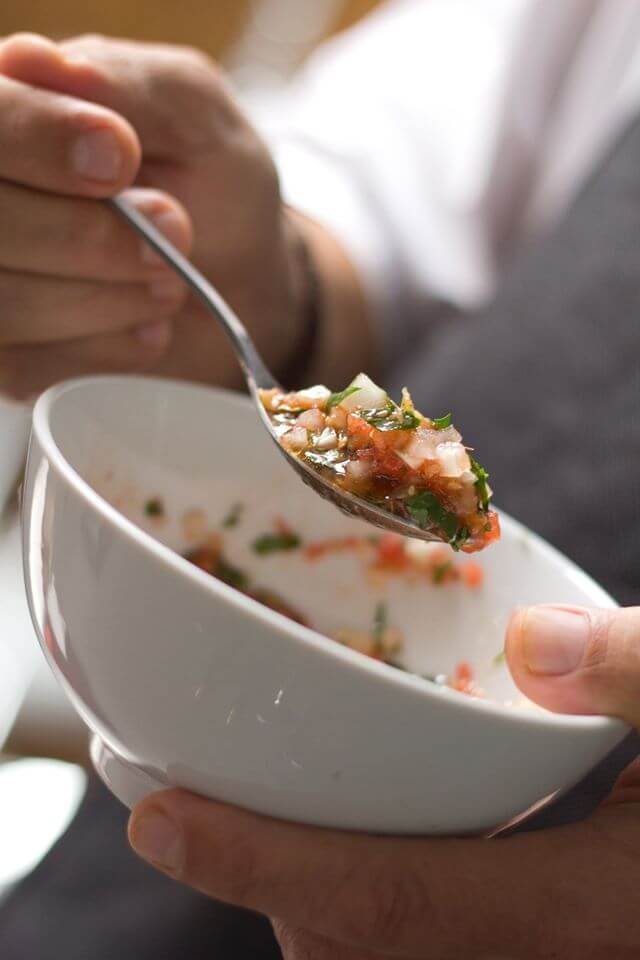
Pan con Pebre
As you move through your meal, the first thing to come to the table nearly the length of Chile, though with regional variations, is pan con pebre. The bread, or pan, may be pan amasado, a hearty country bread typical of the south, hallullah, a dense, round bread with holes poked in the uppermost layer, or marraqueta, which is Chile’s version of French bread, which comes in groups of two or four rolls. Sopaipillas, or fried disks of squash-enriched dough may also appear in the bread basket, especially from Talca through the south.
Pebre is a fresh chopped sauce similar to a salsa fresca, which usually is made up mainly of tomatoes, onions, cilantro and a drop of olive oil, but may also have yellow chiles in it, or at the coast, bits of seaweed called ulte. Either way, use a fork to serve yourself some out of the small bowl it’s served in, directly onto your bread.
Machas a La Parmesana
In the north, many larger cities and towns, like Antofagasta, Arica and Iquique are set facing the ocean, which means that the popular machas a la parmesana served here are very fresh. Machas are a kind of clam, similar to a razor clam, served on the half shell and baked with cheese, and sometimes a drop of wine. They’re sweet and a touch chewy, and usually come in plates of a dozen, which makes them a great starter for when you’re sharing a meal. These are found throughout much of Chile.
Caldillo de Congrio
Or maybe you’re in the mood for soup. This brothy soup, one of whose main ingredients is the conger eel (a type of fish) was perhaps made most famous by poet Laureate Pablo Neruda’s ode to it. But with bits of chopped cilantro and rounded out with the heartier seafood flavors of clams and oysters, there’s no doubt that this traditional Chilean food from the zona central should be one of your must-tastes on a trip to Chile.
Cazuela is another soup option if you’re in the mood for chicken or beef. You should be warned that nearly everyone in Chile believes that their mother makes the best cazuela, so if you think you’ve tasted the best one, expect a debate. But what is it? Cazuela comes in a large bowl with a cut of meat or chicken, as well as some large chunks of potatoes, half a corn cob and a large piece of squash. Some people cut all the hearty parts before beginning, and others eat the soup, scooping off pieces of the meat and vegetables as they go. Local variations include cazuela de cordero (lamb cazuela) as you get further south, to where sheep are also raised.
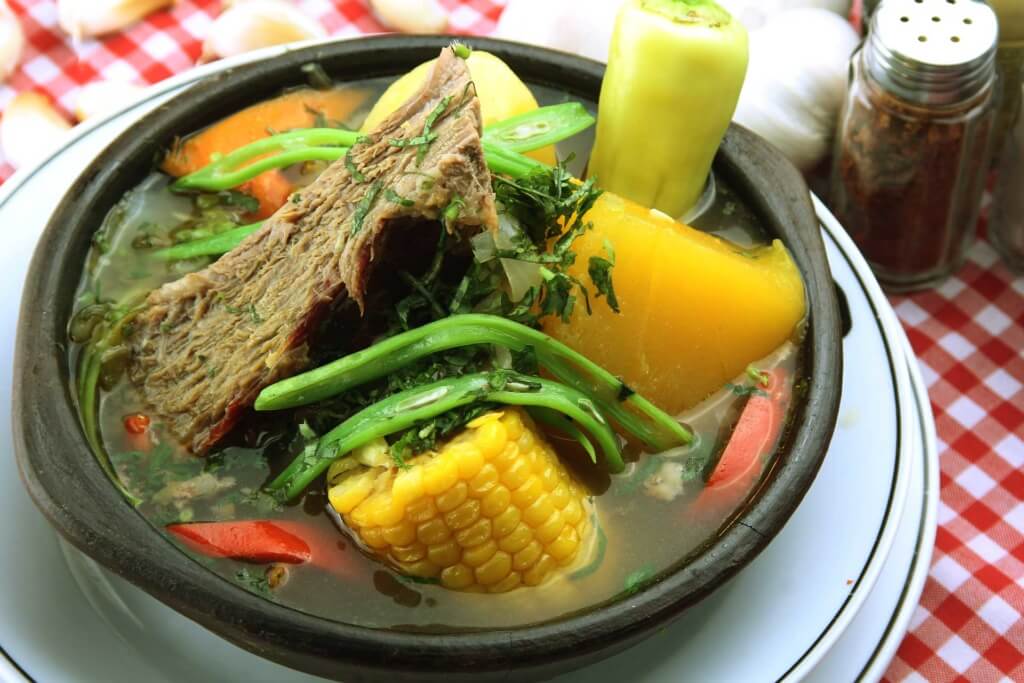
Pastel (or Chupe) de Jaiba
Cooler weather calls for an even heartier stew, so maybe you’ll choose a pastel de jaiba , a kind of bread-thickened bisque enriched with local crabmeat from the center and south of Chile. This dish is topped with cheese, and served bubbling in a greda , or earthenware bowl typical of the central zone as well, often from the town of Pomaire. The bowl goes in the oven, so heed the waiter’s warning that the bowl is caliente . Even further south, versions of this crop up with centolla , Chile’s massive, sweet-fleshed king crab.
Plateada con Quinoa
Also in the north, Chile’s millennial grain has long been a staple of the nortinos (people from the north), and quinoa is most often found in the north of Chile, or in upscale restaurants in Santiago . In the north it is often found served together with plateada, a cut of beef, though if you’re lucky, it may also come with alpaca or llama meat, which are also some of the typical dishes of the Atacama, where these animals are raised for meat.
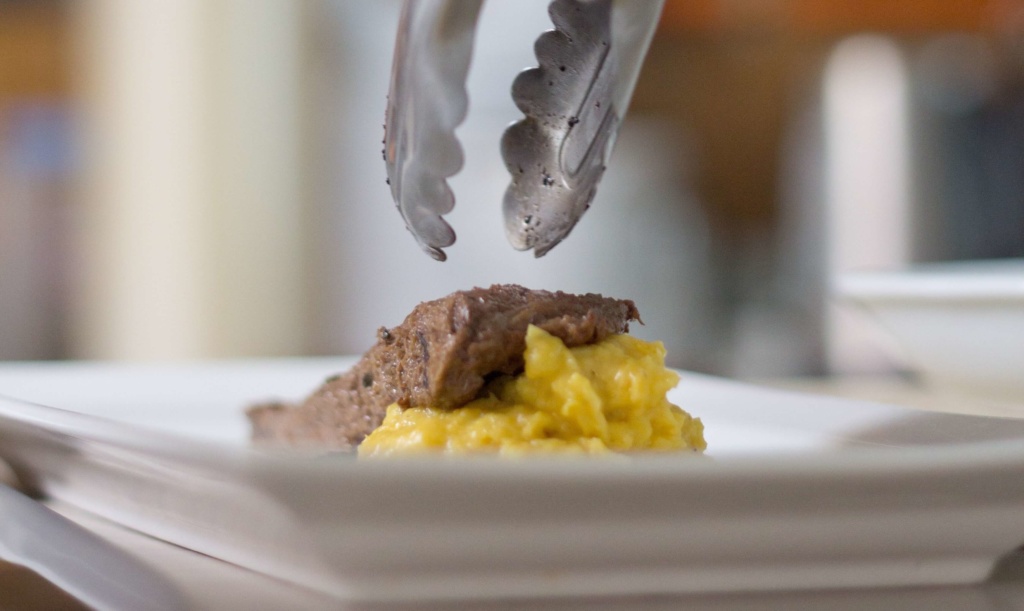
Or maybe you had a hearty breakfast, or you’re not quite ready for a full lunch. In Chile, there’s nearly always an empanada close at hand. In the north, in towns like San Pedro de Atacama, you’d be likely to find one with llama or alpaca meat. On the coast, there are fried cheese empanadas with seafood like shrimp or scallops, or baked ones with seafood stew. Along the length of Chile are empanadas de pino , or meat empanadas with half a hard-boiled egg and an olive (from the north of Chile) tucked inside. And on the island of Chiloé and further south, you may be lucky enough to find pear or apple empanadas, which are hearty and sweet, a hand-held pie for the road (though most people will eat them sitting down).
Arrollado de Huaso/Chancho
Even heartier fare is on hand as you move further south, where many people raise their own pigs. In the waste-not-want-not years in Chile’s past, people were very careful to use every part of the pig, which is how this rolled meat dish was born. It’s considered a country specialty of the south, and it is rolled and tied, and the outside is brushed with a spicy sauce. It is served in slices, often with puré picante (spicy mashed potatoes) as a side.
And if the north of Chile started us off well with our pre-meal cocktail, the south of Chile never disappoints with its varied desserts . In the southern part of the country, many homes are heated by wood-burning stoves in the central part of the house, and that same cozy culture gives rise to some of the best cheesecakes, kuchenes (fruit pies or crumbles) or slow-stirred manjar (dulce de leche) which sweetens everything from alfajores (sandwich cookies) to Chile’s own milhojas cake. Or if you want to harken back to the soft desserts of childhood, arroz con leche (rice pudding) or sémola (a cross between rice pudding and cream of wheat, made with coarse-ground wheat) are never far off.
Do you wish to contact us?
Reach us at: +1-888-853-4101 e-mail: [email protected]
Copyright © 2023 Upscape. All rights reserved. Terms & Conditions | Privacy Policy


Traditional Chilean Food – A Local’s Guide to the Country’s Most Popular Foods
Posted on Published: July 18, 2020 - Last updated: July 24, 2024
Sharing is caring!
This website may contain affiliate links and advertising so that we can provide recipes and guides at no additional cost to you. Learn more
Editor’s note : We asked Santiago-based writer Yeniree Bocaney about the dishes Chileans eat, and what to try when visiting Chile.
Full of gorgeous colors, juicy produce, and fascinating seafood dishes, Chilean food is one of Latin America’s most delicious cuisines .
The waters of the Pacific are home to an array of fresh, fascinating seafood, while the varied climate allows a wide range of fresh produce to be grown.
Add in some truly wonderful Chilean wine, and you have something for everyone in this breathtaking country.
Prepare for a culinary delight as we take a closer look at typical Chilean foods you simply need to try.
Empanada de Pino (Chilean Beef Empanadas)

Empanada de pino is one of the most iconic dishes in Chilean cuisine.
The pastry is made of wheat flour, milk, and eggs. But what actually distinguishes the Chilean empanada from many other empanadas is its filling.
Although we can find empanadas with several types of filling, such as cheese, the most traditional one in Chile is the “ pino .”
Pino consists of a mixture of ground beef, boiled eggs, onions, olives, and sweet raisins.
Traditionally, empanadas de pino are usually served during national holidays with a glass of good Chilean wine, but you can also find them in bakeries and supermarkets any day of the year.
Cazuela de Vacuno (Beef and Vegetable Soup)

The cazuela de vacuno is a traditional Chilean soup. This soup can be made with beef, turkey, chicken, goose, or pork, but the most classic one is made with beef.
It can be served in the winter or in the summer. In the winter, people eat it with carrots, potatoes, and spinach. In the summer, they eat it with corn, green beans, and peas.
What cannot be missing from this soup is the meat, potato, and pumpkin. You can also sometimes find cazuela made with rice.
This traditional dish is also very common in Peru and in Ecuador , where there are different versions of it made with fish or lamb.
Its consistency is very similar to the sancocho prepared in some Latin American countries.
Pastel de Jaiba (Blue Crab Casserole Pie)
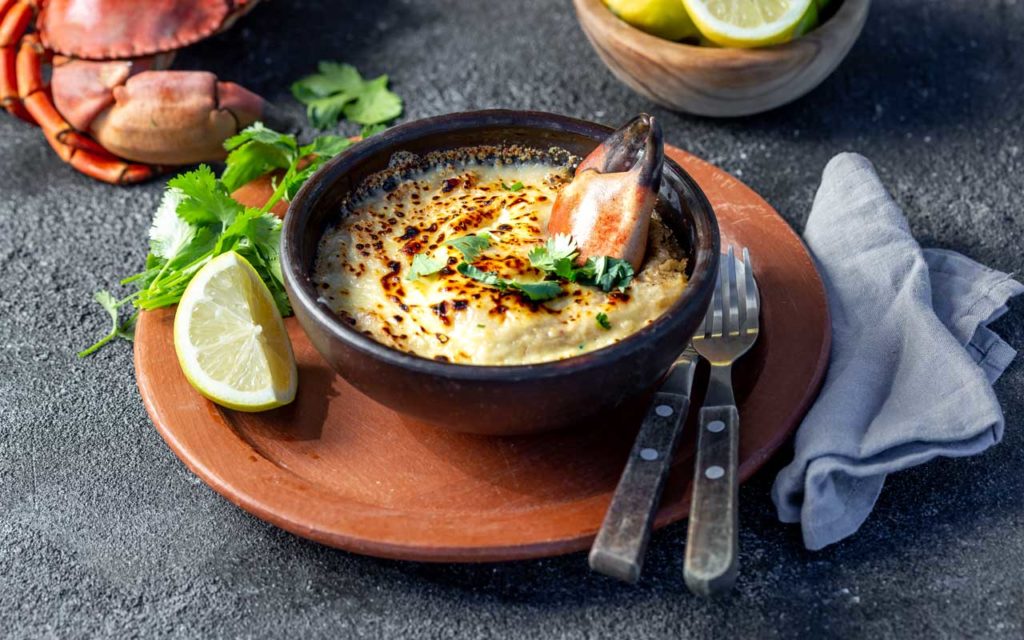
Pastel de jaiba is a classic dish, particularly popular on the Chilean coastline.
It consists of a crab casserole pie prepared from chopped blue crab, cheese, and sturdy white bread soaked in milk. It is traditionally served in the crab shell.
Nowadays, this dish has become increasingly popular in all kitchens throughout the country due to the relatively high availability of processed and frozen blue crab in any supermarket in the country.
Pastel de Choclo (Chilean Beef and Corn Casserole)

Pastel de choclo ‘s literal translation would be “corn pie,” and it is a delicious traditional seasonal dish in Chilean gastronomy.
The local version of this dish originated in the fields of Chile more than 200 years ago.
Although this dish is commonly served during the summer (corn season), it’s also available year-round.
As its name indicates, this dish is prepared from corn, which is ground or grated to form a paste.
The corn paste is usually pre-cooked with milk and placed over a mixture of meat, onion, red pepper, cumin, boiled eggs, raisins, and black olives.
This meat preparation is called pino , a mixture of meat originating from the Mapuche cuisine.
The pastel de choclo is traditionally prepared in a rustic clay pan and baked in the oven.
Completo (Chilean Hotdog)

Completo is one of the most popular and widely eaten meals in Chile. It is similar to the American hotdog, but at the same time, completely different.
The completo consists of a hotdog bun stuffed with Vienna sausage and covered with various toppings.
The base is always the same – bread and Vienna sausage. What makes it different from the hotdog is the variety of toppings that can be added, giving way to the different variations that exist.
The best known is the completo “ Italiano ,” which is topped with avocado, tomato, and mayonnaise. It is called “ Italiano ” because of the similarity of its colors with the Italian flag.
Another of the most popular ones is the completo “ Alemán ,” which is topped with tomato, mayonnaise, and sauerkraut.
There’s also the “ chacarero ,” topped with green beans, tomato, green pepper, and mayonnaise.
Read more: Completo Hot Dog Recipe
Porotos Granados (Chilean Bean Soup)

Porotos granados is a typical bean soup in the gastronomy of central-southern Chile.
Although it has different variations, depending on the zone of the country, the most common recipe consists of beans cooked with mazamorra (cream of corn) or pilco (a mixture of corn grains, carrot, pumpkin, tomato, onion, garlic, and basil).
It is usually served with pebre (chopped onion, tomato, coriander, garlic, aji pepper, and olive oil). The porotos granados dish, like the pastel de choclo , is eaten more often during the summer when most of the ingredients for this soup are in season.
Chorillana (French Fries Topped with Meat, Onions, and Fried Eggs)

Chorrillana is a popular traditional Chilean dish that consists of generous portions of French fries, egg, minced meat, and fried onions.
There are several versions of chorillana , depending on the geographical area of Chile.
Some preparations include chopped Viennese sausages or chorizos, which can be seasoned with oregano and garlic.
Chorillana is considered a group dish because of its large size, and it is common for 2 or 4 people to eat from one dish.
Since 2000, you can find this delicious traditional dish in local fast-food chains that have started to incorporate it as part of their menu.
Kuchen (Chilean Fruit Pie)
Kuchen is a traditional dessert from the south of Chile. Although its origin is German, it was adopted in these two South American countries following strong German immigration in the early 20th century.
It consists of a cake filled with fruit, mainly berries. There are different versions with different fruit, but the most popular one is the apple one, mainly due to the great variety of apples that can be found in the south of Chile.
However, you can also enjoy a rich kuchen made of blackberry, raspberry, cherry, or peach. Although it is a southern dessert, we can currently find it in local restaurants in different areas of the country.
Milcao (Potato Bread)

The milcao , also called melcao , is a kind of potato bread that is prepared by mixing raw and cooked potatoes together with other ingredients such as sausage.
It can be baked in the oven, boiled, or fried.
It is part of the traditional cuisine of southern Chile, particularly of the Chiloé archipelago in the Los Lagos region, where it is the preferred accompaniment to a delicious and traditional curanto or a fresh salad.
Sopaipillas (Fried Pastries)
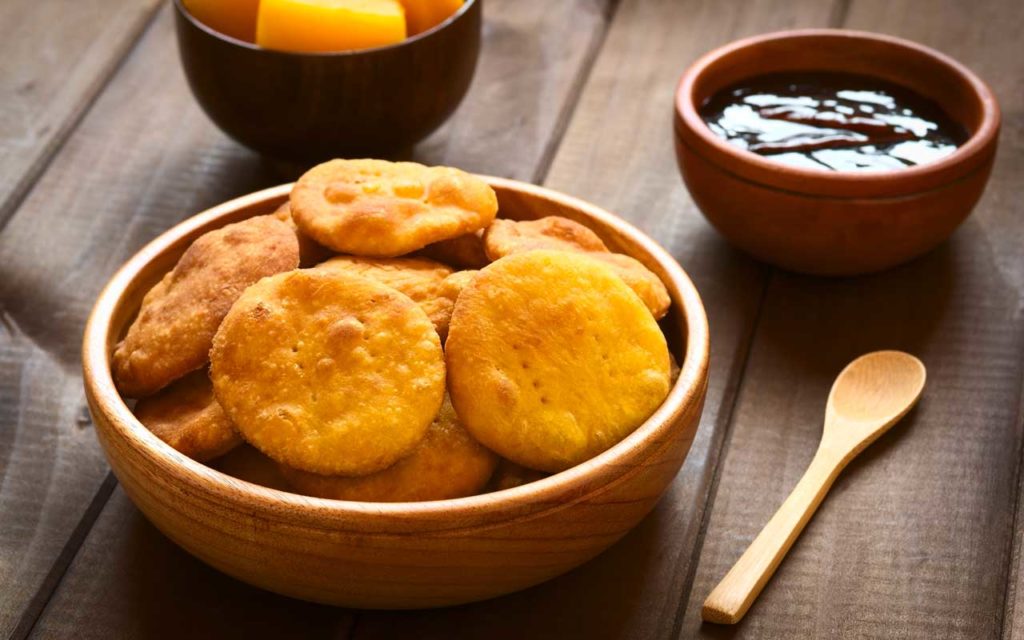
Sopaipilla is a traditional Chilean food consumed mainly in the central region of the country.
It consists of a type of fried dough prepared from wheat and pumpkin flour.
Sopaipillas are available year-round. However, it is more common to find people selling them on the street during the winter on those rainy days, usually served with pebre or with melted chancaca (a sweet sauce made with sugar).
Sopaipillas can be eaten at any time of day. However, it is common to eat them during “ once ” (a snack that is eaten after 5 pm) and with a cup of tea.
Brazo de Reina (Chilean Roll Cake)
Brazo de reina is a delicious traditional dessert consisting of a sponge roll filled with dulce de leche or fruit jam with icing sugar sprinkled on top.
This dessert is eaten throughout Chile, on any occasion, and in any season.
In Chile, it is common to eat a piece of this dessert during once or also for breakfast.
It is possible to find this dessert in any bakery or pastry shop in the country.
Curanto (Meat, Seafood, and Vegetables)

Curanto is a traditional dish of Chilean gastronomy, particularly of the Chiloé traditional cuisine.
It consists of a soup prepared with various types of meat, seafood, vegetables, onions, peppers, and whole peppercorns. Usually, this dish is served with milcaos (potato bread).
Although it is a traditional dish of the Chiloé archipelago, it has now spread throughout the southern part of the country.
It is mainly known for its eccentric preparation. In the gastronomy of the Chiloé archipelago, it is prepared outdoors and is called “ curanto en hoyo ” (curanto in a hole).
It is called this way because, for its preparation, it is needed to dig a well in the ground with stones that are heated in a fire and on which the ingredients are placed.
The cooking of curanto in a hole takes quite some time, and generally, you need five people to help in cooking this dish.
However, there is another easier form of preparation – making in a pot. This method is called “ curanto en olla ” (curanto in a pot) or “ pulmay “.
Po’e (Banana Pudding Cake)
Po’e is a sweet pudding cake made with wheat flour, pumpkin, and bananas.
It is sweet, and its texture is quite fluffy.
Po’e is served alongside many foods, including curanto and, in some cases, ceviche.
This food is traditional from Isla de Pascua (Rapa Nui), an island in Chile located in the middle of the Pacific Ocean. Isla de Pascua is one of the main tourist destinations in the country due to its natural beauty, its mysterious ancestral culture of the Rapa Nui ethnic group, and its excellent gastronomy that incorporates natural ingredients.
Cancato (Grilled Fish)

Cancato , from the Mapuche word “kangkatu,” which means roasted meat, is a roasted fish dish typical of the gastronomy of southern Chile, especially of the cuisine of the Chiloé Archipelago .
For the preparation of this dish, it’s common to use fish such as salmon, corvina, or sierra, as their flesh is firm.
Its traditional preparation is in the open air and consists of opening a fish and introducing small pieces of wood, such as sticks, to keep it open; then imprisoning it in a branch nailed to the ground and roasting it in a fire.
However, there are special grills to prepare the fish so that one does not have to use the traditional, time-consuming method. You can also find an oven-ready version in local restaurants.
There’s no doubt the foods of Chile leave you wanting more. This geographically diverse country is perfect for growing juicy, flavorsome produce and ingredients.
If you’re a seafood lover, you have every reason to rejoice. The Pacific Ocean is home to an incredible range of seafood.
So many wild and wonderful fish and crustaceans, with their breathtaking tastes, have made their way into beloved Chilean dishes.
Then, as with so many Latin American countries, there’s the range of altitudes.
This geography makes it ideal for growing so many different fruit and vegetables. From the coastline to the mountains, the types of foods vary greatly.
These conditions also mean Chile can more than hold its own on the world stage when it comes to wine production.
Chile is no different from Argentina , and other parts of Latin America, when it comes to wine: it’s not just a drink, it’s a huge part of culture and heritage.
European influence , including Spanish , has helped evolve Chilean food. The flavors are more complex, and the textures are layered in many dishes.
All of these factors help make Chile an underrated place when it comes to foodie travel . There’s so much diversity in the cuisine, and there are so many dishes to try.
Heat and passion, as with so many Latin American cuisines , help make the Chilean tastes a unique culinary experience.
You Might Also Like to Read
- Popular Argentinian Foods To Try
- Incredible Peruvian Foods To Try
- Traditional Ecuadorian Foods To Try
- Popular Bolivian Foods To Try
- Popular Uruguayan Foods To Try
Save and Pin for Later
Want to keep all these delicious Chilean food picks in a safe place? Save this article and pin it to one of your Pinterest boards for later.
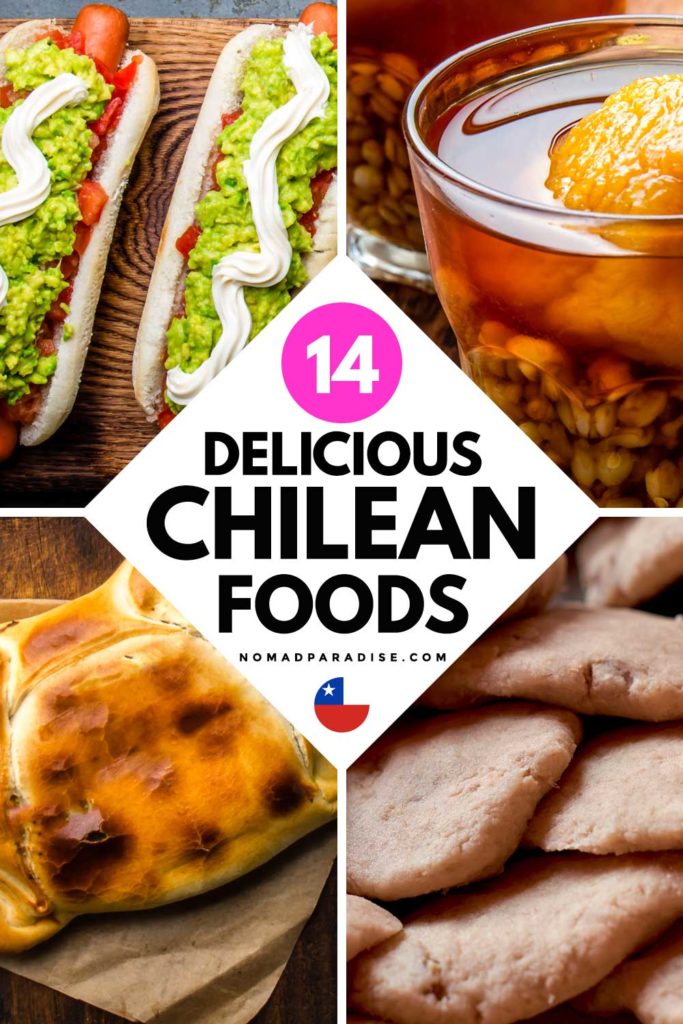
Some images licensed via Shutterstock.
Yeniree Bocaney is a Chilean foodie, writer, and translator from Santiago. Yeniree is passionate about her native cuisine and culture and enjoys writing about it to share with the rest of the world.
Hey there! We are Dale and Doina, the founders of Nomad Paradise. We traveled full-time for over three years, and while we now have a home base in the U.K., continue to take trips abroad to visit new places and try new cuisines and foods. Our food guides are curated with the guidance of local foodies, and their contribution is indicated under each article. We also cook the foods we try abroad, and you can discover how to make them in our 'recipes from around the world' category.
Marcelina Cambise
Saturday 5th of February 2022
Mmmmmm!!!!!!! The Best!!!

"Fjords and glaciers hidden among green landscapes give way to a disappearing horizon at the end of the world."

"Mysteries and legends of ancient people enrich the Polynesian landscapes of the navel of the world."

"Under a sky of infinite stars, the driest desert in the world rests waiting for that longed flowering."

"A magical place of wisdom and traditions, where an entire ecosystem grows and develops at its natural pace."

"Valleys that lie between the Pacific Ocean and the Andes give birth to a land of flavours to awaken your senses."

"Come discover and enjoy all the diversity that Latin America offers, from the heights of Machu Picchu to imposing Patagonia."

Explore Experiences
- Tailor-Made
- The Country
- Easter Island Rapa Nui
- Santiago and Wines Valleys
- Lakes and Volcanoes District
Our US Number
+1 434 321 8972
Chilean Gastronomy: A Delicious Guide to the Country’s Cuisine and Culture

Discover the rich and diverse culinary traditions of Chile, a country that offers a variety of dishes and ingredients that reflect its geography, identity, and heritage.
Chilean gastronomy is more than just food . It is a way of expressing the culture, history, and identity of a country that spans over 4,000 kilometers of coastline, mountains, valleys, and deserts. From the indigenous peoples to the Spanish Conquistadores , from the European immigrants to the Latin American neighbors , from the global influences to the local traditions and innovations , Chilean gastronomy has been shaped by many sources and has evolved over time. In this blog post, we will explore the main aspects of Chilean gastronomy , such as its definition, origins, products, regions, dishes, wines, and circuits. We will also give you some tips on how to enjoy the best of Chilean cuisine, whether you are visiting the country or just curious about its gastronomic wonders.
What is gastronomy?
Gastronomy is the study of the relationship between food and culture, art, science, and society . It is not only about cooking and eating, but also about understanding the history, geography, anthropology, sociology, and aesthetics of food. Gastronomy is a way of appreciating and preserving the culinary traditions and innovations of different regions and peoples, proving to be a stronger cultural force among the peoples of the world than linguistic or other influences.
Gastronomy is thus a cultural phenomenon that evolves and is influenced by constant changes . It reflects the diversity and unity of the human condition , as well as the creativity and innovation of the human spirit. Gastronomy is also a source of pleasure , enjoyment, and socialization, as well as a way of expressing identity , values, and beliefs.

What are the origins of Chilean gastronomy?
Chilean gastronomy is the result of a long and complex process of fusion and adaptation of different culinary traditions and influences. The main sources that shape the current Chilean gastronomy are:
- The indigenous peoples: The original inhabitants of Chile, such as the Mapuche, Aymara, Atacameño, Rapa Nui, and others, contributed with their ancestral knowledge of the native flora and fauna, as well as their techniques of cultivation, hunting, fishing, and preservation of food. Some of the products that they introduced to Chilean gastronomy are maize, potatoes, quinoa, beans, squash, tomatoes, peppers, avocados, chirimoyas, lucumas, and llamas, among others. Some of the dishes that they influenced are cazuela , pastel de choclo , humitas , charquicán , curanto , and empanadas , just to name a few. Later, we will say a thing or two about some of these preparations.
- The colonial and Hispanic legacy: The Spanish Conquistadores and their successors brought with them their culinary traditions, as well as products and spices from Europe, Africa, and Asia . They also introduced livestock , such as cattle, sheep, pigs, chickens, and horses, as well as crops, such as wheat, barley, oats, rice, olives, grapes, citrus fruits, and sugar cane, among others. Some of the dishes that they influenced are asado , caldillo , escabeche , arroz con leche , alfajores , and churros , among others.
- The European immigration : During the 19th and 20th centuries, Chile received waves of immigrants from various European countries, such as Germany, France, Italy, England, Switzerland, Croatia, and the Levant. They brought with them their culinary traditions, as well as products and techniques that enriched the Chilean gastronomy. Some of the dishes that they influenced are kuchen , strudel , crêpes , pasta, sandwiches, and fondue , to name some.
- The Latin American integration: In recent decades, Chile has become more open and connected to its Latin American neighbors, such as Peru, Bolivia, Argentina, Brazil, Colombia, and others. They have shared their culinary traditions, as well as products and flavors that have added diversity and fusion to Chilean gastronomy. Some of the dishes that they influenced are ceviche , arepas , and Peruvian-style pisco sour , among others.
- The global trends: Chile is also part of the globalized world , where new trends and influences emerge and spread rapidly. Chilean gastronomy has been influenced by the cuisines of other regions , such as Asia, the Middle East, the Mediterranean, and others. Chilean gastronomy has also adopted new concepts and practices , such as organic , vegetarian, vegan , gluten-free, and fusion cuisine, among others.

What are the main products of Chilean gastronomy?
Chilean gastronomy is characterized by its variety and quality of products , both native and introduced, that reflect its diverse geography and climate . Chile has a privileged natural environment, with abundant and fresh resources from the sea, the land, and the air. Some of the main products of Chilean gastronomy are:
- Seafood: Chile has a long coastline, entirely crossed by the cold Humboldt Current , with rich and diverse marine fauna. Some of the seafood that is consumed in Chile are fish , such as salmon, hake, conger, sea bass, and anchovy, among others; shellfish , such as clams, mussels, oysters, scallops, and abalone, etc; crustaceans , such as shrimp, crab, lobster, and crayfish, among others; and cephalopods , such as squid, octopus, and cuttlefish, and others. Seafood is prepared in various ways, such as fried, grilled, baked, stewed, or raw, and accompanied by sauces, salads, or bread.
- Meat: Chile has a large and varied livestock production , with different types of meat, such as beef, pork, lamb, goat, and poultry, among others. Meat is prepared in various ways, such as roasted, grilled, boiled, or fried, and accompanied by sauces, salads, or potatoes. Meat is also used to make sausages , such as longaniza , chorizo , prieta , and arrollado , to name some; and cold cuts , such as ham, salami , mortadella , and paté , very popular options on any Chilean family table. Here, the Spanish and German influence are notorious.
- Vegetables: Chile has a fertile and diverse agriculture, with different types of vegetables, such as potatoes, tomatoes, peppers, onions, garlic, carrots, lettuce, cabbage, spinach, and corn, among others. Vegetables are consumed raw, cooked, or pickled, and used to make salads, soups, stews, pies, or casseroles. Vegetables are also used to make sauces , such as pebre , chancho en piedra , salsa verde , and salsa de tomate, etc.
- Fruits: Chile, as an agricultural powerhouse , boasts a wide and varied fruit production, with different types of fruits, such as apples, pears, peaches, plums, cherries, grapes, oranges, lemons, kiwis, strawberries, raspberries, blueberries, and chirimoyas , and you can find many of them in supermarkets all over the world. Fruits are consumed fresh, dried, or canned, and used to make juices, jams, compotes, or desserts. Fruits are also used to make wines, liquors, and cocktails , such as pisco , chicha , pipeño , and terremoto , and others.
- Dairy products: Chile has a significant and diverse dairy production, with different types of dairy products, such as milk, cheese, butter, cream, yogurt, and ice cream, etc. Dairy products are consumed as beverages, snacks, or desserts, and used to make sauces, soups, or cakes. Dairy products are also used to make cheese-based dishes, such as queso fresco , goat cheese, and quesillo , among others.
- Bread and pastries: Chile ranks in third place in the world for per capita bread consumption and has a strong and varied tradition of bread and pastries, with different types of bread, such as marraqueta , hallulla , dobladita , pan amasado , among others; and pastries, such as sopaipillas , calzones rotos, berlines, and chilenitos , etc. Bread and pastries are consumed as breakfast, lunch, or snack, and accompanied by butter, cheese, jam, manjar , or pebre . Bread and pastries are also used to make sandwiches, such as churrasco , Barros Luco, Barros Jarpa, and chacarero , among others.

What are the main regions of Chilean gastronomy?
Chilean gastronomy is also characterized by its regional variations , that reflect the different geographical, climatic, and cultural conditions of each zone. Chile can be divided into five major gastronomic regions, each with its own products, dishes, and traditions:
- The North: The northern region of Chile comprises from the Parinacota and Tarapacá regions to the Antofagasta and Atacama regions, where the desert and the altiplano dominate the landscape. The gastronomy of this region is influenced by the indigenous and Andean cultures , as well as the massive mining and fishing activities. Some of the products that are typical of this region are quinoa , llama meat, charqui , cochayuyo , and rica rica , among others. Some of the dishes that are typical of this region are patasca , calapurca , chumbeque sweet, and sopa de guatitas .
- The Central Valleys: The central valleys region of Chile comprises the Coquimbo, Valparaíso, Santiago Metropolitan, O’Higgins, and Maule regions, where the Mediterranean climate and the fertile soil favor the agriculture and viticulture . The gastronomy of this region is influenced by the colonial and European cultures , as well as the urban and rural lifestyles . Some of the products that are typical of this region are grapes, olives, nuts, cheese, honey, and wheat, among others. Some of the dishes that are typical of this region are empanadas, pastel de choclo, humitas, cazuela, asado, and charquicán, among others. Sidenote: Chilean awarded olive oil come from this area .
- The South: The southern region of Chile comprises the Biobío, Araucanía, Los Ríos, and Los Lagos regions, where the temperate climate and the abundant rainfall favor the forestry and livestock . The gastronomy of this region is influenced by the indigenous and German cultures , as well as the coastal and inland activities. Many German settlers began inhabitating this regions from the mid 19th century. Some of the products that are typical of this region are potatoes, apples, berries, cheese, milk, and meat, among others. Some of the dishes that are typical of this region are curanto, milcao, chapalele, kuchen, strude l, and crêpes , among others.
- The Austral or Patagonia : The austral region of Chile comprises the Aysén and Magallanes regions, where the cold climate and the rugged terrain favor the fishing and sheep farming . The gastronomy of this region is influenced by the indigenous and Croatian cultures , as well as the maritime and continental environments. Some of the products that are typical of this region are salmon, hake, king crab, mussels, lamb, and calafate, to name a few. Some of the pre that are typical of this region are cordero al palo , cazuela de cordero, centolla a la parmesana, and calafate sour , among others.
- The Islands: The insular region of Chile comprises Rapa Nui (Easter Island) and the Juan Fernández archipelago, where the tropical climate and the isolated location favor the exotic and endemic flora and fauna. The gastronomy of this region is influenced by the Polynesian and British cultures , as well as the volcanic and coral ecosystems . Some of the products that are typical of this region are tuna, swordfish, lobster, taro, banana, and pineapple, among others. Some of the dishes that are typical of this region are po’e, umu, and lobster pie, among others.

What are the main dishes of Chilean gastronomy?
Chilean gastronomy offers a variety of dishes and ingredients that reflect its diversity and unity . Some of the dishes are regional, while others are national. Some of the dishes are traditional, while others are modern. Some of the dishes are simple, while others are elaborate. Chileans love to savor them all year, but there is a rise in its consumption during National Holidays (Independence Day) each September 18th. Here are some of the main dishes of Chilean gastronomy, those that cross over regions (although with own iterations) along with their descriptions and ingredients:
- Empanadas: Empanadas are one of the most popular and emblematic dishes of Chilean gastronomy. They are pastries that can be of many sorts , so they are filled with different ingredients, such as meat, cheese, seafood, or vegetables, and baked or fried. They can be cooked in the oven or deep fried, depending on the filling, kind of dough and regional version. The most common type of empanada is the empanada de pino , which is filled with minced beef, onion, raisins, olives, and hard-boiled eggs. Empanadas are usually eaten as a snack, appetizer, or main course, and accompanied by pebre , a spicy sauce made with tomato, onion, cilantro, garlic, and chili pepper.
- Pastel de choclo: Pastel de choclo is another typical and delicious dish of Chilean gastronomy. It is a casserole made with a layer of minced beef, chicken, onion, raisins, olives, and hard-boiled eggs, covered with a layer of mashed corn, sprinkled with sugar, and baked. Pastel de choclo is usually consumed as a main course, and sided by ensalada chilena , a salad made with tomato, onion, cilantro, and vinegar.
- Humitas: Humitas are a traditional and nutritious dish of Chilean gastronomy. They are made with fresh corn, onion, basil, butter, and salt, ground into a paste, wrapped in corn husks, and boiled or steamed. Humitas are usually eaten as a main course, and accompanied by tomato, onion, or pebre.
- Cazuela: Cazuela is a hearty and comforting dish of Chilean gastronomy. It is a soup or stew made with meat, such as beef, chicken, lamb, or pork, and vegetables, such as potatoes, squash, corn, carrots, and green beans, cooked in a broth seasoned with salt, pepper, oregano, and parsley. Cazuela is usually eaten as a main course.
- Asado: Asado is a festive and social dish of Chilean gastronomy. It is a barbecue of different types of meat, such as beef, pork, lamb, or chicken, grilled over charcoal or wood, and seasoned with salt, pepper, garlic, and merkén, a smoked chili pepper. Asado is usually eaten as a main course, and accompanied by salads, sauces, bread, and wine, beer or your preferred cocktail like piscola (pisco and cola drink in a long glass with a couple of ice cubes).
- Charquicán: Charquicán is a simple and tasty dish of Chilean gastronomy. It is a stew made with meat, such as beef, lamb, or horse, and vegetables, such as potatoes, squash, corn, carrots, green beans, and onion, cooked in a pot with water, salt, pepper, and cumin. Charquicán is usually eaten as a main course, and accompanied by eggs, cheese, or pebre .
- Curanto: Curanto is a unique and ancient dish of Chilean gastronomy, with its origins in Chiloé , southern Chile. It is a feast of seafood, such as clams, mussels, oysters, scallops, and fish, and meat, such as pork, chicken, and sausage, and vegetables, like potatoes, squash, and cabbage, and local bread-type pastries, such as milcao and chapalele , cooked in a hole in the ground, covered with hot stones, leaves, and earth. Curanto is usually eaten as a main course, and accompanied by chicha , a fermented drink made from grapes or apples.
- Kuchen: A German loan, Kuchen is a sweet and delightful dish of Chilean gastronomy. It is a cake made with flour, butter, eggs, sugar, and yeast, and filled with different ingredients, such as fruits, cheese, cream, or jam. The most common types of kuchen are the apple kuchen , the cheese kuchen, and the plum kuchen. Kuchen is usually eaten as a dessert, and accompanied by tea or coffee.
- Sopaipillas: Sopaipillas are a crispy and addictive dish of Chilean gastronomy. They are discs of dough made with squash meal and flour, water, salt, and lard, and fried in oil. Sopaipillas are usually eaten as a snack, appetizer, or dessert, and accompanied by pebre , manjar , or honey.
- Caldillo de congrio: Caldillo de congrio is a flavorful and aromatic dish of Chilean gastronomy. It is a soup made with conger eel, a large and white fish, and vegetables, such as potatoes, onion, garlic, carrot, and celery, and herbs, such as parsley, cilantro, and bay leaf, and wine, cooked in a pot with water, salt, and pepper. Caldillo de congrio is usually preferred as a main course, and according to popular culture, it is the best “antidote” to New Year’s or any hangover!

What are the main wines and drinks of Chilean gastronomy?
Chilean wine: a history of tradition and innovation.
Chile is a country with a long and rich tradition of wine production , dating back to the 16th century, when the Spanish Conquistadores and missionaries brought the first grapevines to these lands . Since then, Chilean wine has evolved from a craft to an industry, from a local to a global product, and from a classic to a modern style.
The history of Chilean wine can be divided into three main periods: the colonial, the republican, and the contemporary. Each period has its own characteristics, challenges, and achievements, reflecting the social, economic, and cultural changes that the country has experienced over the centuries.
The colonial period (1548-1810) was marked by the introduction and adaptation of the European grape varieties, especially the País , which was brought by the Jesuit priest Francisco de Carabantes in 1548. This variety, also known as Listán Prieto or Mission , was the most widely planted and used for wine production until the 19th century. The wine was mainly consumed by the local population, the clergy, and the colonial authorities, and was also exported to Peru and other Spanish territories. The wine industry was regulated by the Spanish crown, which imposed taxes and restrictions on the trade and consumption of wine.
The republican period (1810-1973) was characterized by the independence and modernization of the country, which also affected the wine industry. The most important event was the introduction of the French grape varieties , such as Cabernet Sauvignon, Merlot, Carmenere, Sauvignon Blanc, and Chardonnay , which were brought by the wealthy landowners who traveled to Europe in the mid-19th century. These varieties, along with the traditional País , gave rise to a diversity of styles and qualities of wine, ranging from the popular pipeño to the fine reserva . The wine industry also benefited from the development of the transportation, communication, and irrigation systems, which facilitated the expansion and distribution of the vineyards and the wines. The wine consumption increased both domestically and internationally, reaching new markets such as Europe and North America.
The contemporary period (1973-present) is defined by the transformation and innovation of the wine industry, which has faced new challenges and opportunities in the globalized world. The most significant event was the phylloxera crisis , which affected the European vineyards in the late 19th century, but spared the Chilean ones, thanks to the natural isolation and protection of the Andes, the Pacific Ocean, the Atacama Desert, and the Patagonia. This gave Chile a unique advantage, as it preserved its original and ungrafted vines, which are considered a treasure and a source of identity for the Chilean wine. The wine industry also underwent a technological and scientific revolution , which improved the quality and diversity of the wine, as well as a marketing and branding strategy , which increased the recognition and reputation of the wine. The wine production and exportation reached record levels, making Chile one of the largest and most important wine producers and exporters in the world .

Chile is a country with a great diversity of wine regions , each with its own characteristics and varieties. Here are some of the main regions and their wines:
- Atacama: This is the northernmost and driest wine region of Chile, where the grapes are irrigated by the Copiapó and Huasco rivers. The main varieties are País, Moscatel, and Pedro Jiménez , which are used to produce pisco , Chile’s traditional brandy, and some sweet wines.
- Coquimbo: This region includes the Elqui, Limarí, and Choapa valleys, which have a semi-arid climate influenced by the ocean and the mountains. The main varieties are Syrah, Cabernet Sauvignon, Merlot, Carmenere, Chardonnay, and Sauvignon Blanc , which produce fresh and fruity wines with mineral notes.
- Valparaíso: This region comprises the Aconcagua, Casablanca, and San Antonio valleys, which have a Mediterranean climate with warm days and cool nights. The main varieties are Cabernet Sauvignon, Merlot, Carmenere, Syrah, Pinot Noir, Chardonnay , and Sauvignon Blanc , which produce elegant and complex wines with good acidity and balance.
- Central Valley: This is the largest and most traditional wine region of Chile , which includes the Maipo, Rapel, Curicó, and Maule valleys. The climate is Mediterranean with a wide range of temperatures and soils. The main varieties are Cabernet Sauvignon, Merlot, Carmenere, Malbec, Carignan, Chardonnay, and Sauvignon Blanc , which produce full-bodied and aromatic wines with a long aging potential.
- Southern Region: This region covers the Itata, Bío-Bío, and Malleco valleys, which have a cool and rainy climate with a strong influence of the ocean and the volcanoes. The main varieties are País, Cinsault, Muscat, Riesling, Gewürztraminer, Pinot Noir , and Chardonnay , which produce light and delicate wines with floral and herbal notes.
- Austral Region: This is the newest and most experimental wine region of Chile , which extends to the Cautín and Osorno valleys, near the Patagonia. The climate is cold and humid, with a short growing season and a high risk of frost. The main varieties are Pinot Noir, Chardonnay, Sauvignon Blanc, and Riesling , which produce crisp and refreshing wines with high acidity and low alcohol.
Chile is a country that is constantly innovating and exploring new terroirs, varieties, and styles of wine, offering a wide range of options for the consumers. Chile is also a country that invites the visitors to discover its wine culture and heritage, through the various wine tours and experiences that are available throughout the year.

Pisco and Beers
Pisco is an alcoholic beverage of the brandy family , which is produced by distilling wine from certain grapes in Chile, and is an integral part of the culture and identity of the country. As with wine, pisco has a history that dates back to the 16th century, when Spanish settlers brought grapevines to the colonies and started making wine. However, due to the high taxes and restrictions imposed by the Spanish crown on the wine trade, the colonists began to distill the wine into a stronger and cheaper spirit.
Pisco is usually consumed as a cocktail , such as the famous pisco sour , which is made with pisco, lemon juice, sugar, and sometimes egg whites. Other popular cocktail is piscola , which is pisco mixed with cola. Pisco can also be enjoyed neat or on the rocks, as a digestif or aperitif.
The New Love for Beer
Chile is a country with a long tradition of beer consumption, dating back when German immigrants brought their brewing skills and recipes in the 19th century. Today, Chile is one of the largest beer markets in Latin America, with a per capita consumption of 45 liters per year. However, the beer scene in Chile is not only dominated by the big industrial brands, but also by a vibrant and diverse craft beer movement that has emerged in the last decade.
Craft beer, also known as cerveza artesanal , is beer that is produced by small and independent brewers, using natural ingredients and traditional methods. Craft beer is characterized by its variety of styles, flavors, aromas, and colors, as well as by its quality and innovation. Craft beer lovers appreciate the creativity and passion of the brewers, who experiment with different ingredients, such as fruits, spices, herbs, honey, chocolate, coffee, and even chili peppers.
The craft beer movement in Chile started in the early 2000s, with pioneers who opened their own breweries and pubs in different regions of the country. Since then, the number of craft breweries has grown exponentially, reaching more than 300 in 2023, according to the Asociación de Productores de Cerveza Artesanal de Chile (APCA).
The craft beer culture in Chile is also reflected in the increasing number of festivals, events, tours, and tastings that are organized throughout the year, especially in the summer months. Some of the most important events are the Festival de la Cerveza Artesanal de Valdivia, the Oktoberfest de Malloco, the Feria de la Cerveza Artesanal de Santiago .
Craft beer is more than just a drink, it is a way of life, a form of expression, and a source of identity for many Chileans. It is also a sign of the changing tastes and preferences of the consumers , who are looking for more quality, variety, and innovation in their beverages. Craft beer is a trend that is here to stay, and that will continue to surprise and delight the beer lovers in Chile and beyond.

What are the main circuits of Chilean gastronomy?
Chilean gastronomy is also a way of exploring and discovering the country, its culture, and its people. Chile has several gastronomic circuits , which are routes or destinations that offer a variety of culinary experiences, such as restaurants, markets, festivals, workshops, tours, and tastings. Some of the main gastronomic circuits of Chile are:
- The Wine Route: The wine route is a circuit that covers the main wine regions and valleys of Chile, where you can visit the vineyards, wineries, and cellars, and learn about the history, production, and styles of Chilean wines. You can also taste and buy different types of wines, and enjoy the local cuisine and scenery. Some of the places that you can visit on the wine route are Casablanca, Colchagua, Maipo, Maule, and Elqui, among others.
- The Seafood Route: The seafood route is a circuit that covers the main coastal and insular areas of Chile, where you can enjoy the fresh and diverse seafood that the country offers. You can also learn about the fishing and aquaculture activities, and the traditions and customs of the coastal and insular communities. Some of the places that you can visit on the seafood route are Valparaíso, Chiloé, Puerto Montt, Punta Arenas, among others.
- The Patagonian Route: The Patagonian route is a circuit that covers the southernmost and most spectacular areas of Chile, where you can experience the gastronomy, nature, and adventure of Patagonia. You can also learn about the history, culture, and challenges of the Patagonian people. Some of the places that you can visit on the Patagonian route are Torres del Paine, Puerto Natales, Coyhaique, Chaitén, and Tierra del Fuego, among others.
- The Santiago Route: The Santiago route is a circuit that covers the capital and largest city of Chile, where you can find a variety of gastronomic options , from traditional to modern, from local to international, from street food to fine dining. You can also visit the markets, museums, parks, and monuments, and enjoy the nightlife, culture, and entertainment of Santiago. Some of the places that you can visit on the Santiago route are La Vega , Barrio Lastarria, Barrio Bellavista, and Barrio Italia, among others.

How to enjoy the best of Chilean gastronomy?
Chilean gastronomy is a treasure that you can enjoy in many ways, whether you are a visitor or a resident, a foodie or a curious, a gourmet or a gourmand. Here are some tips on how to enjoy the best of Chilean gastronomy:
- Be open and adventurous: Chilean gastronomy is diverse and surprising, and you can find something for every taste and preference. Don’t be afraid to try new things, and discover the flavors, textures, and aromas of Chilean cuisine. You might be pleasantly surprised by what you find.
- Be respectful and appreciative: Chilean gastronomy is a reflection of the culture, history, and identity of the country and its people. Respect and appreciate the traditions, customs, and values that are behind each dish, product, and ingredient. You might learn something new and interesting about Chile and its gastronomy.
- Be social and friendly: Chilean gastronomy is a way of sharing and enjoying with others, whether they are family, friends, or strangers. Be social and friendly, and join the table, the conversation, and the celebration. You might make some new friends and have some fun along the way.
- Be curious and informed: Chilean gastronomy is a source of knowledge and understanding of the country, its geography, and its society. Be curious and informed, and ask questions, read, and research about the dishes, products, and regions that you encounter. You might gain some insight and perspective about Chile and its gastronomy.
- Be responsible and sustainable: Chilean gastronomy is a treasure that needs to be preserved and protected for the future generations. Be responsible and sustainable, and support the local producers, respect the environment, and consume responsibly. You might contribute to the development and conservation of Chile and its gastronomy.

Chilean gastronomy is a journey through flavors, history, and culture , that offers a variety of dishes and ingredients that reflect the diversity and unity of the country. Chilean gastronomy is also a way of exploring and discovering the country, its nature, and its people, through different gastronomic circuits that offer a variety of culinary experiences. Chilean gastronomy is a treasure that you can enjoy in many ways, whether you are a visitor or a resident, a foodie or a curious, a gourmet or a gourmand. Chilean gastronomy is more than just food. It is a way of expressing and appreciating the culture, history, and identity of Chile.
You might be interested...

Top 10 Things to Know About Hiking the W Trek in Chilean Patagonia’s Torres del Paine in 2024
Patagonia—a land where the wind carves the landscape and the

Coolcation in Chile: The Perfect Climate Change Retreat
Discover the emerging trend of ‘coolcation’ and explore how Chile,

Your Essential Guide to Tierra del Fuego in Patagonia, Chile
Are you looking for a unique and captivating destination in

Fly Fishing for Sea Run Trouts in Chilean Tierra del Fuego: A Unique Experience
Discover the thrill of fly fishing for Fario sea run

Torres del Paine: Pumas in the Spotlight
Pumas on Netflix’s Predators Documentary Series The new Netflix documentary

Casting Lines, Creating Memories: Fly Fishing Adventures in Tierra del Fuego and Llanada Grande in the Pristine Waters of Chilean Patagonia
An ultimate anglers guide to fly-fishing prize trouts and salmon in Llanada Grande and Tierra del Fuego in Chilean Patagonia
Table of Contents
© 2024 All rights reserved.
Made by paginasweb.com.ve
WhatsApp us
GET A QUOTE NOW!

- Chilean Cuisine
Typical chilean dishes
There is a large variety of typical dishes of chile, which is being lost little by little in gastronomy., ajiaco (meat soup), arrollado huaso (pork roll peasant style), caldillo de congrio (conger eel soup), carbonada (vegetables and meat minestrone-like soup), cazuela nogada (cazuela stew with walnut sauce), chancho en piedra (“pig on stone” spicy tomato sauce), chapalele (potato bread with flour), charqui de caballo (dried horsemeat), chunchules con harina tostada (intestines with toasted wheat flour), curanto en hoyo (clambake), empanadas de pino (traditional baked turnover pie with a meat and onion filling), ensalada a la chilena (chilean style tomato salad), ensalada de digüeñes (cyttaria fungus salad).
The digüeñe fungus (cyttaria) grows in the southern beech trees from August to September, mainly in the South of Chile. It is white and round. The salad includes coriander, oil, onion, salt and optional lemon. It has a gelatinous texture and it can be served with beans-and-spaghetti or some other stew at the end of a long winter.
Gambas al Pil Pil (Shrimps in garlic)
Humitas (mashed corn wrapped in cornhusks and steamed), lengua de vaca, lisa a la teja (striped mullet on the tile), locos (concholepas abalone), longanizas de chillán (sausages from chillán), malaya (rose meat), milcao (native potato bread), mote de maíz or motemei (boiled maize hominy).
The delicious hot Motemei is done with wood ash lye. This preparation dates back to the times of the Colony. It is served with water and sugar, or with something more nourishing to make hot and salted dishes.
Mote con huesillos (Hominy-like wheat with cooked dried peaches)
Pancutras or pantrucas (dumpling-like dough soup), papa con chuchoca (potatoes with coarse corn flour), pastel de jaiba (crab pie), pataska (spicy stew), pebre (hot chili pepper sauce), pernil (boiled whole pork hock ham), picante de guatitas (spicy tripe stew), pichanga (“mess”), plateada (long-baked meat), pollo al barro (chicken in the mud), porotos granados (fresh beans stew), prietas (blood and onion sausage), sopa de mariscos (seafood soup), sopaipillas (pumpkin flat scones), valdiviano (meat and vegetables soup).

Our lodge in Talca, between the coast and the mountains.
- Search Please fill out this field.
- Manage Your Subscription
- Give a Gift Subscription
- Newsletters
- Sweepstakes
- Destinations
- Central & South America
Chile Has Become the Rising Star of South America's Food Scene — Here's Why
The rich, volcanic soil of central Chile has nourished a food and wine legacy that bridges cultures, from Indigenous cooks to globe-trotting vintners.
Jeff Chu is an editor-at-large at Travel + Leisure .
:max_bytes(150000):strip_icc():format(webp)/Jeff-Chu-1-5ba972816d394d56b45b227b5e41b423.jpg)
Cristóbal Palma
Mapuche, Chile’s largest Indigenous group, have a word that defies concise translation. In English, peumayen is often rendered “place of dreams,” but that underplays the importance of dreaming to the Mapuche. To them, a dream can be a wish, a hope, or a prophecy. It can be an idyll visited in slumber, or a fantasyland that stirs the imagination. Sometimes, you don’t even know a peumayen until you’re in it.
As I stepped into the forecourt of the Vik winery, in a fertile valley that the Mapuche call a “golden place,” I found myself in a sweeping, water-filled plaza. Boulders and rocks gathered by the Chilean sculptor Marcela Correa and her architect husband, Smiljan Radić, had been scattered across the shallow pool. The installation, water mirror, serves as both a subtle nod to terroir and a grand welcome. It’s also a feat of sustainable engineering: as water flows across the plaza, it cools the wine cellar beneath.
The winery building, designed by Radić, is no less remarkable. It looks as if a glowing spaceship had landed on the fertile soil. A translucent-white canopy bathes the interior in natural light. Glass façades offer clear views through the whole structure, to the vineyards and Andes mountains beyond. The winery complex telegraphs modernity, while the surrounding foothills testify to the passage of time.
On this ancient land that has fed countless generations, and which now gives rise to modern architecture and new wine, I glimpsed the Chile I was seeking: peumayen .
Chile is among the richest countries in South America , as measured by per-capita GDP. But this 2,672-mile-long sliver of Pacific coast is wealthy in other ways. In his inaugural address in 2022, Chile’s youngest-ever president, Gabriel Boric, then 36, nodded to Chile’s history — not just its colonial past but also its gaping inequality — and voiced hope for “a dignified future,” while also lauding its magical landscapes and agricultural bounty.
Related: Our Readers Favorite South American Resorts
That is the Chile my husband and I hoped to experience — history and modernity, country and city, wine and food. We asked Travel + Leisure A-List advisor Jean Sanz to create a nine-day itinerary that would show off the country’s heritage and abundance and to book local guides.
It seemed apt to begin at Vik. In 2006, the billionaire investor Alex Vik and his wife, Carrie, who also own hotels in Uruguay and Italy, bought 17 square miles in the Millahue Valley, two hours south of Santiago, where the colluvial sands of the Andes meet the loam of the coastal hills — the perfect terroir, they believed, to produce world-class wine. They planted vines, and eight years later, the winery opened, along with a 22-room hilltop hotel.
Designed by the architect Marcelo Daglio, the hotel could be a Bond villain’s aerie, with a shimmering bronzed-titanium roof that echoes the surrounding hills. In 2019, Vik added seven bungalows, which, like the rest of the hotel, showcase contemporary art from the Viks’ collection. Ours was decorated with 10 blown-glass works by Dale Chihuly.
Guests are encouraged to roam the grounds. Well-marked trails wind through the hills, and a guided horseback ride is offered with every stay (rider beware: my mount was aptly named Trampista, Spanish for “trickster”). Tasting grapes off the vine is encouraged (unlike the sweet carmenère, the tannic cabernet sauvignon grapes have a mouth-puckering astringency).
The vines’ very presence speaks to change: grapes are not native to this country. “The story of wine in Chile is a story of colonization and evangelization,” said Andrea Garcia, our guide at Vik. In the 1540s, the Spanish imported vines — mostly the Pais variety — to make communion wine. Subsequent grapes were introduced, including carmenère, which was originally mislabeled as merlot. In the late 1800s, phylloxera, an aphid-like, root-devouring insect, decimated carmenère throughout Europe. But thanks to Chile’s relative geographic isolation, the imported vines endured. It wasn’t until the early 1990s that DNA testing confirmed the Chilean grapes’ true identity.
After we toured the winery, Garcia led us to an underground tasting room. She had pulled three 2021 varietals to try: cabernet sauvignon, carmenère, and syrah. The cab was “young but lovely,” she said with relief. “Two weeks ago, we had a sample that was awful.” The syrah was less tannic, much smoother. My favorite was the carmenère — light and dangerously drinkable.
What we tasted would never be bottled as is: Vik sells only blends. During our stay, the winemakers were still creating the 2021 vintages, some of which would be aged in oak harvested from the property and released in the coming years. “We are trying to find the best expression of what is Chilean,” Garcia said.
From Vik, we drove north to Santiago. Buildings throughout the capital’s historic center still bear the marks of the political protests of recent years — including graffiti about socioeconomic inequality, Indigenous rights, and women’s rights. The city may still be struggling, but it’s also still dynamic and creative.
That was evident at Boragó, a high-end restaurant in the gracious suburb of Vitacura, where chef Rodolfo Guzmán has won global acclaim for his celebration of Chilean biodiversity and Indigenous heritage. A meal at Boragó is a parade of unusual ingredients and techniques: I laughed when the server filled our glasses with “water from the rainforest.” Guzmán later used root of kollof, a type of bull kelp, for an umami-rich broth served with sea asparagus and a charred slice of pink tomato native to central Chile.
Even when the dishes sounded familiar, the presentations weren’t. Yes, there was a tostada, but it was made of grape leaves that somehow had become crunchy and salty. Mariscal, a traditional shellfish soup, was reimagined as a savory crème brûlée with pink clams and a shatteringly crisp top. The tasting menu shifts with the seasons, but one dish stays: Patagonian lamb, slow-roasted and basted in its own fat for at least 14 hours. Our juicy cuts sat on a daub of tangy fig jam. Next to that was an edible tree-branch sculpture, painstakingly crafted from Chilean truffle and fig. An unexpected bonus: the lamb was paired with the 2015 Vik Millahue red.
Guzmán grew up during Chile’s economic boom in the 1980s and 90s. “People would say, ‘Native ingredients? Those are cheap things,’ ” he said. “People wanted foreign cuisines.” He was no different: he trained in Spain, under Andoni Aduriz at his gastronomic temple, Mugaritz, before returning home and opening Boragó. Though he learned avant-garde methods at Mugaritz, Guzmán wanted Boragó “to be more rustic, more attached to old Chile,” he said. He crisscrossed the country, collecting ancestral knowledge by interviewing farmers and tasting the wild. The first time he held a loyo, a large, porcini-like mushroom that the Mapuche traditionally roast in embers, he said, “I thought it was the most marvelous thing ever.”
Boragó initially flopped. “For the first six years, we were on the verge of bankruptcy,” he said. Then, in 2012, the noted food critic Andrea Petrini dined there. “He said to me, ‘I’ve never seen anything like this,’ ” Guzmán recalled. The next year, Boragó made the inaugural World’s 50 Best Restaurants list for Latin America. “The day before, the restaurant was totally empty,” he said. “The next day, there wasn’t a single empty chair.”
The accolade allowed Guzmán to continue showcasing Chile’s under-sung culinary heritage, especially “the seafood that nobody else was cooking, the seaweed that nobody else pays attention to,” he said. Ingredients include a type of succulent Guzmán calls a sea strawberry, because “it smells like a strawberry and tastes like a strawberry, except salty.” During my meal, sea strawberry starred in a salty-sweet dessert, paired with caramelized luche seaweed and served in a bowl carved from an aged melon.
Related: The 25 Best Places to Visit in South America
In 2016, Guzmán opened a lab with the Pontifical Catholic University of Chile that is building a database of Indigenous ingredients. The wild, he believes, is an underutilized treasure chest of foods that could help solve hunger: nutrient-rich seaweeds (“we have hundreds of them, but very few are used”), salt-tolerant plants like sea strawberry (“they require very little water”), even fungi (“if you drag your finger through the leaves on the forest floor, you wouldn’t believe how amazing it tastes”).
In 2021, Boragó was named the No. 1 most sustainable restaurant by the World’s 50 Best Restaurants, and this year placed No. 29 on its World’s 50 Best list. Fame has kept the restaurant’s 54 seats consistently full, while also funding the research and supporting its network of farmers, fishermen, and foragers.
While Vik and Boragó cast compelling visions for Chile’s future, I wanted to meet local makers and touch the land. For that, we headed back to the countryside.
We flew south from Santiago to Temuco, the capital of the Araucanía region — and the Mapuche heartland. Then we drove 90 minutes west until we reached the home of Isolina Huenulao, one of Chile’s few Mapuche winemakers.
Huenulao once grew vegetables, but in 2013, at age 59, she pivoted. She won an apprenticeship with a veteran vintner and, on a steep slope adjacent to the century-old orchard of apple, quince, and pear established by her grandfather, she planted grapes. Six years later, Viña Wuampuhue debuted its first vintage.
“I’m innovating,” Huenulao said as we sipped her beautifully crisp sparkling pinot noir. Her farm sits just 10 miles from the Pacific, and the effects of climate change, she said, are apparent. Though fog still visits most mornings, she said, “there is less rain, it is not as cold, and we have more sunny days now.” Growing grapes, she added, “would have been crazy before.”
While winemaking isn’t traditional to the Mapuche, she farms according to kimün, a catchall word for ancestral wisdom. “It’s how we used to live when there were no mobile phones, when we were around the fire,” she said. Kimün is attuned to the rhythms of nature. Pruning, she explained, always happens under la luna menguante, or the waning moon.
In 2022, Huenulao’s sparkling pinot noir — she produces just 1,000 bottles a year — won a gold medal at the Catad’Or World Wine Awards, Latin America’s most prestigious viniculture contest. She has had offers to export, but she likes selling directly from her farmstead, and not just for the better margins. Huenulao loves to entertain. That day, she served the wine with shrimp and cheese empanadas; ceviche of kollof, the same kelp Guzmán uses at Boragó; and an ever-present motherly smile. “I prefer for people to know who made the wine,” she said.
The next morning we went hiking in Villarrica National Park, about 100 miles southeast of Viña Wuampuhue, on the Chile-Argentina border. We might as well have been on another planet: the odd, top-heavy araucaria trees dappling our path looked like giant, feathery umbrellas drawn by Dr. Seuss. The tree is a prehistoric relic; some of its closest relatives are found in Australia — remnants of an age before the continents separated.
The araucaria — pehuén in Mapudungun, the Mapuche language — is so vital to the people of this region that they call themselves Pehuénche, the araucaria people. For millennia, its starchy seeds have been a key source of sustenance. Today the tree is threatened by overharvesting and the planting of fast-growing pine for lumber.
Post-hike, we drove to the town of Curarrehue for a cooking lesson with Yessica Antipichún, who runs the restaurant Matetun. She invited me to grind araucaria seeds with a hand mill to make flour. With that flour, we made dough for sopaipilla, a deep-fried bread served with pebre, Chilean salsa with cherry tomatoes, hot peppers, cilantro, and oregano.
As we cooked, Antipichún told me that her Pehuénche father married a non-Mapuche woman, breaking tradition. It’s one reason she didn’t grow up speaking Mapudungun and still isn’t fluent. “At school, they’re teaching the kids now, but twenty years ago, they didn’t,” she said. “It’s still more difficult to have a Mapuche surname than a Spanish one.”
After living for a time in Santiago, Antipichún returned home and reconnected with her roots. Today, she leads Zomo Ngen (“Spirit of Woman”), a cooperative of women who cook ancestral foods, produce traditional crafts, and teach visitors about Mapuche culture. In summertime, Antipichún’s restaurant, which is upstairs from Zomo Ngen’s shop, serves lunch seven days a week; when someone asks, she’ll offer cooking classes. As we sautéed leeks with digüeñes, orange-and-white mushrooms that grow on beech trees, she mentioned that few of her guests are Chilean. Foreigners are more interested in Mapuche culture, she said, and she laments the alienation she feels from her own country: “I feel more Mapuche than Chilean.”
The Mapuche see connection everywhere: around the table, through storytelling, in nature itself. Rivers aren’t just rivers. They’re the earth’s veins, carrying snowmelt from the mountains above to replenish the lakes below.
To experience that connection ourselves, we boarded an inflatable raft at andBeyond Vira Vira, a luxury resort that sits on a forested estate, to float the Liucura River. The water was remarkably clear: we glimpsed trout and king salmon, which return to spawn every year. These fish, too, signify change. European settlers introduced the trout for fishing, while the salmon escaped from aquaculture operations on the coast. Mapuche people rarely eat them; they’re viewed as ecological invaders.
As we floated around one bend, we caught sight of a volcano where spirits are said to reside: Rucapillán. The guide told me it last erupted in 2015. Some locals believe that volcanic activity reflects the spirits’ anger. We saw smoke puffing from the top — a sign, perhaps.
One morning at the end of our trip, under a sky still ablaze with stars, we drove to Rucapillán’s base with our lead guide, Augustin Landeta. We couldn’t see the mountain, but a distant red smear — molten lava in the crater — told us which way to go. Before we began hiking, Landeta said that we had to ask the spirits’ permission. We formed a circle around a ceremonial fire and paused for silent meditation. Then we began our trudge up some 4,000 feet.
The higher we went, the trickier the terrain. We clambered over boulders and traversed the slippery gravel left by long-ago lava flows. Mid morning, we rested on a small plateau carpeted with ground-hugging shrubs. One of Landeta’s deputies, Osiel Aqueveque, plucked some white berries and handed them to me to taste. I remembered how Chef Guzmán had warned me about poisonous berries. Sensing my doubt, Aqueveque said reassuringly: “These are delicious.” They were — chaura, as they’re known, are a bit tangy, a bit sweet.
As we inched uphill, younger hikers swept past us. Five hours in, we reached the edge of a glacier, about 7,800 feet above sea level. The ice looked like a giant slab of craggy Roquefort, white deeply veined with blue. (I was hungry.) Aqueveque helped us strap on crampons and taught us how to wield ice axes before guiding us across the glacier with constant directives: Ice ax here. Step there. Jump over that crevasse.
Just as Aqueveque said we could climb no farther — summiting had been prohibited because of volcanic activity — he spotted a black smudge in the sky. “Condor!” he said, pointing. “Do you see? Above that mountain.” I followed his finger eastward, spotted the condor, and just as quickly lost it against the surrounding peaks. But then, as my eyes adjusted, another black speck grew larger, then another, then another. Soon, I could see six Andean condors. They rode the thermals, circling, spiraling, and diving.
The Mapuche see the condor as an agent of renewal. The majestic bird, which appears on Chile’s national crest, is believed to embody four key virtues: wisdom, justice, kindness, and discipline. To see a condor soar is to be reminded of how these virtues can bless the land below and all who inhabit it.
Aqueveque smiled as we watched the condors carve the sky. “A sign,” he said softly.
In that place, in that moment, everything seemed possible.
Peumayen .
Where to Stay
Andbeyond vira vira .
A 34-acre estate in Chile’s Lake District with six suites in the main lodge, 12 riverfront villas, an organic farm, and a cheese factory.
Hotel Antumalal
This Bauhaus-style property on the shores of Lake Villarrica is a great base for exploring the area.
The Singular Santiago
A boutique hotel in the central Lastarria neighborhood , a short walk to many cafés and galleries.
Vik Chile 's 22 art-filled rooms and seven bungalows have stunning views of the Millahue valley.
Where to Eat
Rodolfo Guzmán serves wildly imaginative cuisine using Native ingredients at his highly acclaimed Santiago restaurant .
Run by a women’s cooperative, this restaurant in the town of Curarrehue offers home-style Mapuche fare.
The Pavilion
Visitors to the Vik can have lunch at this glass-walled structure , which serves modern Chilean cuisine made from produce grown in the winery’s organic garden.
Cook at Matetun.
Learn to make Mapuche dishes with Yessica Antipichún, who runs a restaurant in the town of Curarrehue.
Hike Rucapillán.
A licensed guide is required to climb the volcano. My daylong hike was organized by Zenit Travel, which provided all gear, including boots and ice axes.
Sip at Viña Wuampuhue.
Sample a sparkling pinot noir made by Isolina Huenulao, a Mapuche winemaker, at her farmstead in the Cautín Valley .
How to Book
Contact T+L A-List advisor Jean Sanz of JSB Journeys, who is based in Argentina and specializes in bespoke South American itineraries.
Related Articles

IMAGES
VIDEO
COMMENTS
Explore the simple but flavorful dishes of Chile, from seafood and meat to soups and salads. Find out what makes Chilean food unique and delicious.
Chile, a country with an insanely long coastline, unsurprisingly has a cuisine with an emphasis on fish and seafood plates. The nation also has a love affair with corn, using it in everything from soups to savory pies. Mapuche, Chono, Araucanian, and Spanish recipes and influences have all combined to create flavors both sweet and salty, sometimes at the same time, in Chile's iconic dishes ...
Foods to Try in Chile as a Tourist Chile has a rich culinary tradition that includes both native and European influences. Just like the vast span of this 2,500-mile-long country, Chilean cuisine offers almost endless possibilities for every palate and every budget.
30 Best Traditional Chilean Food Everyone Should Try Welcome to the vivid world of Traditional Chilean Food, where every taste reveals a rich cultural and flavour story. Chilean cuisine is a delectable blend of indigenous Mapuche traditions, European influences, and seaside bounty. Chilean gastronomy reflects the country's diverse terrain, from the famous empanadas filled with delicious ...
We're outlining the top Chilean dishes you have to try at least once, to pique your interest - and appetite - in this incredibly diverse country.
Sample the most famous foods from Chile, a country whose food is often overlooked, with this guide to the 29 dishes you can't miss.
Blog Chile South America The Geography of Chile is interesting due to the length of the country and its extra long coastline, meaning it is home to a range of different soil types, climates, and ecosystems. This all contributes to a variety of incredible dishes, styles and flavors that make up traditional Chilean cuisine.
Chile is famous for its seafood and its wine. What other Chilean food can you expect on your travels there? Here are Chile's best dishes, desserts, and wine. Prepare to get hungry.
Chilean food is a fusion of local ingredients and foreign influences, mostly from Spain. Its rich in seafood and a wide range of fruits and vegetables.
Given the wide-ranging climate and geography, food and drink in Chile vary considerably from region to region. You'll find desert recipes, unique island cooking techniques and a growing number of restaurants catering to plant-based diners.
Thanks to Chile's impressive biodiversity, numerous climates and landscapes, and extremely long coastline from its northern tip to the Antarctic in the south, the country produces an enormous variety of culinary ingredients, giving birth to exquisite dishes. Here, Chile Travel proudly presents some of our national gastronomic emblems. That way, when you come, you'll know what to order!
Exploring traditional Chilean food is a perfect reason to visit Chile in 2023, and tourists will definitely enjoy every bit of their journey, from tasting the unique culinary delights to trying famous wines. Want to discover the flavors of Chile? Here is a foodie's guide to the best cuisine.
Another famous Chile food is Cazuela, which is a popular stew made with peppers, quinoa, chili, corn, potatoes, and chicken or other meats such as pork,
The food in Chile is as diverse as the landscape, and there's so much traditional Chilean food to try. From the native plant-based cuisine in the northern Atacama Desert to the hearty meats and rich seafood of Patagonia, don't be shy when it comes to trying Chilean food. You'll love it!
Eat your way through traditional Chilean cuisine using this handy guide to the best regional dishes.
Traveling the Length of Chile in Ten Typical Dishes This culinary journey through Chile from north to south, takes you from one extreme to the next over the course of a delicious meal made up of traditional Chilean dishes. Many of these meals are found throughout the length of Chile and can be found at most Chilean restaurants.
This food is traditional from Isla de Pascua (Rapa Nui), an island in Chile located in the middle of the Pacific Ocean. Isla de Pascua is one of the main tourist destinations in the country due to its natural beauty, its mysterious ancestral culture of the Rapa Nui ethnic group, and its excellent gastronomy that incorporates natural ingredients.
Traditional Chilean dishes reflect the country's many cultural influences, such as Indigenous Mapuche culture and European cuisines, with hints of Arabic culture mixed in. Typical dishes from Chile feature unique species of fish and clams. Many recipes use beans, pumpkin, and corn as staple ingredients. As well, traditional Chilean food tends to include rich stews made of chicken, beef, and ...
Discover the rich and diverse culinary traditions of Chile, a country that offers a variety of dishes and ingredients that reflect its geography, identity, and heritage. Chilean gastronomy is more than just food.
There is a large variety of typical food and dishes in Chile, which are being lost little by little in gastronomy. Don't forget to try them!
Discover the vibrant food and drink culture of Chile, from traditional delicacies through popular street food to bizarre dishes paired with the best wines.
Are you planning a trip to Chile but don't know anything about Chilean food? We don't blame you: the country is famous for its incredible variety of gorgeous landscapes, but not for its gastronomy. Good news: Santiago, the capital city, has a wide variety of both local and international cuisine to offer.
Chile is among the richest countries in South America, as measured by per-capita GDP.But this 2,672-mile-long sliver of Pacific coast is wealthy in other ways. In his inaugural address in 2022 ...
Sandwiches, chocolate, seafood and more! Keep reading for my favorite meals at the best restaurants in Santiago, Chile.
I cover drinks, travel, and food, and the intersection of all three. Following. Aug 30, 2024, 10:42am EDT. ... Regularly celebrated as one of Chile's best winery hotels, earning an award by the ...
Florida's official tourism website, VisitFlorida.com, removed a landing page for the state's LGBTQ-friendly travel destinations sometime in the past four months.
If you want to be extra safe, you can wait until the food is 130°F and/or split hot food into "smaller, four-inch containers, which allow for proper airflow and heat dissipation," Schneider says.
Gochugaru, the sweet, fragrant Korean chile flakes that dye kimchi red; togarashi, a bright-orange powdered chile from Japan; fruity, moderately spiced Espelette pepper, named for a French commune ...
Beloved throughout New Mexico, the GCCB even has its own Green Chile Cheeseburger Trail (Credit: Getty Images) If New Mexico could have one state food, it would be the green chile cheeseburger ...
The Market by Food & Wine at Hartsfield-Jackson Atlanta International Airport (ATL) offers travelers a selection of classic and locally-inspired breakfast and lunch dishes. ... Parr is the Founder and Editor-in-Chief of Pursuitist, one of the world's most influential luxury lifestyle and travel guides. Named a "Top 10 Luxury Travel Blogger ...